

Walking Holidays Croatia

Croatia Self-Guided Walking Holidays
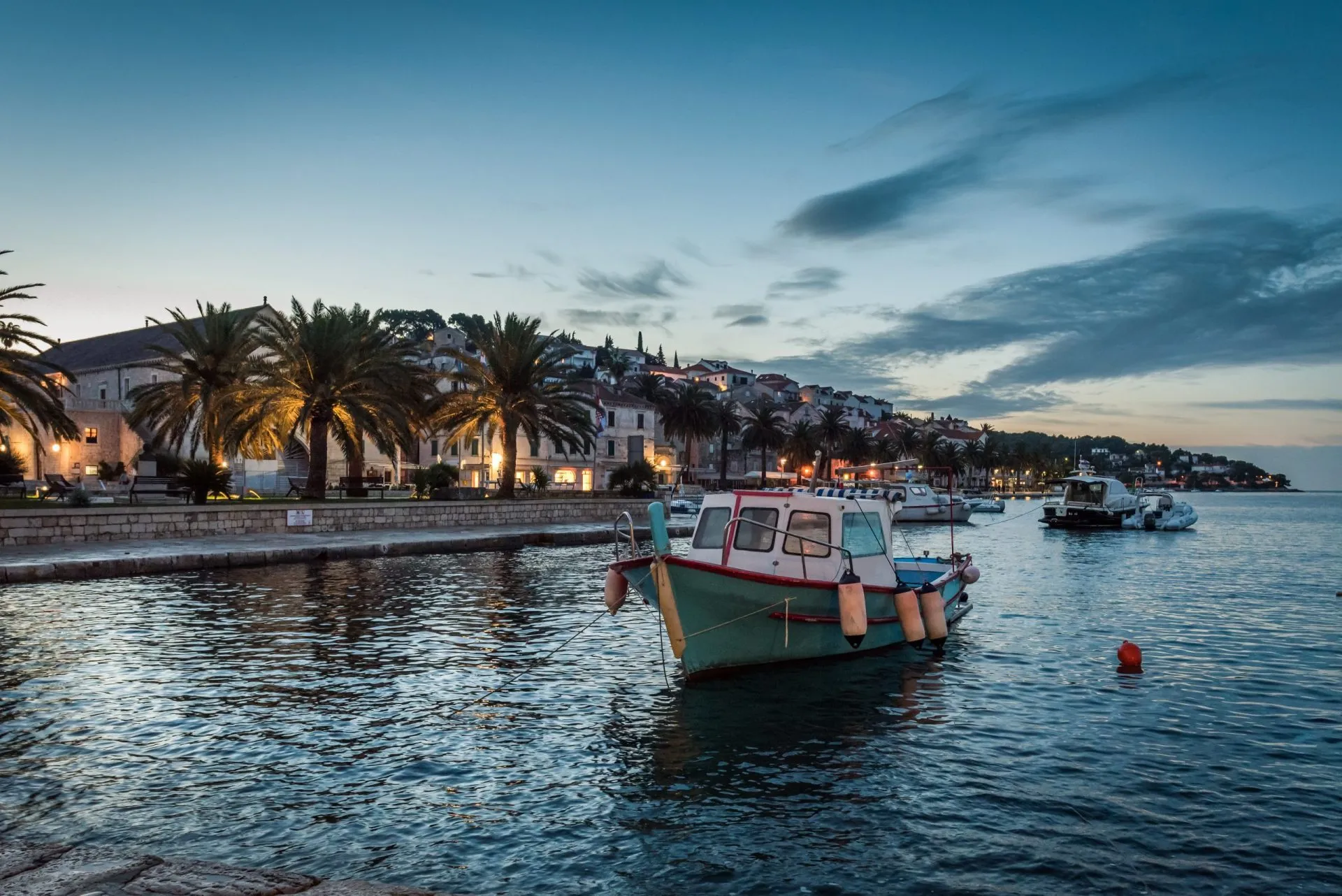
Best of Dalmatia Island Hopping
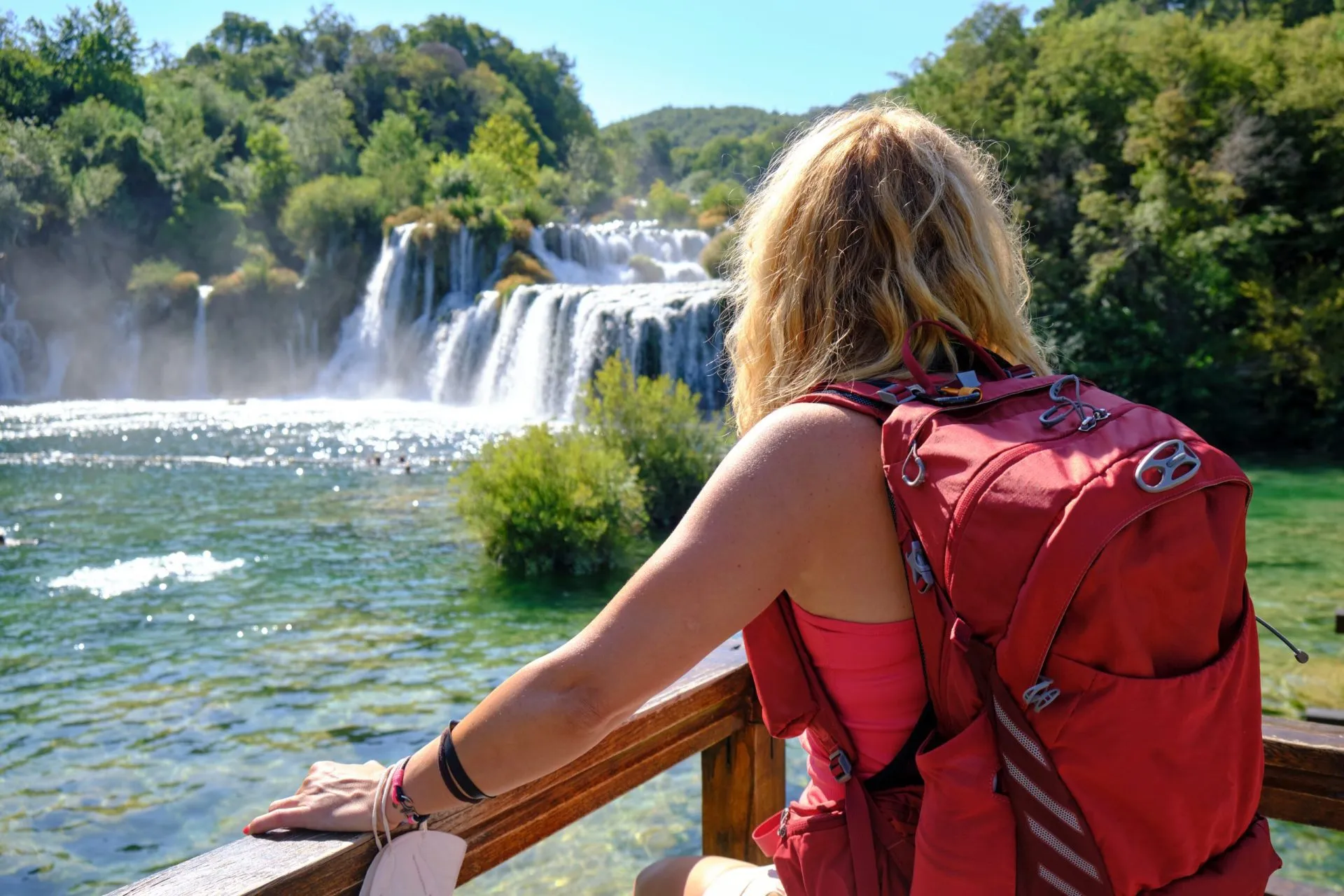
Croatia National Parks Walking Holiday
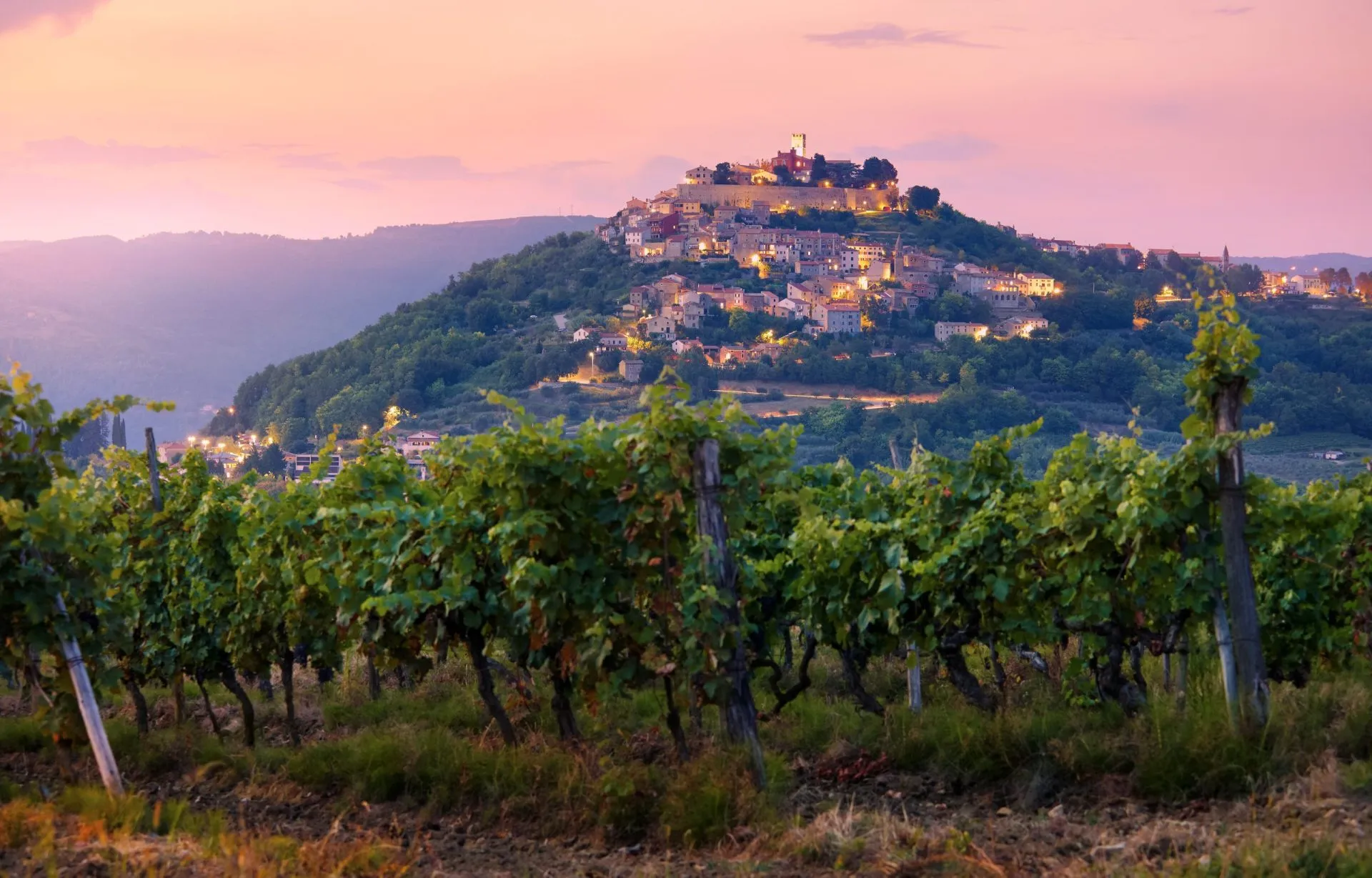
Walk & Wine Istria Holiday
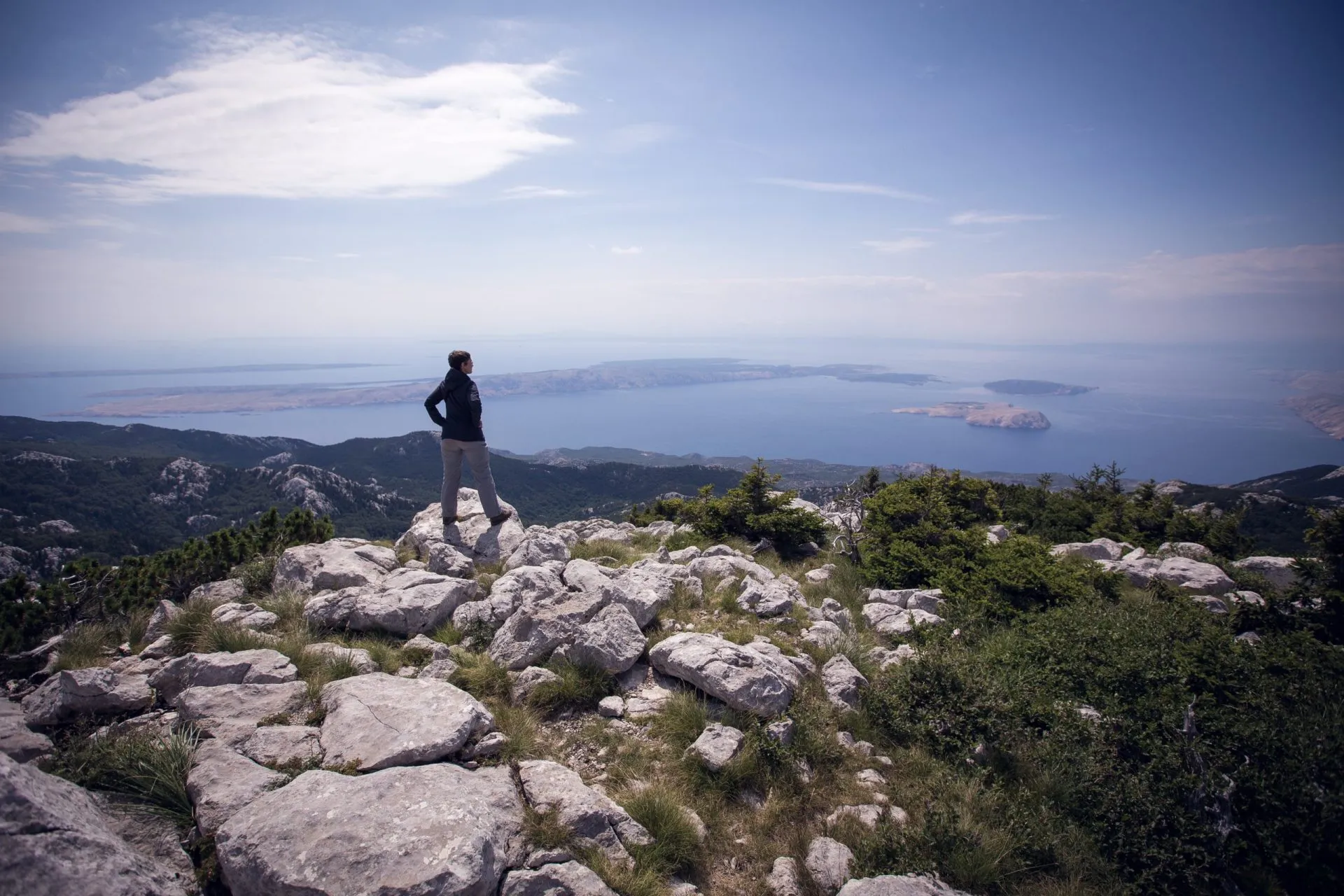
Hut to Hut Hiking Croatia
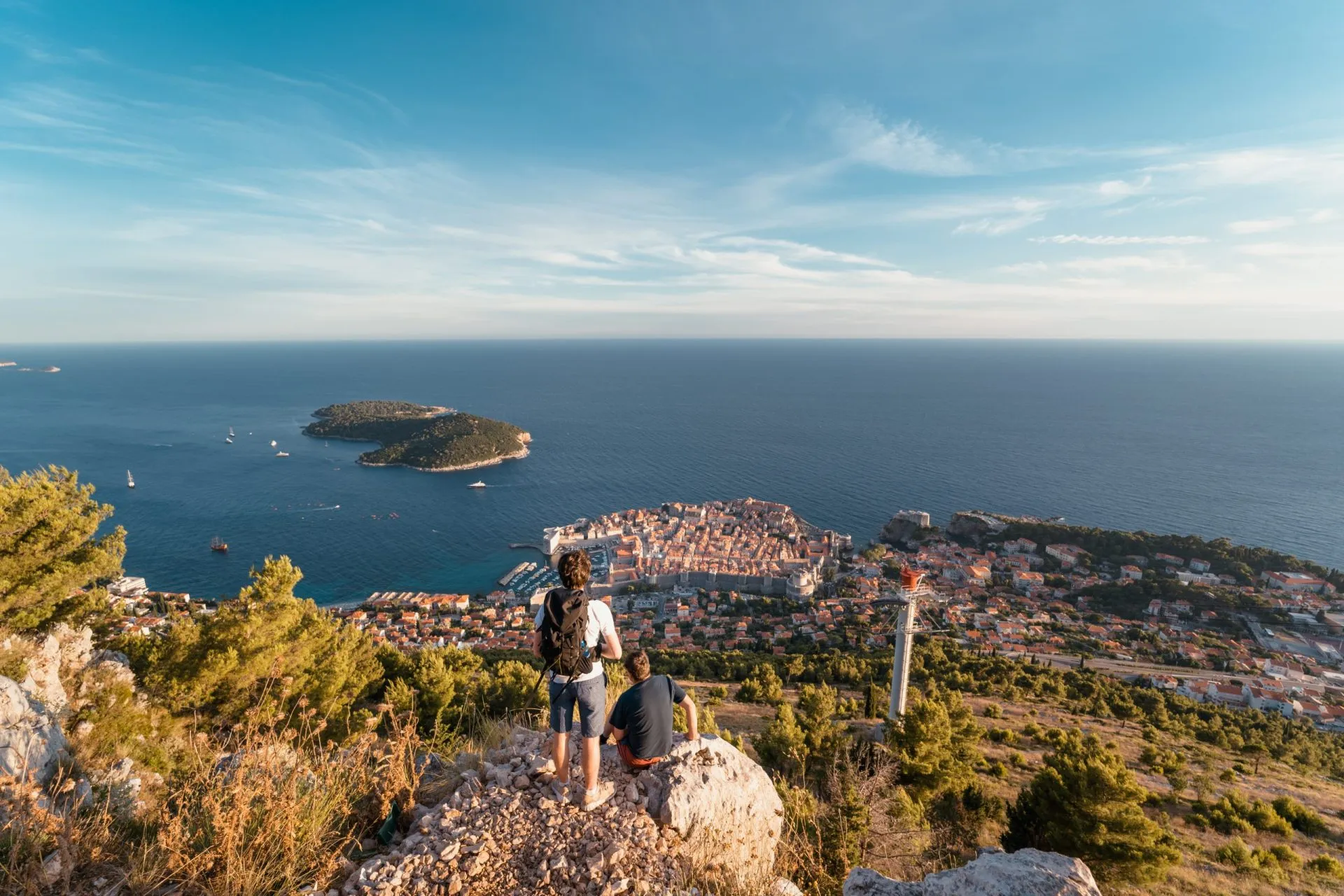
Dubrovnik & Croatia Islands Walking Holiday
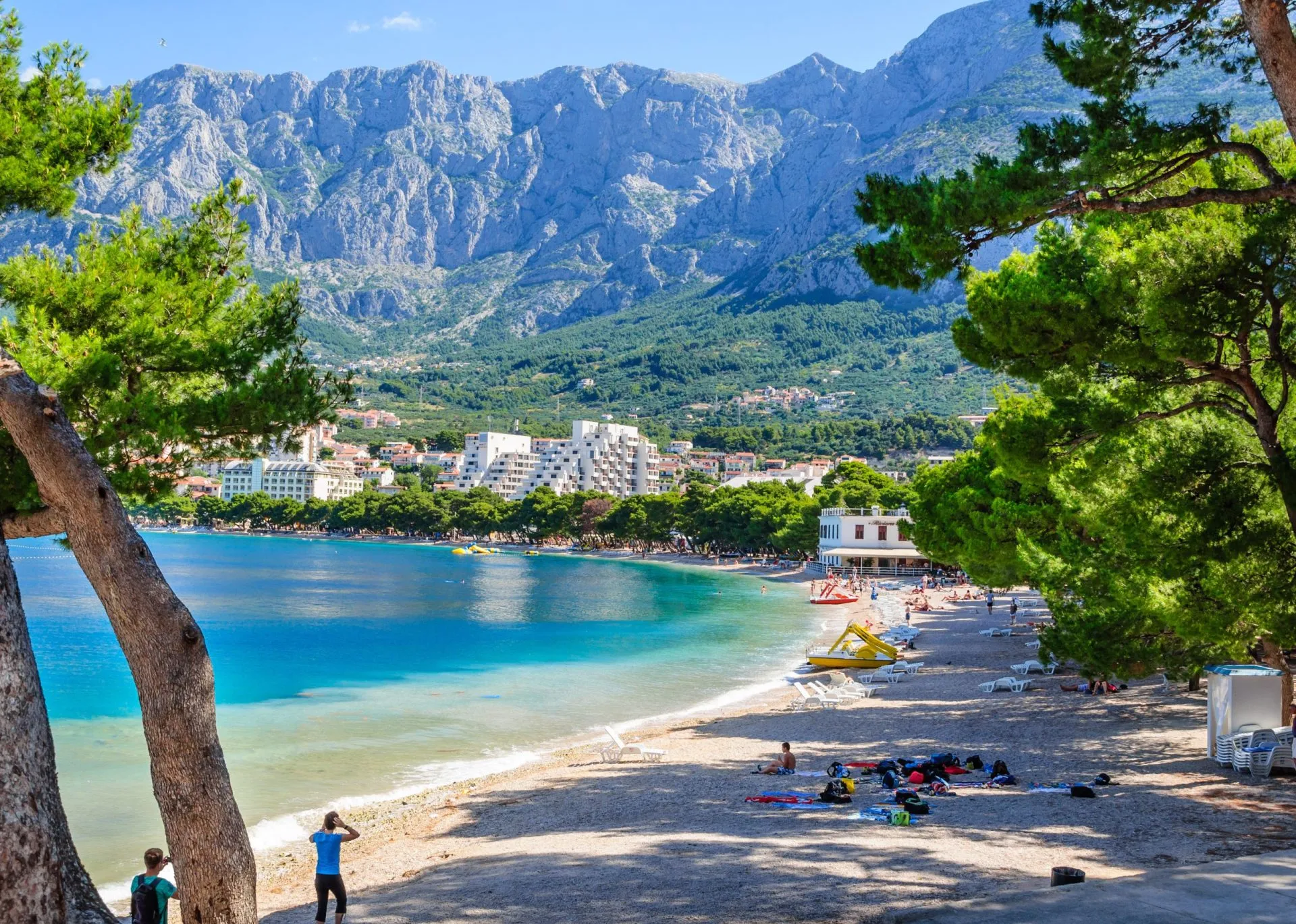
About Walking Holidays Croatia
Welcome to Walking Holidays Croatia, your trusted companion in crafting unforgettable self-guided walking tours in this beautiful country, perched on the east side of the Adriatic Sea.
Our mission is to help you uncover the hidden gems of Croatia , a country renowned for its diverse Mediterranean landscapes, rich history, and vibrant culture.
Whether you’re an avid hiker seeking an adrenaline rush in the Velebit mountains or a leisurely walker looking to soak in the serene beauty of Dalmatia, we have something for everyone . Our hiking holidays are meticulously designed to offer a unique blend of adventure, relaxation, and cultural immersion.
But our tours go beyond just walking. They offer a dive into the Mediterranean culture , giving you a chance to experience the local way of life and savour the delectable cuisine. And of course, take some refreshing swims in the Adriatic in between all that.
With us, you receive a personalised booklet before your trip, filled with recommendations for authentic experiences, a detailed day-by-day itinerary, and comprehensive descriptions of your hikes, complete with GPS routes . We take care of all your accommodation bookings and offer 24/7 support during your walking holiday, ensuring a seamless and enjoyable experience.
So, do you already have a region in mind?
Top Regions for Walking Tours in Croatia
Croatia is a treasure trove of stunning landscapes, each offering a unique walking experience.
Here are some regions that are a must-visit for every hiking enthusiast:
1. Croatian Islands
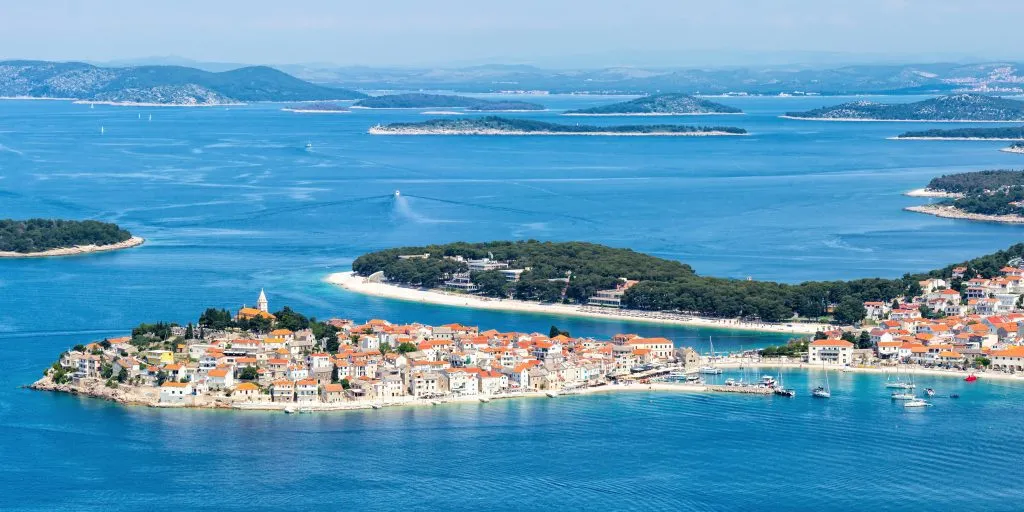
Explore the unspoilt beauty of the islands of Croatia, each with its unique charm and character. An island-hopping walking holiday is the best option to do that.
2. Dalmatia
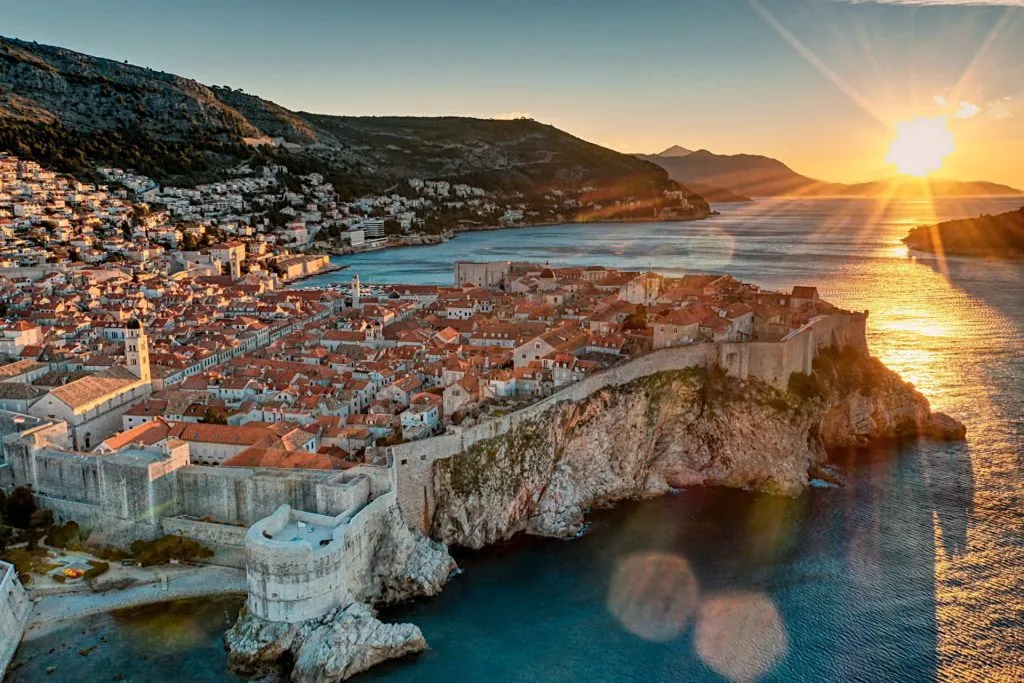
From the azure waters of the Adriatic Sea to the ancient city walls of Dubrovnik, Dalmatia is a paradise for leisurely walkers, and the best base from where to explore it is Dubrovnik .

Known as the “Tuscany of Croatia”, Istria offers a blend of rolling hills, vineyards, and medieval hilltop towns. You can explore this landscape on our Walk & Wine Istria Holiday .
4. Croatian National Parks
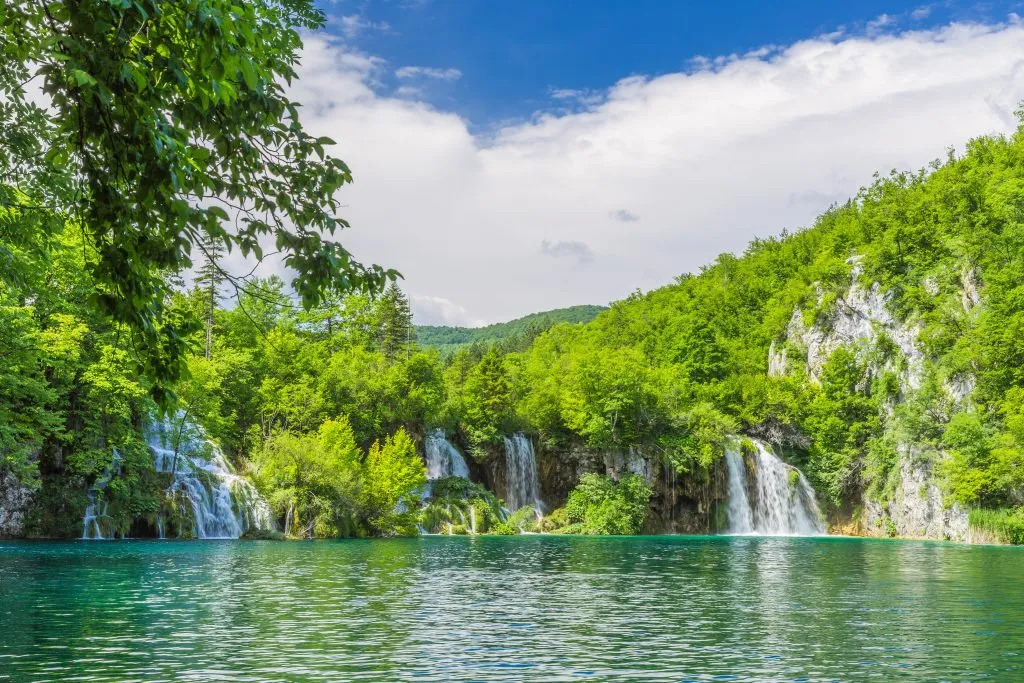
Experience the raw beauty of Croatia’s national parks, home to pristine lakes, cascading waterfalls, and impressive rock formations. Go on a walking holiday across multiple Croatia National Parks and explore the best of them.
Why is Croatia a Great Walking Holiday Destination?
Croatia, a gem nestled in the heart of Mediterranean Europe , is a walking holiday destination like no other. It’s where the azure waves of the Adriatic Sea meet the rugged charm of off-the-beaten-path trails, creating a harmonious blend of relaxation and adventure.
Imagine walking along the sun-kissed coastline , the sea breeze gently tousling your hair, only to find yourself amidst the tranquillity of a forest trail the next moment, or a rugged karst canyon . Croatia offers this unique duality, making it an ideal destination for those who seek the thrill of exploration without straying too far from the comforts of a classic seaside vacation.
But the allure of Croatia extends beyond its stunning landscapes — foodies will love it! The local cuisine is a delightful medley of Mediterranean flavours , where every meal is a celebration of fresh seafood, locally grown produce, and exquisite wines.
So, whether you’re navigating the winding trails of Istria, exploring the historic streets of Dubrovnik, or savouring a glass of wine as the sun sets over the Adriatic, a walking holiday in Croatia is an experience that engages all your senses.
HASSLE-FREE
Book with confidence, tried & tested adventures, unbeatable support, things to know.
It is what the name suggests, there is no guide that is breathing down your neck. As provided by us, it is a unique and flexible vacation option that allows you to explore the picturesque landscapes of Croatia at your own pace.
We take care of all the logistical details for you — we book your accommodations , supply a comprehensive itinerary with descriptions of routes , highlights along the way, and any other vital information you might need for your adventure. This itinerary is accompanied by GPS navigation via an easy-to-use app to ensure you can explore freely without worrying about getting lost. And to provide you with peace of mind, we also offer 24/7 support throughout your holiday, ensuring assistance is always just a call away if you need help during your journey.
This setup allows you to enjoy the beauty and culture of Croatia while maintaining a certain degree of freedom and flexibility in your schedule, making for a truly personalised travel experience.
Ideal times to embark on a walking holiday along the Croatian coast and islands are the shoulder months of May, June, September, and October . During these periods, the climate is optimal for hiking and exploring stunning coastal landscapes. If you’re a fan of swimming, the summer months provide warmer sea temperatures for a refreshing dip. However, the higher temperatures during these months can make walking more strenuous.
Absolutely, we understand that everyone has unique dietary needs and we aim to cater for them. Most places we visit can accommodate a variety of dietary restrictions. However, it is crucial that you inform us of any food restrictions or allergies in advance so we can ensure your needs are met throughout your holiday.
Many of our holidays are suitable for children. However, certain more challenging trips, such as those involving mountain hiking, may require children to be physically prepared and sure-footed. For the safety and enjoyment of younger participants, we recommend they be at least eight years old to join the tours.
Our walking holidays are crafted to accommodate a wide range of fitness levels. We offer flexibility to adjust the tours as needed. While you do not necessarily need prior hiking experience, it’s beneficial to be sure-footed and equipped with sturdy hiking shoes. The only exception is our Hut to Hut hiking holiday, which is more demanding but fully guided, ensuring a safe and enjoyable experience for all participants.
We arrange for our guests to stay in a mix of hotels and private accommodations, depending on the specific holiday and the region of Croatia being explored.
Yes, we strongly recommend booking in advance. Early booking not only secures your spot but also provides you with a wider range of options. Please note that if you book just prior to or during the season, we may not be able to guarantee availability in certain hotels and apartments.
Croatia is well-connected by air, with international airports in major cities like Zagreb, Split, Dubrovnik, and Pula. Alternatively, you can also reach Croatia by train or bus from various European cities, or by car if you’re touring from a neighbouring country. If you’re travelling from a further distance, connecting flights via major European airports are usually available.

- Terms of Service
- Cookie Policy
- Waiver of liability
This website uses cookies.

Cookie Settings
Choose which cookies you want to allow. You can change these settings at any time.
These cookies are essential for the website to function and cannot be switched off.
We use these cookies to analyze how our visitors use the website and monitor site performance.
These cookies are used to personalize ads and content based on your interests.
- Self Guided Tours
Croatia Self-guided tours and trips 2024/2025
The best self-guided and independent tours in Croatia. We currently offer 45+ Croatia tours and trips that are self-guided with varying trip durations from 3 to 15 days. Self-guided and independent tours can be a great way to discover Croatia although potential risks associated with not having a guide always needs to be considered. See our self guided tours to Croatia or small group tours to Croatia if you've decided the risks were too high.
Showing 46 Trips in Croatia with 8 Reviews

Croatia Sailing Adventure - 8 days

Best Of Croatia 11 Days, Self-drive

Croatia Island Hopping, 11 Days

Adriatic Explorer from Dubrovnik Premium - 8 days

Croatia Island Hopping, 15 Days

Adriatic Explorer from Split Premium - 8 days

Sailing Split Premium - 8 days

Croatia Express, Self-drive

Croatia Island Hopping, 8 Days

Grand Tour Of Croatia 8 Days, Self-drive

Escape To Split 3 Days, Private Tour

Sailing Split Premium Plus - 8 days

Coastal Croatia: Pula to Porec Cycling

Escape To Pula 3 Days, Private Tour
Croatia self guided tour reviews.
- Thomas Robert Keller
- Jessy and Rob
- Sarah Rosales
We use cookies to analyze traffic and give you personalized content and ads. It's an essential part of giving you a great site experience. Click on the 'Accept' button if you agree with our use of tracking and analytical cookies. Please refer to our Cookie Policy for more information.
- Croatia Tours
- Croatia Eco Tours
- Croatia Solo Trips
- Croatia Tours for Young Adults
- Croatia Tours for Senior Citizens
- Croatia Family Tour Packages
- Croatia Group Tours
- Croatia Guided and Escorted Tours
- Croatia Budget Tours
- Croatia Travel Deals
- Croatia Small Group Tours
- Croatia Last Minute Deals
- Croatia Private Tours
- Croatia Tailor-made Vacation Packages
- Croatia Luxury Tours
- Croatia Customized Tours
- Croatia Tour Operators
Popular Destinations
- Dubrovnik Tours
- Split Tours
- Zagreb Tours
- Zadar Tours
- Opatija Tours
- Plitvice Lakes National Park Tours
- Trogir Tours
- Korcula Island Tours
- Sibenik Tours
- Osijek Tours
Popular Activities
- Active and outdoor Tours
- Adventure Tours
- Art and architecture Tours
- Beach Tours
- Bicycle Tours
- Chill out Tours
- City sightseeing Tours
- Cruise Tours
- Cultural, religious and historic sites Tours
- National parks Tours
- Natural landmarks sightseeing Tours
- Sailing, yachting and motor boating Tours
- Self-drive or vehicle rental Tours
- Sightseeing Tours
- Trekking and Hiking Tours
- Walking Tours
Upcoming Departures
- Summer tours
- Spring tours
- Winter tours
- August 2024 tours
- September 2024 tours
- October 2024 tours
- November 2024 tours
- December 2024 tours
- January 2025 tours
- February 2025 tours
- March 2025 tours
- April 2025 tours
- May 2025 tours
- June 2025 tours
- July 2025 tours
- August 2025 tours
- September 2025 tours
- October 2025 tours
- November 2025 tours
- December 2025 tours
- April 2026 tours
- May 2026 tours
- June 2026 tours
- July 2026 tours
- August 2026 tours
- September 2026 tours
- October 2026 tours
Trips per Duration
- 4 days tours
- 5 days tours
- 6 days tours
- 1 week tours
- 8 days tours
- 9 days tours
- 10 days tours
- 11 days tours
- 12 days tours
- 2 weeks tours
- 15 days tours
Trending Travel Guides
- Best Time To Visit Croatia
- Great Croatia Itineraries: How Many Days to Spend?
- Croatia in August: Weather and Travel Tips for End of Summer
- Croatia in January: Weather, Tips and More
- Croatia in September: Weather and Travel Tips
- Croatia in December: Weather, Christmas and More
- Croatia in November: Weather and Travel Tips for Start of Winter
- Croatia in October: Travel Tips for Perfect Weather
- Croatia in March: Weather and Travel Tips
- Croatia in May: Weather and Travel Tips
- Croatia in April: Fewer Crowd and Better Rates
- Croatia in February: Weather, Carnivals and Travel Tips
- Croatia in July: Weather and Travel Tips For Summer
- Croatia in June: Weather, Tips & Water Sports
- Croatia in Winter: Wonders of Snowy Weather
- Summer in Croatia: Perfect Weather & Enchanting Experiences
- 10 days in Croatia: Top 3 Recommendations
- One Week in Croatia: Top 4 Recommendations
- Top 10 Places to Visit in Croatia
- Best Things to Do in Croatia
- 4 Days in Croatia: Top 3 Recommendations
- 5 Days in Croatia: Top 3 Recommendations
- 2 Weeks in Croatia: Top 4 Recommendations

Croatia Hiking Tour from Split to Dubrovnik (Self-Guided)
Self-guided hiking tour in croatia overview.
Hike along the Dalmatian Coast in Croatia on our 8-day self-guided hiking tour from Split to Dubrovnik. You’ll visit some of Croatia’s most historic city centers, including Split and Dubrovnik, plus destinations such as Hvar and Korcula and the lesser-known areas of Supetar, Vela Luka and Pomena (Mjet), where you’ll also hike to a national park. This Croatia walking holiday is a unique way to experience the community, camaraderie and excellent cuisine while hiking with stunning sea views through olive groves and vineyards and Meditteranean forests and other magnificent landscapes. We’ll provide transportation and guidance along the way, provide GPS for your hikes and multiple options for hikes on several days of your tour so that you immerse yourself in Croatia at your own pace. This is a great walking tour in Croatia for travellers who want a mix of hiking, sightseeing, and time to enjoy the local culinary wonders that Croatia has to offer.
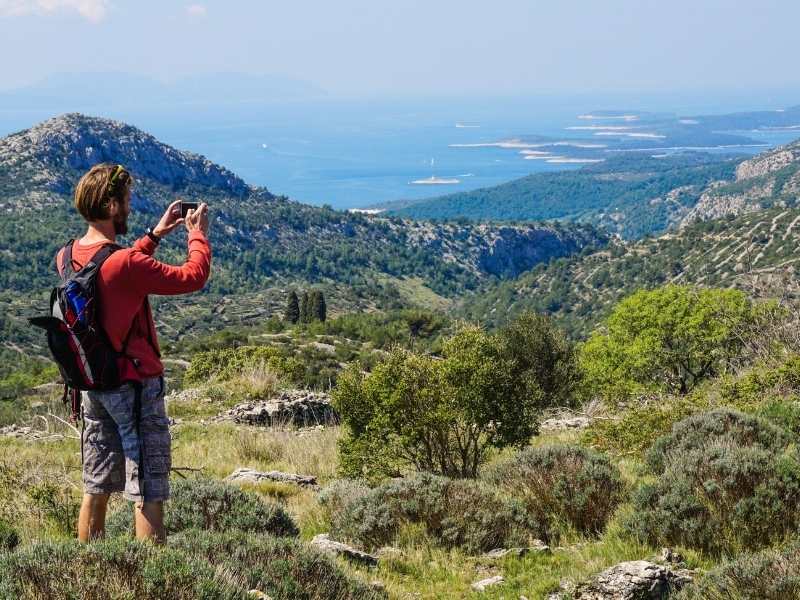
HIGHLIGHTS OF YOUR SELF-GUIDED HIKING TOUR IN CROATIA: FROM SPLIT TO DUBROVNIK
✔ Hike through lesser-known villages and towns as you discover the beautiful Dalmatian coast.
✔ Explore historic places, including the 3000-year-old village of Skrip (on selected hikes).
✔ Enjoy stops at beautiful sandy beaches and take a dip in the clear blue Adriatic sea.
✔ Visit Mljet National Park, the largest protected marine area in the Adriatic.
✔ Discover Kočje, where you will hike through a labyrinth of uniquely shaped dolomite rocks overgrown with ivy.
8-DAY SELF-GUIDED HIKING IN CROATIA ITINERARY
Day 1: Split Day 2: Split to Supetar Day 3: Split – Hvar Day 4: Hvar – Vela Luka Day 5: Vela Luka Day 6: Vela Luka – Korcula Day 7: Korcula – Pomena (Mljet) Day 8: Pomena (Mljet) – Dubrovnik

Day 1: Arrive and Hike Up to Marjan Hill in Split

You’ll enjoy your first day with an easy exploration hike to Marjan Hill which offers the best view of Split. The views far surpass the 5 km and 200-meter climb. It’s loved by locals and visitors alike. The shade of the black pine trees and surrounding Mediterranean plants make it a perfect spot for a picnic. Be sure to reward your efforts by checking out the beaches, some of the finest in all of Croatia.
If you arrive early enough we’ll greet you at your hotel for a friendly in-person briefing. We’ll also give you your roadbook, vouchers and tickets. If you arrive late, we’ll leave this at the reception of your hotel.
- Accommodation: 3 or 4-star hotel in Split (depending on which option you choose)
- Hiking Distance: 5.1Km or 6.6Km
- Ascent: Between 200m and 250m
- Hiking Time: Between 1 and 2.5 hours
- Extras: airport pick up and transfer to your hotel
- Extra hotel night in Split so that you can further explore the city
Day 2: Take the Ferry from Split to Supetar on Brac Island

You’ll be picked up and driven to the ferry after breakfast, where you can enjoy the sea views on the 50-minute journey to Supetar on the island of Brač. Supetar is the largest town on the island, with just 3200 inhabitants. Itt will take you back to Roman times. You’ll find yourself surrounded by “villae rustice” and remains of a mosaic located next to the parish church dating from the 6th century. Another highlight is the Church of St. Mary of the Annunciation from the 18th century with a beautiful bell tower and a museum. You’ll love exploring the cobble-stoned streets and romantic squares “pjacete.” Supetar is one of the most popular places on the island and offers numerous restaurants and traditional taverns for you to enjoy local Mediterranean cuisine.
You’ll have a choice of 3 different hiking routes, so you can choose an easy, moderate or challenging one.
- Hiking Distance: 4.7Km 16.9Km
- Ascent: Between 50m and 540m
- Hiking Time: Between 1 and 5 hours
- Moderate Route: Hike from Supetar to Skrip. From Skrip, take a taxi back to Supetar. (Estimated extra cost €13-€15)
- Challenging Route: Round hike from Supetar.
When finished exploring Brac, you’ll take the return ferry to Split in the late afternoon, where you’ll spend the night.
Day 3: Split- Hvar
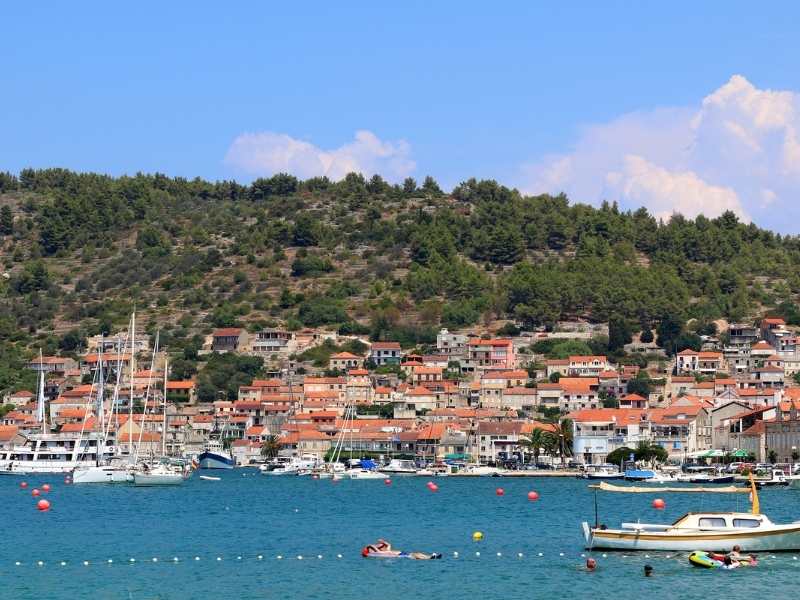
The port and resort town of Hvar (population 4251) gained glory and power during the Middle Ages as a significant port within the Venetian Naval Empire.
Today it’s one of the most popular destinations in the Dalmatian Riviera. It’s often described as a fairytale island, it’s renowned for its unique fusion of luxurious Mediterranean nature, rich cultural and historical heritage, Venetian architecture, and mild climate.
You’ll have a choice of three different hiking routes, each starting from the central square of Hvar Town.
- Hiking Distance: 10.9 km or 19.2 km
- Ascent: Between 295m and 680m
- Hiking Time: Between 2 and 6 hours
- Moderate Hike: Round hike from Hvar town.
- Challenging Hike: Hike from Hvar town to Stari Grad. Transfer back by bus (estimated cost €4) or by taxi (estimated cost €40).
You’ll spend the night in Hvar.
Day 4: Hvar- Vela Luka

Day 5: Vela Luka

- Hiking Distance: 4.6Km or 16.5Km
- Ascent: Between 170m and 630m
- Hiking Time: Between 1 and 8 hours
- Moderate Hike: Round hike from Vela Luka.
- Challenging Hike: Round hike from Vela Luka.
Day 6: Vela Luka- Korcula
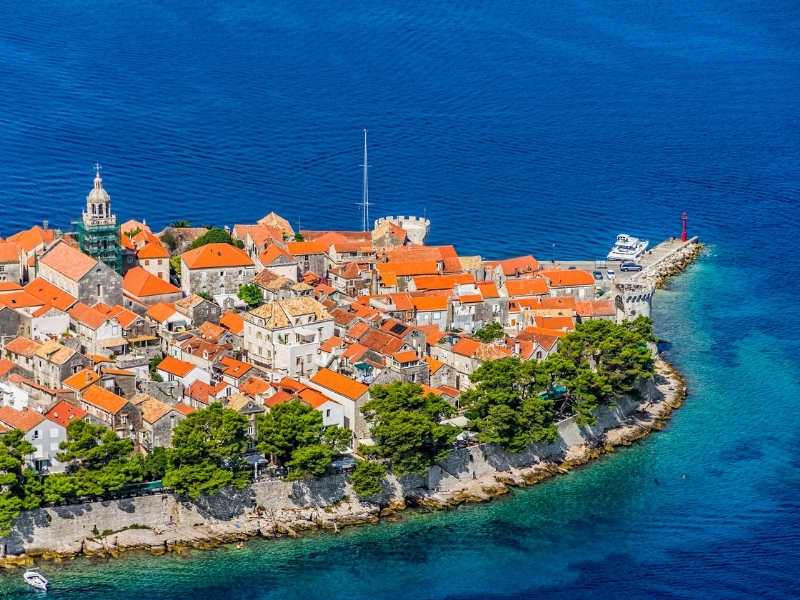
Korcula Town is the main town on the island, with a population of about 3000 inhabitants. The main feature is Korčula Old Town. Here you’ll find a medieval walled city with towers. It’s positioned on an oval-shaped swelling of land pointing deep into Pelješac Channel. It was ingeniously designed with grooved narrow streets that branch off from the main street, resembling a fishbone that reduced the impact of the wind and sun, providing shelter for its inhabitants.
You’ll do a moderate hike in Korcula starting from the city center.
- Hiking Distance: 10.8Km
- Ascent: 330m
- Hiking Time: Between 3 and 5 hours
- Moderate hike from Korcula town. You can shorten the hike to spend more time at Kocje or in Korcula town if you start or end your route from Zinovo Prvo Selo village. You can use a taxi to reach it (estimated cost €20).
Day 7: Korcula- Pomena (Mljet)

The island of Mljet is Croatia’s greenest island covered in Mediterranean vegetation and forest. It’s also one of Croatia’s most beautiful islands. There’s also a national park (one of eight in Croatia) on the western part of the island.
You’ll also find olive groves and vineyards on this gorgeous green island. Be prepared for an incredible fusion of silence, scents, tasty sensations.
You’ll explore Mljet with a moderate hike route that starts from Pomena and leads you to the national park to two salted lakes – Veliko and Malo Jezero, which are favourite swimming spots. You’ll also find an old Benedictine monastery on St Mary’s Island in the middle of Veliko Jezero Lake.
- Hiking Distance: 14.7Km
- Ascent: 550m
- Hiking Time: Between 4 and 5 hours
- Challenging hike that starts and ends in Pomena village.
Day 8: Korcula- Pomena (Mljet)- Dubrovnik

Your tour ends when you arrive in Dubrovnik since our clients have different plans from staying and exploring for a few more days or flying the same day.
We’re happy to assist you with booking additional services in Dubrovnik, such as accommodation, transfer from the ferry port, or to the airport, or a tour of the city, or you are free to book independently.
GETTING TO CROATIA
Your tour starts in Split and finishes in Dubrovnik, so you can fly to either airport of your choice. You can get between Split and Dubrovnik by bus (4:15), ferry (4:20 in high season, not available in low season or by plane (55 minutes). Note: Please do not book your flights or make other travel arrangements until you receive an email from us notifying you that all your accommodation has been confirmed. This normally takes 5 business days or less.
PRICING AND INCLUSIONS Price: Starting from €1441 per person for 2024
WHAT’S INCLUDED
- 7 nights of accommodation in your choice of 3 or 4-star accommodation
- 7 breakfasts
- luggage transfer
- welcome briefing
- GPS tracks (for you to upload to your phone) and a detailed Road Book with instructions
- ferry tickets
- all ground transportation mentioned in the itinerary
- ground transportation to starting points of easy routes in Road Book
- 24/7 emergency hotline
WHAT’S NOT INCLUDED
- Travel insurance that covers you for this tour and includes pandemic, emergency evacuation and hospital care in the unlikely incident that you get injured. HeyMondo insurance covers this, which is why we recommend it. Plus, you’ll get a 5% discount for being a Monkeys and Mountains reader.
- meals not noted in the itinerary
- optional tours/services
- personal expenses
- travel insurance
- flights accommodation in Dubrovnik on the last day
OPTIONAL EXTRAS
- ground transportation to the challenging hikes listed in the Road Book
- entrance fees to sights and Mljet National Park
- extra night in a hotel in Split to give you more time to explore
- hotel in Dubrovnik on the last day
- kayaking tour
- additional excursions
BOOK YOUR SELF-GUIDED HIKING IN CROATIA TOUR NOW
Thank you for your interest in booking this tour. You’ve made a good choice. Our Croatia Hiking Tour is absolutely stunning, and you can reward yourselves after hiking with a dip in the sea and enjoy the pristine beaches.
Book Your Croatia Hiking Tour With Us & You’ll Get…
✅ Great value for money
✅ Freedom to hike on your own schedule with the people you choose
✅ To avoid the hassles of booking accommodations that have to be booked by phone or email (there’s no central booking system to check availability)
✅ Alternative routes(when available) to make your hike easier when your legs have had enough
✅ Our insider knowledge to reserve the best accommodations based on what’s important to you (i.e. location, comfort, etc)
✅ Tours that are designed by hikers for hikers. We combine our knowledge and experience with our local partners to provide you with an amazing hiking tour.
PHOTOS OF HIKING IN CROATIA

- Trip Finder
- View Catalog
- Subscribe to Newsletter
- Contact/Request Info
- Client Portal
- SUBSCRIBE TO NEWSLETTER

- About Ryder Walker
- About Our Inns
- Meet Our Team
- Guest Reviews
- Special Offers
- Awards & Stories
- Conditions & Policies
- Guided Hiking Tour Schedule
- Easy Going-Moderate Treks
- Moderate-Challenging Treks
- Challenging Treks
- The Dolomites
- Swiss Engadine
- Berner Oberland
- Tour du Mont Blanc
- Switzerland
- Private Hikes
- Self-Guided Tour Schedule
- Easy Going Treks
- Liechtenstein
- Berner Oberland Mini Trek
- Chamonix To Champex Mini Trek
- The Heart of Austria Mini Trek
- Italian Dolomites Mini Trek
- Swiss Engadine Mini Trek
- Telluride Mini Trek
HIKING TOURS IN CROATIA
Croatia is an enchanting nation of historic seafarers, walled fortresses, and white stone landscapes. ryder walker’s croatian hikes explore the coastal national parks of croatia while hopping between a selection of iconic islands off the croatian coast including korčula and pomona .these islands are lost-in-time enclaves of adriatic culture, sporting red slate-roofed buildings, the famous cobalt blue adriatic water, and healthy servings of local seafood. .
Croatian culture is one of the most welcoming in the world. Tourism remains an exciting new possibility for the Croatian people, who, by and large, are thrilled to share their rich history, culinary traditions, and mythos . In Croatia, the surviving brutalist architecture from the Soviet Era sticks out in a striking way against the backdrop of cobalt blue waters and winding beaches. While Croatia itself was considered a largely war-torn country following the conflicts of the 20th century, today the nation has engaged in large scale reconstructions of their historic locations and preservation of the country’s unique coastal-desert biome. Throughout history, dating back even to the seafaring days of the Greeks and Romans, Croatia has been represented as a critical port, and it is easy to see why with the Italian shoreline visible across the Adriatic. Today, Croatian culture involves a hearty dose of beach relaxation, lively nightlife, and a plethora of fresh fish and seafood. Sitting eating a plate of calamari while you listen to the waves and look out at the distant lights of a fishing village on a neighboring island is an experience that can’t be replicated anywhere else in the world.
Ryder-Walker offers both guided and self-guided treks in Croatia. For our guided hikes we offer the Highlights of the Adriatic Trek , which combines the best parts of Croatia with our favourite hikes in Montenegro. Our self-guided hike is the excellent Dalmatian Coast Trek , which gives a comprehensive experience of Croatia. Highlights of these hikes include: the ancient Beech forests of Biokovo and Lovćen National Parks and a distinctly more nautical experience as we board ferries to explore the Adriatic. The islands of Korčula and Pomona cast a distinctive contrast with each other, with a collection of fishing villages straight from the odyssey and beautiful seaside resorts. Finally, our journey finishes in the ancient walled city of Dubrovnik , the shooting location for Game of Thrones’ King’s Landing. The city itself looks no less fantastical than it does in the show, feeling like a direct portal into the past.
Croatia amazed us when we first visited years ago, and the coastal nation continues to impress us year after year. The hiking in the national parks is consistently incredible, with easy to access summits providing stunning views of the entire peninsula. While many may just pass through Croatia on a cruise it is obvious to us at Ryder-Walker that the Croatian people and nature are worth deeper engagement, which we provide with our magnificent Highlights of the Adriatic and Dalmatian Coast Trek.
GUIDED TRIPS
Self-guided trips.
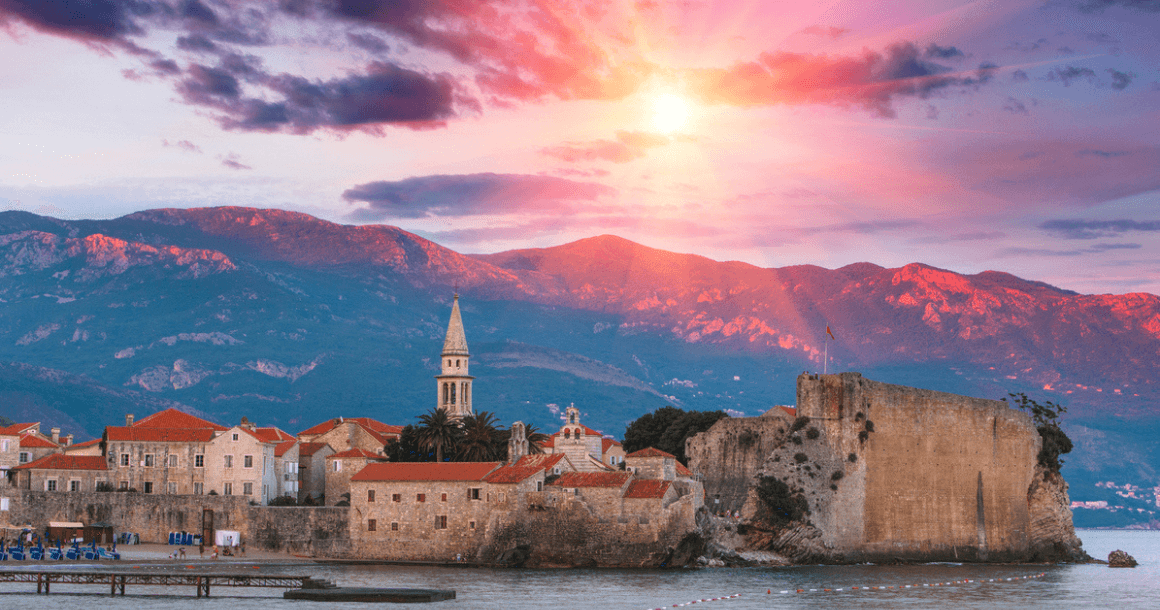
Montenegro and Croatia | Highlights of the Adriatic Coast
Ryder-Walker’s journey along the Dalmatian Coast is an incredible experience visiting the best of the two countries. Starting in the mountains of Montenegro, you will get to explore Montenegro’s world famous national park before continuing towards the coast. While traveling along the coast you will get to experience both the liveliest coastal villages of Montenegro and Croatia while taking excursions...
Guided Tour Date
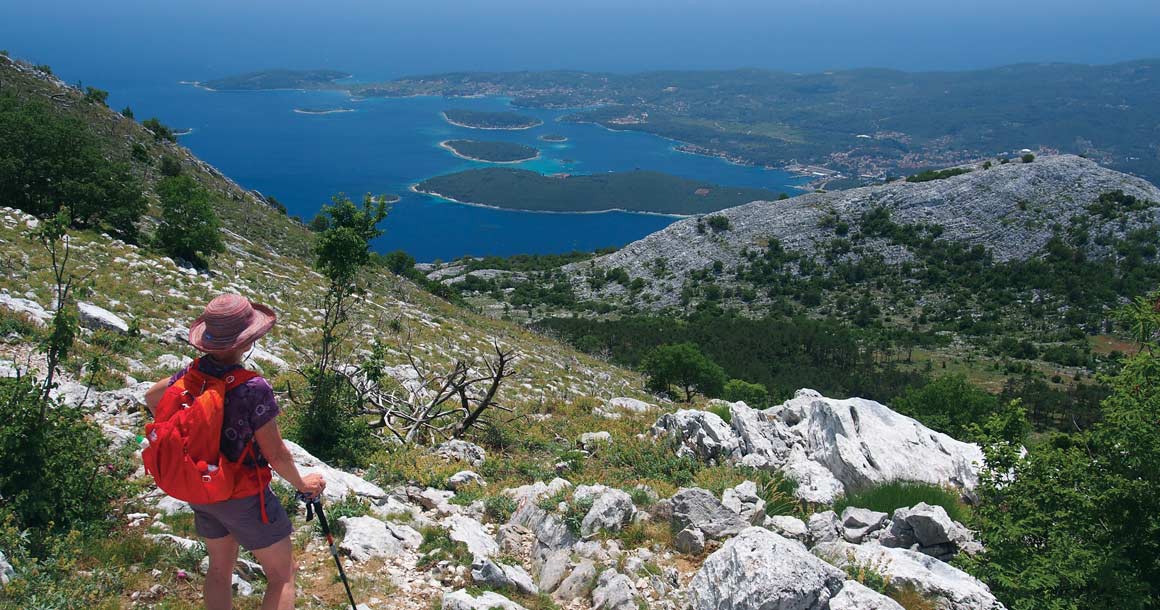
Croatia | The Dalmatian Coast
Welcome to Croatia! Azure, cobalt, indigo — our 8-day self-guided Croatia hiking tour is a celebration of blue skies and pristine waters. The villages are immaculate and the bustle of the beaches and exceptional restaurants, enchanting. The red tiled roofs coupled with the crystal clear sea is pure magic. Most travelers will want to begin their Croatian adventure by arriving...
Self-Guided Tour Date
Hear It From Our Guests
Need some help deciding choose your hiking style , recent posts.

Give the Perfect Ryder-Walker Trek for the Holidays!

The Best Hiking Trips for Foodies
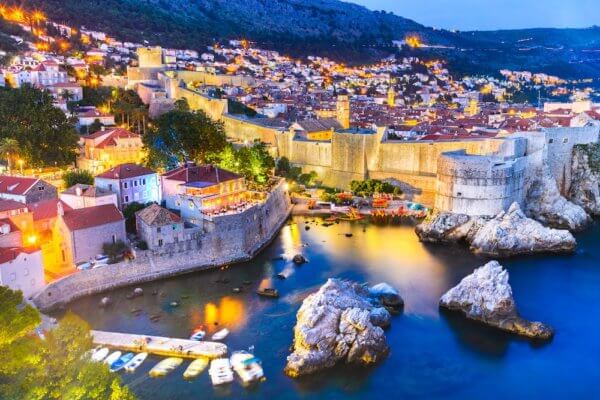
Bucket List Coastal Hiking Trips
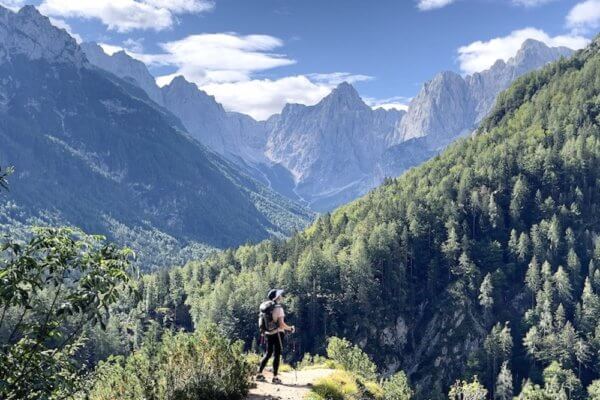
Five Hidden Gem Hiking Treks

Holiday Cookie Recipes from Europe
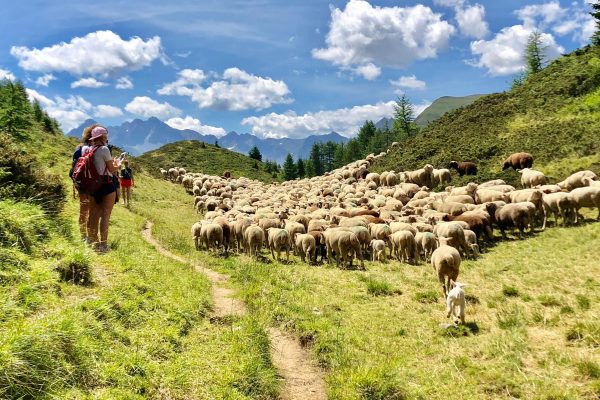
Ryder-Walker’s Best Family-Friendly Hiking Trips
Treks you might like, find your trek.
To provide the best experiences, we use technologies like cookies to store and/or access device information. Consenting to these technologies will allow us to process data such as browsing behavior or unique IDs on this site. Not consenting or withdrawing consent, may adversely affect certain features and functions.
As Seen In:

Jetsetting Fools
Travel Far. Discover More. Spend Less.
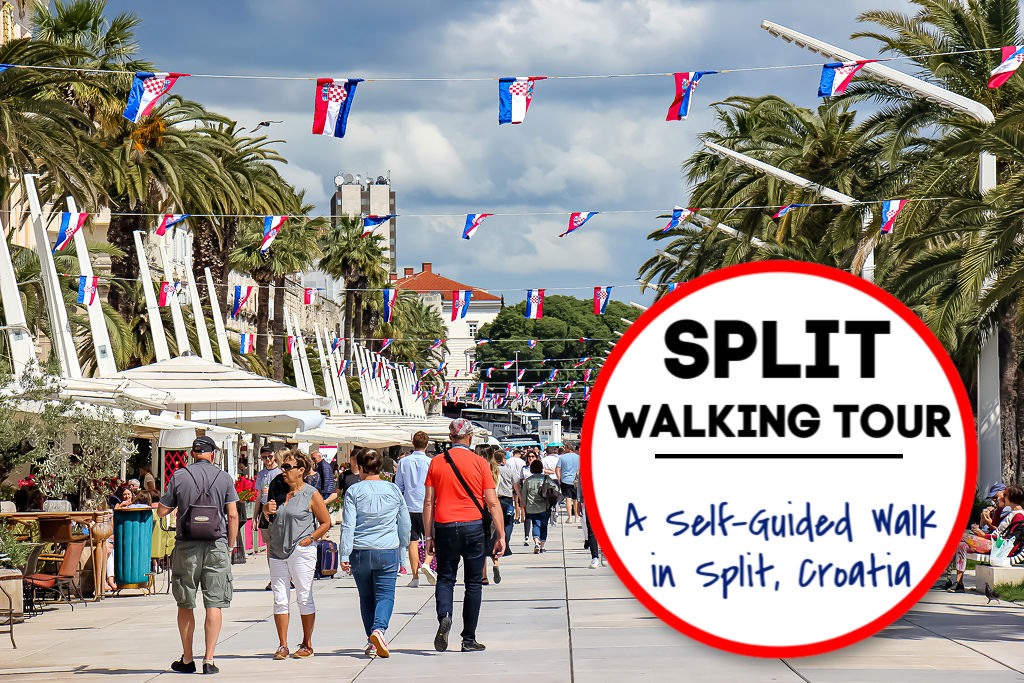
Split Walking Tour: A Self-Guided Walk in Split, Croatia
Welcome to JetSetting Fools, here you will find our best travel tips for destinations worldwide. Some of the links on this site are Affiliate Links and if you use them to make a purchase, we may earn a commission. For more information, read our Disclosure Policy .
The Split, Croatia Old Town is an enchanting web of cobblestone streets that encompasses both Diocletian’s Palace and the adjacent Old City. The picturesque lanes of Split, Croatia lead to historic sights, charming squares and hidden gems. Our Split Walking Tour is an easy-to-follow self-guided walk that features 30 highlights of the ancient city.
Free Walking Tour Split, Croatia
We created our free Split Walking Tour to help other travelers to Croatia discover the city at their own pace – which is exactly how we like to explore. Our tour of Split provides the perfect introduction to the buzzing coastal capital. The tour duration will depend solely on your pace. Many visitors will complete our Split Walking Tour in about 1 hour, but travelers could easily spend 2 hours or more leisurely navigating the lanes.
Our Split walk includes everything you need – sight information, written walking directions, links to locations and a Split City Tour Map marked with all of the sights at the end of the article.
Pro Tip: While exploring Split, it is important have a basic understanding of the layout. The city of Split sits on an east-west peninsula; with the Split Harbor facing south from of the Old Town.
Is There a Guided Split, Croatia Free Walking Tour?
While there are many guided Split Walking Tours, in accordance with city regulations, guides must charge a fee. Therefore, there is not truly a Guided Split Free Walking Tour. Don’t worry though – our Free Self-Guided Walking Tour Split features the absolute best of the city!
For travelers interested in guided tours, we highlight the best tours for Split walks and day trips a bit later – as well as other tips for your Split trip.
{Use our guide of Things To Do in Split for more free Split sightseeing!}
Walking Tour Split, Croatia: What You Will Need

Before you begin your Self-Guided Walking Tour of Split, Croatia, we have a few tips for things you will need for your walk.
Walking Shoes for Split Old Town Walking Tour
While the Split Old Town is flat, the stone lanes – polished with millions of footsteps – can be slick and sometimes uneven. We recommend wearing a comfortable pair of non-slip travel shoes for your Split tour. I like wearing these shoes by Columbia , while Kris wears Merrell shoes.
WiFi for our Split, Croatia Self Guided Walking Tour
To use our Free Walking Tour of Split – and the map links provided – you will need a WiFi connection during your walk. We travel with a GlocalMe WiFi Mobile Hotspot, which allows us to connect up to 10 devices and it doubles as a portable charger . However, the best feature is that we can purchase data packages online, rather than wasting time buying a local SIM card.
Travel Camera for Your Walking Tour Split, Croatia
Split is incredibly photogenic! We recommend using a real travel camera to capture the sights. We use a DSLR Canon Rebel with an everyday 18-135mm lens – which comes with loads of accessories and is a great beginner camera for budding photographers!
Weather Gear & Day Pack for Walking Tour Split, Croatia
In the summertime, Split is sunny and very hot. Don’t forget sunscreen , a hat and sunglasses . A refillable water bottle is a good idea, too – and these collapsible water bottles are perfect for travelers. Outside of the summer months, Split can be windy, rainy and cool. Bring a travel umbrella or packable raincoat , just in case! You will also want a great day bag to organize all of your essential, everyday travel items .
SPLIT WALKING TOUR: Free Self-Guided Walk

Now that you are ready, it’s time to start the best walking tour in Split! Lace up your shoes and have your camera ready. Begin your Self-Guided Walking Tour of Split at the 3D bronze Split City Model, Maketa Grad Split.
#1 Maketa Grad Split: 3D Split City Model

MAP . An ideal place to start walking tours in Split, the Maketa Grad 3D city model provides an overview of Diocletian’s Palace and the Split Old Town. The model shows the clear outline of the palace (the bell tower is at the center) and the city that grew to the west of it.
The map model sits at the east end of the Riva, the waterfront, café-lined pedestrian zone that is frequented by visitors and locals alike. We talk more about the Riva later, as you will end our Split walking tour at the opposite end.
Walking Directions : Looking at the map with the Riva in front of you, walk straight ahead across the Riva to the inconspicuous Bronze Gate, which is the entrance into Diocletian’s Palace Basement.
#2 Bronze Gate (Mjedena Vrata)

MAP . The Mjedena Vrata Bronze Gate is the south entrance into Diocletian’s Palace. One of the four gates into the Roman palace (and the least adorned), Bronze Gate opened directly onto the sea, before land reclamation created the Riva. Diocletian used this gate to enter the palace by boat (which was also ideal for a quick escape in the case of invaders from land).

Before walking through the gate, look up at the stone walls that extend over the tops of the shops. These are the original walls of Diocletian Palace.
Walking Directions: Walk through the gate into the dimly lit space. You are now standing in the Diocletian’s Palace basement.
#3 Diocletian’s Palace

MAP . A UNESCO World Heritage Site, Diocletian’s Palace is an absolute highlight of Split walking tours. The palace was built in the 4th century and is one of the best-preserved palaces of Late Antiquity. Emperor Diocletian built the residence as his seaside retirement home, where he lived out his last years.
The palace, however, was eventually left in ruins. In the 7th century, citizens of nearby Salona found refuge in the palace walls, escaping the invading Slavs. The new residents altered the palace interior and transformed it into a city within itself. The remains of the palace are merely a frame of what it once was (yet, nonetheless impressive).

The palace basement, where you are standing now, was used for many years as a dumping ground for refuse. Fifty years ago, archaeologists dug through the garbage and started to put together pieces of the past. The well-preserved basement can be explored (with a ticket), but for now continue to the next sight on our Split Self-Guided Walking Tour.
{Read more about the palace in our blog post: Exploring Diocletian’s Palace }
Walking Directions: Walk straight through Diocletian’s Palace Basement, passing the vendors that sell artwork and souvenirs. Ascend the steep staircase and step into the Peristil. Walk to middle of square and turn around to face south toward the Palace Basement stairs you just walked up.
#4 Peristil Split

MAP . A Split, Croatia must-see, the Split Peristil is the center of Diocletian’s Palace. The grand columned square is where loyal subjects would gather to hear Diocletian speak from the Prothyrum balcony. From the square, take in the ancient sights that surround you.
Note: Tickets are required to enter the next two sites on our Split Walking Tour, but they are worth looking at from outside, too. You can buy tickets and visit the sights now or circle back to this point at the end of the walk.
Walking Directions: From the middle of the Peristil, looking south (at the stairs you just climbed from the basement), turn to your left to see the St. Dominus Cathedral and Bell Tower.
#5 St. Domnius Cathedral and Split Bell Tower

MAP . To your left (east) is the Saint Domnius Cathedral. The structure was originally built as a mausoleum to host the remains of Diocletian after his death. After the Fall of Rome, the building was converted into a church. The main altar now stands where Diocletian’s tomb once was. The ornate bell tower was not added to the church until the 13th century…but it took 300 years to complete.
Pro Tip : Visitors can visit the church interior and bell tower (which provides stunning views over the city of Split and the harbor) for a small fee. Tickets are available from the office across the Peristil from the church entrance.
Walking Directions: Turn your back to the church entrance and walk toward the narrow passage (to the right of the church ticket office). Walk the length of the passageway to Jupiter’s Temple.
#6 Jupiter’s Temple

MAP . Down the narrow passageway to the west, opposite the church, is the Temple of Jupiter, which dates to the 4th century. It, too, was converted into a church in the 6th century. The headless sphinx that sits at the entry was one of several Egyptian sphinxes that Diocletian used to decorate the palace (another can be seen under an arch in front of the Dominus Cathedral).
Pro Tip : Visitors can go inside with a ticket.
Walking Directions: Looking up at Jupiter’s Temple from the base of the stairs, turn left to find an extremely narrow lane.
#7 Let Me Pass Lane (Pusti Me Proc)

MAP . The narrow lane next to the temple is called, Pusti Me Proc – or Let Me Pass. While many claim that it is the narrowest street in the world, it is definitely the most constricted alleyway in Old Town Split.
Walking Directions: To continue your Palace walking tour, retrace your steps from Let Me Pass Lane back into the Peristil Square and turn right (south). Rather than walking down the steps into the basement, walk up to the Prothyrum balcony overlooking the square. Pause a moment and stand where Diocletian once did, then turn around and walk south into the Vestibul.
#8 The Vestibule (and Split Klapa Singers)

MAP . The circular, domed Vestibule marked the entrance into Diocletian’s living quarters. The towering, open-air space has stunning acoustics. A traditional men’s Klapa singing group often performs inside the Vestibule.
Top Tip: Visitors can climb to the top of the Vestibule for fantastic views of the city rooftops and sea. A ticket is required to enter, which can be purchased at the gate, but it is also included with an entry ticket to the Ethnographic Museum.
Walking Directions : Walk through the Vestibul toward the Etnografski Muzej (Ethnographic Museum). Skirt around the right side of the museum around to the back (but actually the museum entrance) and walk to the palace wall that faces the Split Harbor. Look through the windows to get a glimpse of the Riva and the sea beyond. Continue to your left in a circle around the museum to the stacked red bricks, which once formed the walls of Diocletian’s Dining Room.
#9 Triclinium (Triklinij) – Diocletian’s Dining Room

MAP . The octagonal hall, which served as Diocletian’s dining room, was built at the same time of palace construction, but it was only discovered in the 20th century. The room was likely topped with a dome. Used as a dining room, the connected rooms were where staff prepared the meals.
From the Triclinium, look around the palace remains and the rising Split bell tower. Take note of how individual family residences – many of which are still occupied by locals – were built into the existing palace walls.
Walking Directions: Continue walking north through the Triclinium toward the back of the Cathedral. Exit the area through the metal church gate and turn left (west) to walk back into Peristyle. Walk to the north end of the Peristyle, where the two pedestrian streets intersect.
#10 The Ancient Streets: Cardo and Decumanus

MAP . This intersection marks the center of Diocletian’s Palace.
The original palace plan divided the interior of the palace into four quadrants. The southern, sea-facing portion was Diocletian’s living quarters, while the northern half of the palace was where servants and soldiers lived.
The palace was segmented by two intersecting streets: Cardo and Decumanus. Cardo (now Dioklecijanova Ulica) is the main north-south street that connects the Bronze Gate to the Golden Gate. Decumanus (now Kresimirova Ulica) runs east-west and forms a direct route between Silver and Iron gates.
Pro Tip: At the intersection is the Split Tourist Information Center; pop into the TI to pick up a free city map.
Walking Directions: Leave the Peristil by turning right (east) onto Kresimirova Ulica just past the TI. Walk on the ancient street along the north side of the St. Domnius Cathedral toward Silver Gate and pause before walking through it.
#11 Silver Gate (Srebrena Vrata)

MAP . The eastern Silver Gate was once a decorated entry point into the palace. Part of Split’s original fortifications, there were two sets of doors – an inner and outer gate – that led into the interior of the palace walls. Throughout the centuries, the Silver Gate has been embellished and damaged. In the 1700s, a smaller gate was constructed on the north side of the original gate.
Walking Directions: Exit through the Silver Gate. At the top of the stairs, you will see St. Dominic Church ahead on your right – pop inside if the door is open. Behind the church is the local outdoor Green Market (Stari Pazar). Enter the market to the left of the church and circle through clockwise (returning to the same spot you are now standing outside the Silver Gate).
#12 Green Market Split

MAP . The Split Green Market buzzes with shoppers in the morning. Take a walk through the market stalls, which are piled high with colorful in-season produce. Many of the vendors are farmers from rural areas. Note the old-style weight-and-balance scales they use to determine prices (although locals openly haggle, tourists will be quoted higher prices).

Pro Tip: Looking for local souvenirs? We love the lavender gifts at the market (our favorite vendor is Ante, a nice man who sells affordable gifts alongside his wife).
After touring the market, come back to the same spot outside the Silver Gate and take a look at the well-preserved eastern wall of Diocletian’s Palace.
Walking Directions : Re-enter the palace using the smaller passageway to the right of the main gate and walk straight ahead to Nepotova Ulica. If you have time and an interest in art, consider visiting the gallery of Croatian Artist Emanual Vidovic. Now turn right (north) and walk up the lane. At the WC sign (pay toilets), turn to your left and go through the tunnel onto Papaliceva Street. Read the informational plaque as you pass Marulic Palace (you will view his statue later) and walk to Split City Museum (Muzej Grada Splita), which will be on your right.
#13 Split City Museum

MAP . The Split City Museum is housed in the Papalic Palace, which was built for the noble Papalic family in the 15th century. The museum details the history of Diocletian and the city of Split from the origins to more recent times. There is a fee to enter, but visitors can step into the courtyard entrance for a look around the stylish entryway.
Walking Directions: Exit the museum courtyard and turn right (west), continuing your walk down the street. At Dioklecijanova (the first intersection), pause and look to your left at the beautiful arched passageway over the street. Turn right (north) onto Dioklecijanova – the main north-south street through the palace – and walk to the Golden Gate.
#14 Golden Gate (Zlatna Vrata)

MAP . The Golden Gate is the most extravagant gate of the palace. Once the main entrance to the palace (for those arriving from the emperor’s hometown of Salona), the Golden Gate was heavily fortified and decorated. The vast inner courtyard of the gate was built as a last line of defense against invaders.
Walking Directions: Walk through the gate to the large statue of Gregory of Nin.
#15 Gregory of Nin Statue (Grgur Ninski)

MAP . The giant bronze statue outside the Golden Gate resembles a wild wizard, but is actually dedicated to Gregory of Nin (Bishop of Nin). In the 10th century, the bishop implemented the use of the local language at mass, rather than the standard Latin. His actions made him a local hero and he is still celebrated today.
Pro Tip : It is said that rubbing his big toe brings good luck, so go ahead and give it a polish!
To the west of the Grgur Ninski Statue are ruins of an ancient church. The Bell Tower of the Holy Arnir Chapel and the glass encased Church of St. Euphemia are all that remain after a bombing in 1944 during World War II. Behind the statue is the quaint Strossmayera Park, a lush green space with a fountain at the center.
Walking Directions : Re-enter the palace through the Golden Gate. Take your first right through the passageway, which makes a sharp right turn, ending at the staircase to the Church of St. Martin.
#16 St. Martin’s Church Split

MAP . Utilizing the space that was once a guardhouse, the St. Martin’s Church is one of the oldest (and likely the smallest) church in the Split Old Town. The narrow church is accessed via a steep staircase and the interior is sparsely decorated, although the altar screen dates to the 11th century. Dominican nuns from the adjacent monastery care for the church and there is a small fee to enter.
Walking Directions : From the church steps, continue your walk west on Majstora Jurja Ulica, passing a long row of cafes and bars. The ones to your right are built right into the palace walls, like Teak Caffe (which has preserved many historical features). When the street ends in a T at the wall, turn left (south) onto Rodrigina Ulica. Follow the street to the end (by Uje Winebar) and do a quick left-then-right onto Bajamontijeva. Walk south toward the high arches overhead; at the intersection, turn right to the Iron Gate.
#17 Iron Gate (Zeljezna Vrata)

MAP . Marking the western entrance to the palace, the Iron Gate leads into People’s Square. Originally, the gate was used as an entrance for the palace military. However, as the city of Split expanded to the west of the palace, the defensive gate was used for a variety of purposes, even as a courthouse and small marketplace. A church was built in the walls above the gate (much like St. Martin’s Church), along with a bell tower (which you will get a better look at later).
Walking Directions: Pass through the Iron Gate into People’s Square. Turn right (north) and take a few steps then look down the length of the spacious square.
#18 People’s Square (Narodni Trg)

MAP . People’s Square, also called Pjaca (pronounced piazza), has been a central square since the town of Split began to expand beyond the palace walls. At first, the square was home to many of the people living outside the walls who serviced the palace, but in the 14th and 15th centuries, city government buildings (like the Old Town Hall) and palaces were built around the square. Today, cafes and restaurants ring the Pjaca.
Walking Directions : We come back to this square in a little bit, so for now exit the square to the north on Bosanka. Look for Zidovski Prolaz on your right. Turn right down the narrow passageway and walk to the Split Synagogue.
#19 Split Synagogue

MAP . Although Split has never had a particularly large Jewish population, there have been Jews living in Split for centuries. The Split Synagogue dates to the 16th century, which makes it one of the oldest synagogues in Europe. The synagogue was built on the second story of two ancient adjoining Medieval houses. The area around the synagogue was once called the Jewish Ghetto.
Walking Directions: Retrace your steps back to Bosanska, turn right and continue walking north. Consider stopping at the classic Tradicija Bakery – the oldest bakery in the Old Town – for something sweet. Continuing north, take your second left onto Petra Kruzica. Walk past Villa Spiza (one of our recommended restaurants in Split ) and Charlie’s Backpacker Bar. At Sanctuary (which is one of our favorite Split Bars !), veer to the right but continue west to where the street widens. Here, step into the space to the left and look behind you at the green doors of the Split Mosque.
#20 Split Mosque (Medzlis Islamske Zajednice)

MAP . Occupying a former monastery, the mosque in Split is a place of prayer for the city’s small Islamic community. The unassuming Mosque and Islamic Center has been open since 1990 and welcome’s interested visitors.
Walking Directions : With your back to the green Mosque doors, continue walking west into the small square. The stone balcony on the right is part of the Geremia Palace; straight ahead is the small Church of the Holy Spirit. Turn left onto Domaldova and walk to the end of the street, where you will veer left-then-right back into the opposite end of People’s Square.
#21 People’s Square or Piazza (Narodni Trg or Pjaca)

MAP . Take a few steps into the square. At the far end – where you entered before through the Iron Gate – look above the gate at the rising bell tower (Zvonik Ispod Ure). Notice the Medieval 24-hour clock on the tower.
Walking Directions: Continue walking south – in the same direction on the route you used to enter the square – and exit the square on Subiceva. Walk the length of the street to where it ends in Fruit Square.
#22 Fruit Square (Vocni Trg)

MAP . The name – Fruit Square – is actually a moniker due to the space once being used as a produce market. Upon entering Fruit Square from Subiceva, the first building you see is the imposing Venetian Tower (Mletacka Kula). The defensive 5-sided tower was built in the 15th century and was once part of a larger castle that was destroyed during the Napoleonic Wars.

To your left is the statue of Marko Marulic, a revered 15th century Croatian philosopher, poet and intellectual. Behind Marulic’s statue is the 17th century Milesi Family Palace, which features a beautiful Baroque façade.
Walking Directions : Facing the front of the statue, turn left, walk the length of the square and exit on Dobric Ulica. Veer to the left where the path splits and walk toward the vibrant and colorful Jaman Art Center gallery (which features the work of a local Split artist). Turn right around the corner of the gallery and walk to the end of the street. Turn left on Zadarska Ulica and walk to the large square. Walk through the square past the organic food store to the arched passageway on the far side. Walk through the arch to Marmontova Street. Turn right and begin walking north along Marmontova.
#23 Marmontova

MAP . The pedestrian promenade, Marmontova, is the city’s shopping street that connects the Riva to the National Theater. Lined with lampposts, the street features streets performers, boutique shops and designer brands.
The wide, white walkway is a favorite place for locals to stroll on sunny days in Split. Consider popping into Aura Family Distillery for some Croatian Brandy tasting. We can personally vouch for their quality products; we loved visiting their main location on our Istrian Day Tour !
Walking Directions: As you walk north, there are many sights to see, beginning with the old city spa (it will be on your right and is recognizable by the carved sculptures on the side of the building).
#24 The Spa of Split

MAP . The Art Nouveau Sumporne Toplice Split Building, which features the busts of several topless women, was constructed in 1903 over natural Sulphur springs. The mineral waters were used to treat rheumatic ailments. Today, there is still a medical facility on the premises, but it is no longer used as a public bath house.
Pro Tip : The odorous, yet healing, Sulphur water that flows through Split (yes, that is what you are smelling on the Riva!) is thought to be what prompted Diocletian, a sufferer of rheumatic disease, to build his palace on the site.
Walking Directions : Continue walking north on Marmontova. Just north of the Split Spa is the Fish Market.
#25 Fish Market (Peskarija or Ribarnica)

MAP . Located on the Adriatic Sea, it is not surprising that Split has a thriving fish market. The small but boisterous market has operated on the site for more than 100 years. In the morning, there is an indoor and outdoor market – with a wide selection of fresh caught fish and seafood on offer.
Pro Tip : While the pungent fish odor would normally attract flies, they apparently don’t like the rotten egg scent of Sulphur water.
Walking Directions: Continue walking north on Marmontova Street to the Funnel Fountain.
#26 Funnel Fountain (Pirja Fountain)

MAP . This modern art Funnel Fountain was installed in 1998. Water is intermittently sprayed from the hand high on the wall and is supposed to splash into the funnel…sometimes it misses and splashes passersby instead.
Pro Tip : The fountain’s spout is formed in a semi-profane hand gesture, the Figa sign, which is made by pushing the thumb between the index and middle fingers. It is used in a snarky way when denying someone’s request – but it is usually done in humor.
Walking Directions: Continue walking north to the National Theater.
#27 Croatian National Theater In Split

MAP . Dating to 1893, the stunning yellow Split Croatian National Theater is one of the most beautiful buildings in the city. The theater hosts about 300 performances a year, including ballet, opera and plays (tickets are affordable, too!). Although the theater was ravaged by fire in 1970, it was renovated and re-opened in 1980.
Walking Directions: Facing the theater, turn to your right (north) and look at the Monastery and Church of Our Lady of Health.
#28 Our Lady of Health Church (Gospa od Zdravlja)

MAP . The white, columned Church of Our Lady of Health was built in 1936 featuring a Modernist style. While the exterior is relatively unadorned, the interior features a colorful and modern fresco filling an entire wall.
Walking Directions : Facing the yellow Croatia National Theater, walk ahead into the tunneled passageway to the right of the theater. Pass through and follow the curve to the right. The first shop on your right is Luka Ice Cream and Cakes. (We highly recommend getting an ice cream cone at Luka – it’s the best in Split!) Then, with your back to Luka, walk past the small raised Imperium Caesar park (which is home to many stray kittens) and turn left onto Ujeviceva Poljana (which takes you around the back of the theater). The street quickly opens into a small square; veer slightly to the left and continue walking south on Matosica Ulica. The pedestrian lane is lined with boutique shops and restaurants and ends in a parking lot; once in the parking lot, take your first left through the arch into Republic Square.
#29 Republic Square (Trg Republike)

MAP . The dazzling neo-Renaissance Republic Square – often called Prokurative – was built in the middle of the 19th century. The grand square of contrasting colors features opulent arches and was designed in likeness to St. Mark’s Square in Venice. The three-sided square opens on the south to the Split harbor and the Adriatic Sea beyond. Fronting Republic Square is the Vodoskok (water fountain), which marks the western end of the Split Riva.
Walking Directions : Walk to the water fountain and turn left (east) to look down the length of the pedestrian walkway, The Riva.
#30 The Split Riva

MAP . The waterfront promenade is the buzzing center of the Split’s cafe culture. It’s a place to see and be seen and is popular with visitors and locals alike. The outdoor cafes that line the street are ideal for a morning coffee or an afternoon glass of Croatian wine. People stroll up and down the Riva in a steady flow, while families, couples and weary travelers rest on the numerous benches and just take it all in.
This marks the end of our Split Self-Guided Walking Tour. Below you will find our Split Walking Tour Route map and tips on what to do in Split after your tour.

Split Walking Tour Map
Use this link to Google Maps for an interactive, online version of our City of Split Walking Tour Map online.

After Your Split, Croatia Walking Tour

Need more ideas of what to see in Split, Croatia in one day? After completing our free walking tour of Split, use our tips below continue your sightseeing adventure!
Pro Tip : For longer stays in the city, use our 3-Day Split Itinerary to help plan your trip.
Coffee On The Split Riva

Croatians are crazy about coffee! After finishing our Split city tour, give your feet a rest and sit down for a coffee at one of the waterfront cafes on the Riva.
Pro Tip: It doesn’t have to be coffee! Part of the Croatian café culture is that patrons all order what they want…when they want. It is not uncommon to see a group of people gathered around one table, all drinking something different – coffee, beer, wine, juice or soda.
Stroll the Split Marina to Sustipan Park

Even if you have just one day in Split, you can extend your walking tour of Split Old Town to the west and the Split Marina. From the fountain, pass by the Matejustka fisherman’s port (which is an excellent spot for Split city views; visitors can also grab a cold beer to-go from the Little Beer shop and drink it on the small peninsula). Continue along the “West Riva” to the Split Marina and on to the elevated Sustipan Park on the cliffs over the sea.
Pro Tip : Visitors who are full of energy can continue walking on the coastline, which leads to some of the Best Beaches in Split .
Wander through Varos District up to Marjan Hill Split

From the Riva fountain, visitors can also begin their ascent to Marjan Hill. The lane to the right of the St. Frane Church (which is nice to pop into for a quick visit), leads through the hillside Varos neighborhood up to Marjan Hill and more stellar Split viewpoints.
Pro Tip : For the best hiking routes, use our Guide to Marjan Hill .
Indulge in Croatian Food and Drink

Getting a taste of traditional Croatian food is a must while visiting Split! From savory meat pastries to slow-cooked octopus, the cuisine is hearty and delicious.
Use our guide to the Best Split Restaurants for our top recommendations on what and where to eat!
Pro Tip: Thirsty travelers should try the local libations, as well! Locally produced wine and Croatian Craft Beer are our top picks.
More Split Tours

While our Split Free Tour is the perfect way to start your city exploration, some travelers prefer a guided introduction to the city.
In addition to guided Split, Croatia Walking Tours, there are numerous themed walks, too. For example, visitors can join a Split guided tour that features traditional food, local wine or Game of Thrones filming locations.
Pro Tip: Before booking any tour, we highly recommend reading fellow traveler reviews – which is why we like using Viator to book walking tours and excursions in Split.
Guided Split Walking Tour
Get a guided introduction to the City of Split and Diocletian’s Palace on an incredibly affordable and highly rated 1.5-hour tour. The English-speaking guide highlights top sights and attractions. It’s highly touted as one of the best tours in Split, Croatia with a guide. Book it here!
Split Food Tour

There are a few different food tours in Split, Croatia that offer a fun taste of the city!
A fun Food Walking Tour Split, participants of the small group tour get to taste-test their way through the city, indulging in delicacies while learning the city’s history. Sign up here!
Alternatively, join a local guide on a culinary tour through both Split Markets to gather items for a traditional meal – and then work with a local chef to create a feast! Find out more!
Pro Tip: Visitors can also create their own Split Food Walking Tour using our guide to the Best Restaurants in Split !
Split Wine Tour

On a Split, Croatia wine tour, learn about the history of Split on a walking tour – and then end the tour with a 50-minute Split wine tasting. Get the details!
Pro Tip: Looking for a Split Beer Tour? Join a guide on a city walking tour of Split and then sample local brews fresh from the source! Reserve your space!
Game of Thrones Walking Tour Split
Several sites in Split were used as filming locations for the popular Game of Thrones television series. Fans of the show can join a highly rated Split GOT Tour. On the Split Game of Thrones Walking Tour, participants see multiple filming locations and learn insider filming location secrets. Book the Game of Thrones Tour here!
Split Bike Tour
Not up for walking in Split? No worries – see the best of Split on two wheels! Join a guided 3-hour small-group bike tour in Split to see the city and the surroundings. Reserve your spot!
Rickshaw Tours Split
We outlined the Best Free Walking Tour Split Old Town – but there is so much more to see in the city! If your feet are feeling tired, hop in a rickshaw and let a local tour guide take you to some of the best spots in the city. Visitors can ride a pedaled rickshaw or an eco electric cart .
Split Private Tour
While group tours can be fun, it’s often more interesting to join a private walking tour. Visitors who want a private tour of Split can hire a guide for a personalized guided walking tour – like this one!
Split Day Trips

Day trips are a great way to see more of the Dalmatian region as well as neighboring Bosnia Herzegovina. We are highlighting a few of the top day trips from Split. You can find our complete list of the best tours in Split in our blog post: 17 Day Trips from Split .
Krka Waterfalls Tour

Krka National Park is marked by incredibly beautiful waterfalls and is an excellent day trip destination from Split. Get the details!
Plitvice Lakes Tour

Plitvice Lakes National Park is the most famous park in Croatia. Although the lakes are quite a distance from Split, it is possible to visit on a day trip. Find out more!
Blue Lagoon Tour
The Blue Lagoon boat tour – which includes snorkeling, sun and fun – is a top Split tour in the summertime. Reserve your spot!
Blue Cave Tour

Full day tours to the Blue Cave – and multiple other stops – from Split are one of the best day trips at sea. Learn more here!
Cetina River Tours
The sea isn’t the only place to have fun on the water near Split…the Cetina River in nearby Omis offers thrilling adventures – like white water rafting! Save your spot!
Bosnia Day Trips from Split

Visitors who want to cross the border into Bosnia should aim for Mostar – it’s a beautiful destination and the locals are friendly!
Pro Tip: Want a local to help you plan your tours and day trip excursions? Iva and Emanuel at Adiona Travel offer exceptional service! (Be sure to tell them we say hello!)

More Croatia Destination Information
Visiting other Croatia cities ? Croatia is one of our favorite countries in the world – and we are bursting with tips to share about visiting! We share all of our top advice in our guide to Planning the Best Croatia Vacation .
Travelers can also read our 3-Day Split Itinerary for our top picks of the must do things in Split, Croatia. Whether you are planning to visit Split in one day or are staying for a full week, you can use the tips that we share to help plan your perfect trip.
As you make your travel plans, be sure to stay organized with our Trip Planning Printables !

Walking Tours in Croatia Top Destinations
Like Split, many Croatia destinations are best explored on foot. Use our self-guided free walking tours for top destinations.
- Dubrovnik Walking Tour
- Self Guided Zagreb Walk
- Zadar Sights to See
The Best Things To Do in the Best Places in Croatia
We share heaps of information for things to do in other Croatian destinations, as well! Use our guides to help plan your trip.
- Things To Do in Sibenik
- What To See in Rovinj
- Hvar Island: Visit Hvar Town or Stari Grad …or Both!
- Visit Korcula Island
- Go to the Makarska Riviera
- Get Off The Beaten Path in Osijek
Find all our detailed articles on our Croatia Travel Guides page.
Start planning your trip to Croatia ! Search for the lowest airfares , the best accommodations and fun things to do …then start packing ! Want more travel planning tips? Head over to our Travel Planning page for more information and tips on traveling – and for country-specific information, take a look at our Travel Guides page !

Pin it! See all of our travel pins on our JetSetting Fools Pinterest Board .

Share This Story!
- Click to share on Pinterest (Opens in new window)
- Click to share on Facebook (Opens in new window)
- Click to share on Twitter (Opens in new window)
- Click to share on LinkedIn (Opens in new window)

Self-guided bike tours in Croatia: how to plan a trip + where to go

Cycling tours in Croatia offer a bewildering array of options, including self-guided and guided tours. It’s not surprising there’s so much choice; when you look at a map of Croatia, it’s soon obvious why it’s so perfect for cyclists.
Croatia is home to more than 1,000 islands, as well as medieval towns and UNESCO world heritage sites. Its coastal areas have a cuisine that’s been heavily influenced by Italy and Greece, plus a lovely Mediterranean climate. Cycling in Croatia on a self-guided bike trip is the way to find charming villages, hidden beaches, and dining spots away from the usual tourist paths. Our tip: wear padded shorts and pack your swimming gear!
Exploring Croatia by bike is simply the best way to discover the country and in this article, we pick the brains of Croatia cycling expert, Dalibor Rudan, who founded Fiore Tours in 1992. He has a passion for helping cyclists discover Croatia with authentic travel and cycling experiences. Fiore Tours run guided, semi-guided and self-guided cycling tours in Croatia.
In this article Dalibor focuses on where to go on a self-guided cycling tour in Croatia. He shares tips and insights to help you have an amazing trip. Enjoy!
Part 1: How to plan a self-guided cycling holiday in Croatia
First things first…
1. Why go on a cycling holiday in Croatia?
Beautiful scenery.
While inland Croatia is full of natural reserves and beauty, Croatia’s coastline is really the star of the show.
Croatia includes 1,246 islands; perfect for those that love beaches and island-hopping cycling tours! Korcula, Hvar and Mljet islands are some of the best-known destinations.
The terrain is generally small rolling hills, particularly in Istria and on the Dalmatian islands, which makes it perfect for a relaxed cycling holiday (electric bikes are available too!).
History and architecture
Croatia has evolved under the influence of many European cultures. It was occupied by the Romans, Greeks, Illyrians, and Slavics, and all have left traces in Croatia’s development and culture.
This means that on a cycling tour in Croatia you’ll come across medieval town centres with battlement walls and ancient amphitheatres – as well as Cold War leftovers. The country is scattered with UNESCO World Heritage Sites, such as the Euphrasius Basilica in the coastal town of Poreč. Even better known, is Dubrovnik’s Old Town (thanks Game of Thrones!); bordered by mountains and sea and surrounded by incredible city walls, it’s a sight to behold.
Croatia is described as being part of Southeast Europe, but it’s located very centrally in Europe and is very well connected.
It boasts five principal international entry points: the airports of Zagreb, Pula, Zadar, Split, and Dubrovnik. These airports accommodate the bulk of scheduled and chartered air traffic from both Europe and North America. Among them, Split Airport is the busiest (Split is the second largest city of Croatia).
If you’re thinking of a multi-stop holiday in Europe, Croatia is a great choice as it shares borders with many other fantastic countries: Bosnia-Herzegovina, Slovenia, Hungary, Serbia and Montenegro – as well as the Adriatic Sea of course! Give yourself plenty of time as there’s lots to explore.
Croatian people are known for their friendliness and helpfulness. Even better, after Croatian, English is the most commonly used ‘foreign’ language. Most hotels, shops, and tourist-related services have an English speaker available.
It won’t come as a surprise, that Croatia is heaven for seafood lovers. Pasta is also a speciality here and you’ll also find amazing cheese. For example, Pag island is famous for its sheep’s cheese infused with wild sage (it’s called Paški sir). And did we mention Istria’s white truffles?
Istria’s excellent Malvazija wine, and Korčula’s Pošip wine is also very popular with our guests who tour with us.
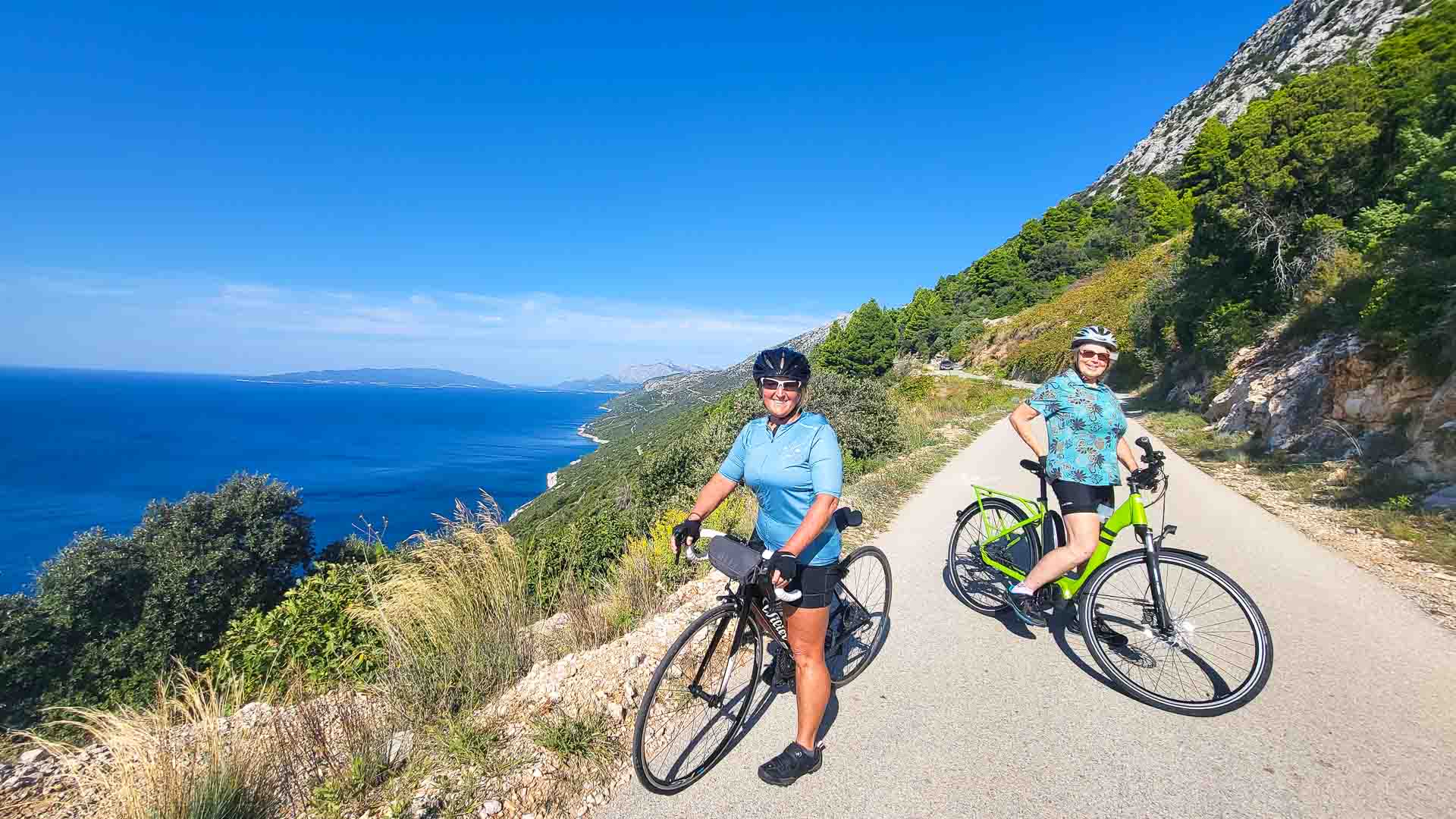
2. Why go on a self-guided cycling holiday in Croatia?
While we offer guided and self-guided tours, I think self-guided tours offer a great middle ground. They’re a cost-efficient way to get the most out of a cycling holiday for the following reasons:
Inside knowledge
With over a thousand picturesque islands and many places that would be excellent to ride in, the challenge is knowing where to begin.
This is where local experts like us come in handy. They know the ferry schedules, the well-maintained cycling paths that avoid tourist crowds, the vineyards that offer tastings along the way, and the hidden beaches with turquoise waters. This is the kind of intel that makes a trip and helps you really get under the skin of the country.
No need to wait for others
When you’re on holiday, you want to do things at a pace that suits you; not be constantly waiting for others or chasing to keep up. A self-guided holiday gives you this freedom and flexibility.
Want to stop and have a chat with the shepherd you bump into at the beach? Sure, no problem! A self-guided trip gives you time for interaction with locals and exploring the places you’re interested in on your own.
Choose your start date
The schedule is flexible – you can choose your travel dates and cycling days and distances. You don’t need to fit into an organised travel schedule.
Choose your travel companions
You get to pick who you ride with; you don’t have to cross your fingers and hope that you’ll like the other people you’re riding with.
The right level of adventure
Self-guided travel provides safety, security and the right amount of pre planning that you don’t get with DIY travel arrangements.
At the end of your trip you’ll know that you’ve navigated your way through a new country with a good deal of independence. Even if you’re a more experienced cyclist, this brings a great sense of accomplishment.
Want help organising your Croatia cycling holiday?
We’ve been planning bike tours in Croatia since 1992 and would love to help you plan yours.
Get in touch and let’s discuss the best holiday for you.
Check out our reviews here – and head over to our website so we can start helping you craft your perfect Croatia cycling trip.
3. What are the best places to cycle in Croatia?
We’ve been running cycling tours in Croatia since 2000. There are many great cycling options to choose from, but here are my pick of the best self-guided cycling tours in Croatia.
This map of Croatia shows you the Istria Peninsula in the north (you can see Pula and Rovinj marked on it) and Dalmatia to the south (with Split and Dubrovnik, as well as some of the islands, marked on it).

Istria Peninsula
Where is it.
Istria is a triangular area, that is part of Croatia and Slovenia. Its northernmost tip lies in Italy. It is located between the Gulf of Kvarner and the Gulf of Trieste. It has 445km of coastline and an area of 3,160 square kilometres.
This part of Croatia is closest to Italy and this is reflected in the food and also the fact the much of the population is bilingual, speaking both Croatian and Italian.
What’s it like to cycle the Istria Peninsula?
One of the draws of this region is that its quieter than the Dalmatian Coast to the south. It’s also got a rich mix of Roman, Venetian and Austiran historic sites, with seafront ports like romantic Rovinj, hilltop towns like Grožnjan and Roman ampitheatres like the one at Pula.
There are tons of vineyards and the food is also excellent, thanks in part to its proximity with Italy. It’s perfect for leisurely cycling holidays!
What are the highlights of this region?
- Pine forests, meadows, vineyards and olive groves at the foot of the Alps , dotted with medieval hilltop villages, which many compare with Tuscany. On the coast, you’ll find dream-like beaches and fabulous bays such as the white pebble beaches in Rabac. Istria is also home to Deep rivers, some of which are cut deep into the limestone and are often compared to the fjords of Scandinavia.
- Grožnjan and Motovun are historic towns, rich in arts and history, with nearby Livade known for truffles. Istria is the place for lovers of truffle-rich pasta dishes!
- Porec – the UNESCO-protected Euphrasia Basilica in Porec is a sight to be seen.
- Rovinj – cycle to the idyllic small town of Rovinj on the west coast of Istria; with its narrow streets and tightly crowded houses, it’s one of the most beautiful places in Croatia.
- The weather – Istria is also know for having more than 2,300 hours of sunshine per year.
Who would it suit?
Food-loving cyclists, looking for demanding bike rides in the inland hills – or families cruising on the Parenzana Railway route.
What are the cycling routes like?
Whether you stick to “Blue Istria“, and its flatter routes along the coast, or head inland to the rolling hills of “Green Istria“, you’ll find routes to suit.
The 120km Parenzana Railway is a popular, gentle route connecting through Livade to Vižinada. This route is particularly appealing since it leads you to the beautiful Roman town of Porec and it’s pretty easygoing all the way!
Small group or self-guided?
The peninsula is ideal for self-guided tours, especially along the straightforward Parenzana Railway. Options range from 5 to 8 days, covering 30km to 60km per day.
Tell us about your tours
- Road biking – a loop ride around the Istrian peninsula with a choice of daily distances, nice climbs, riding mostly in secondary roads with low traffic: Road cycling through Istria .
- Gravel biking – Istria is perfect spot for those searching for gravel biking. There are many gravel roads of different difficulty with a blend of secondary asphalted roads can make a an amazing gravel bike holiday: Gravel biking Trieste to Pula .
- Family trails – Riding on former railway “Parenzana“ is a perfect cycle path for families seeking cycling vacation on traffic free roads: Family cycling holiday Slovenia to Croatia.
- Luxury e-biking – searching for a luxury cycling holiday with extraordinary small boutique hotels, restaurants with excellent food, visits or boutique wineries and riding in a peaceful environment on e-bike: Luxury e-bike tour in Istria, Croatia.
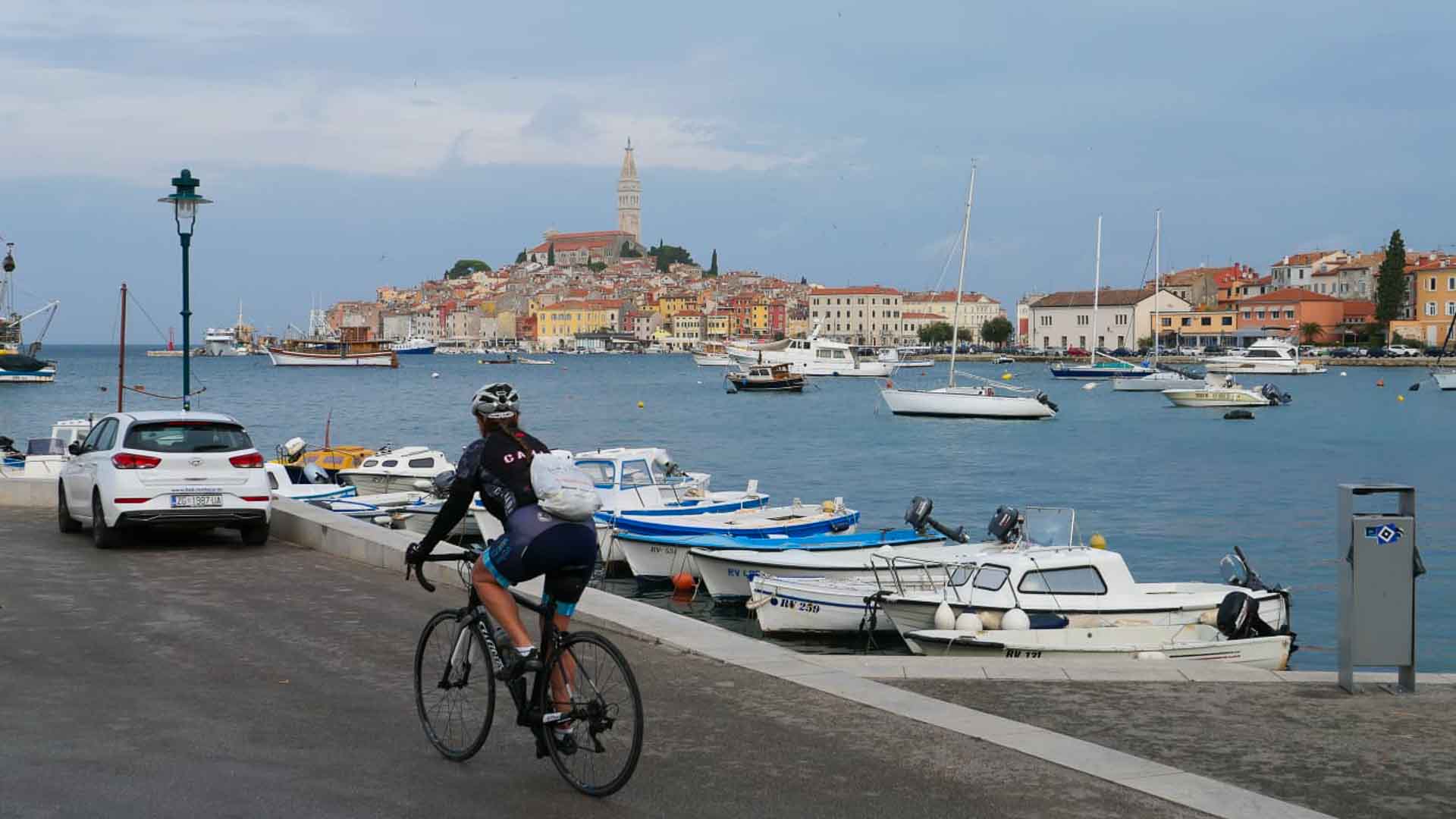
Dalmatia Coast
Croatia’s Dalmation Coast is the most popular and touristy stretch of coastline in the country, stretching from the coast town of Zadar to the Bay of Kotor. It’s alive with Mediterranean admosphere, nice covers and famous places, such as the must-visit town of Dubrovnik and the city of Split, as well as islands such as the ritzy Hvar and rustic Korcula.
What’s it like to cycle the Dalmatian Coast?
The Dalmatia Coast is the place to come if you want a road cycling holiday and island-hopping is on your agenda. Croatia’s central Dalmatian islands are packed close together, making the views between them a lovely patchwork of rolling hill and sparkling Adriatic waters. Even someone who hates swimming in the sea will find it hard to defy the temptation of this region’s crystal-clear waters (in fact in 2022, it was top of the pristine water charts ).
Many of the islands are just 20 or so kilometres across, which makes riding around them quite achievable. On Hvar, you can climb away from the crowds, whilst on Mljet you’re surrounded by national park.
The mainland is home to famous UNESCO sites like Diocletian’s Palace in Split and the old romantic towns of Dubrovnik and Trogir (haven’t heard of Trogir? Well it was named as one of the top 10 island cities by National Geographic …). Between Split and Dubrovnik, the Peljesac Peninsula features the second longest defensive wall in the world ; construction began in 1358 and it was originally more than seven kilometres long, surrounding and protecting the city of Ston.
Meanwhile, the beaches aren’t too shabby either. The “Golden Horn” on Brac, Dalmatia has according to Forbes magazine one of the most beautiful beaches in the world.
- Dubrovnik – cyclist or not, Dubrovnik is one of those cities you just have to see for yourself. But it also makes a great start or end point for a cycling adventure. From here, you’re in the deep south of Croatia and close to many other Balkans nations, if you want to extend your trip.
- Hvar Island – Croatia’s fourth-largest island offers the perfect place for a circumnavigation by bike. The island is famous for attracting celebrities, oligarchs, and yachtsmen. It’s also a fantastic destination for cycling. If you want to ride into the centre of the island, bring your climbing legs as the roads climb steeply, passing lavender fields and olive groves. From the top you can admire breathtaking views, including the tiny Pakleni islands. You’ll also find ancient fishing villages like Stari Grad and quaint, typical villages, surrounded by stone houses, lovely cobblestone streets, and heavenly sea views.
- Korcula Island – Korcula Island is famous for being the birthplace of explorer Marco Polo. It’s stunning, with quiet villages, olive trees, holm oaks and fragrant Mediterranean pines. Korcula old town’s impressive cathedral and mini-Dubrovnik looks and marble-clad alleyways make it popular with cruise-shop day trippers. But you can try and avoid them by heading for the trails.
- Mljet Island – This attractive, rural island is full of natural beauty and doubles as a national park. Mljet National Park cloaks its western end, and scenic backroads lead inland to two unusual saltwater lakes. One even has a tiny island monastery at the centre, which is now a cafe. Make sure you have a swim, as the water is warmer here than in the open sea, and very pleasant.
- Peljesac Peninsula – The thin strip of land that is the Peljesac Peninsula makes a great ride on the way to the walled town of Dubrovnik. It nearly touches Korkula Island – in fact you can get a ferry to one end of the Peljesac Peninsula from Korkula (landing in Orebik), or approach it from Ston at the other end (see the information on its walls above and it’s known for its excellent seafood and vineyards too).
Many cyclists cycle the Dalmation Coast as a linear (or semi-linear as you might like to ride around a few of the islands) route from Dubrovnik to Split, or vice versa. The terrain for this kind of route isn’t super hard. Expect hills – including some steeper hills with 10-12% gradients – but this is not the Alps, it’s an undulating coastline, with some sea level to summit climbs.
You’ll mostly be on road with with a few gravel tracks on the islands.
Cyclists that don’t mind taking on a few hills, who want to see some of Croatia’s most famous destinations and who love to jump in the sea at the end of a day’s riding.
Island hopping cycling tour – Dalmatia with its many beautiful islands and well connected ferries is a great choice for those seeking an island-hopping holiday.
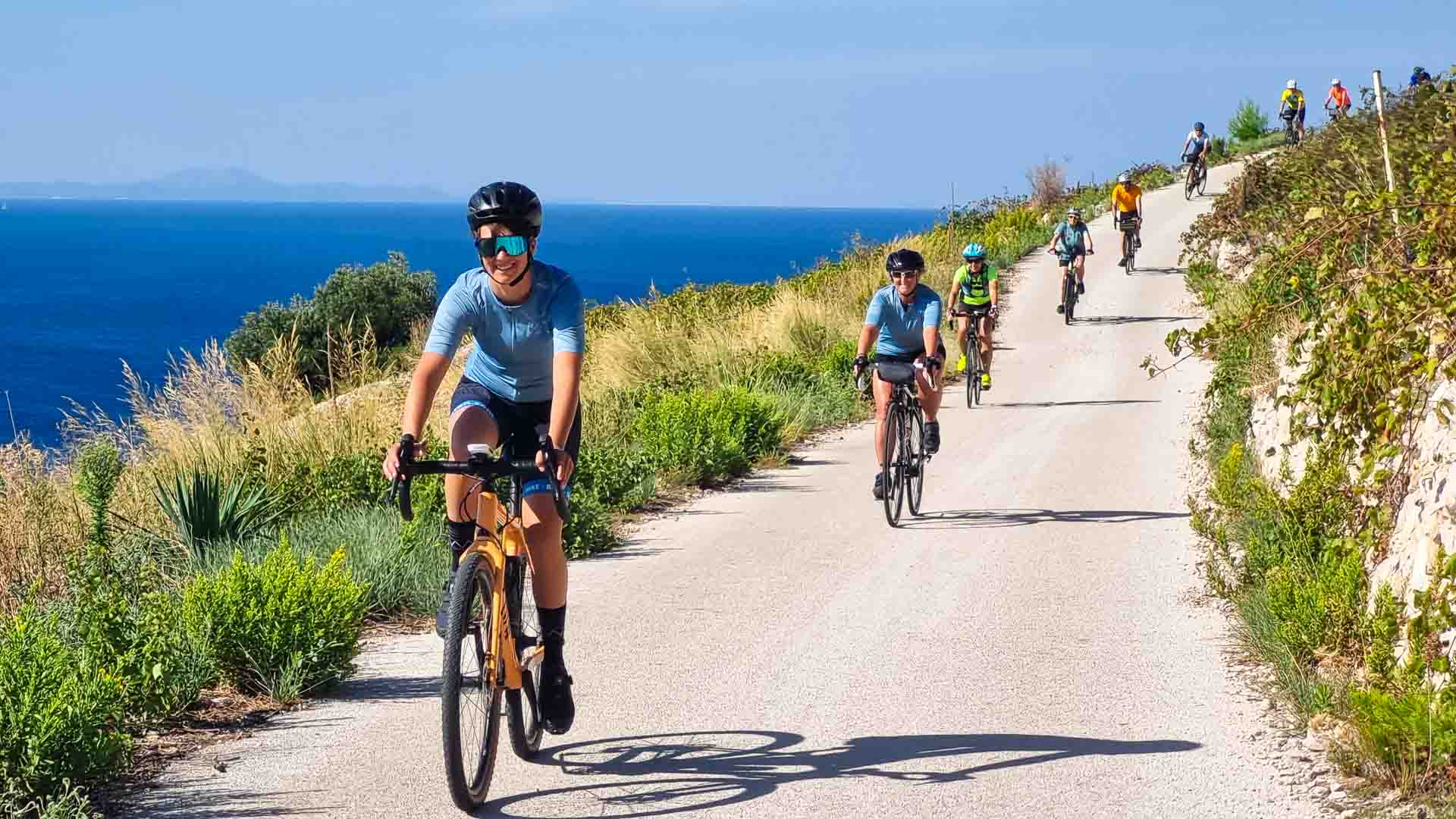
4. What’s the best time of year to visit?
Cycling season begins in March in Croatia and runs through into early November.
We think the best months for cycling in Croatia are late Spring and Autumn, so April, May, June, September and October.
We always suggest that our clients avoid July and August if they can, as there are so many visitors in Croatia and the roads can get really busy.
- Croatia does not yet have many cycle-specific paths, so cyclists tend to ride on the roads; this can be less enjoyable when there is too much tourist traffic. Given this, it’s a good idea to consider going on a cycling trip out of classic peak season in July and August to avoid heavy traffic on the road and crowds in the towns.
- It can also be really hot in July and August and, if you decide to ride in Dalmatia, you’re likely to have to queue for ferries.
In spring and autumn, the weather might be a touch less predictable, but you should still enjoy some warm weather. In spring, think about timing your trip to coincide with Croatia’s glorious wildflower season and during April and May you can try wild asparagus dishes, as it’s ready for picking at that time.
A draw of a cycling trip to Croatia in September or October is that sea temperatures are still pretty warm. For those that love wine, it’s also worth bearing in mind that grape harvest happens in September and riding with the aroma of fermenting grapes in the air is very memorable! In Istria, the truffle festival starts in mid-September, although the most important are during October and November.
A final note of caution: keep an eye on the weather forecast. The weather in Croatia is generally good, but occasionally there are strong winds, such as the mistral and the bura. More info on Croatia’s winds, here.
5. What is the food like in Croatia?
Food is a very important part of life in Croatia. This is good news for cyclists visiting Croatia!
However, don’t expect acai berries and cortados. The kind of food you’ll find in Croatia is delicious, authentic and local, with lots of fish and fresh seafood. Southern and coastal areas of Croatia have been influenced mostly by Italy, while central and northern parts have had stronger influences from Austria, Germany and Hungary. We have also adopted many excellent Turkish dishes.
Sampling the local cuisine is a big part of a self-guided cycling trip in Croatia.
6. What is the accommodation like for cyclists in Croatia?
Tourism in Croatia is still relatively new and there’s a strong push towards sustainability and slow travel. This means that you shouldn’t expect massive Mallorca-esque sports hotels with mega buffets and 50 different sports to choose from. More common are small, rural hotels and guesthouses which are high on charm but low on cycling-specific facilities.
Many are renowned for their excellent cuisine and, choose wisely, and you’ll be sure of a warm welcome to cyclists, traditional hospitality and an authentic experience.
Boutique 4- and 5-star hotels with swimming pools are available, but they’re less common so can have an impact on itineraries.

7. Anything else to consider for a self-guided cycling holiday in Croatia?
Practical preparations.
Before you go, make sure you know how to fix a puncture. On a self-guided trip, tour companies will expect you to be able to manage this yourself.
If you’re bringing your own bike, make sure it’s serviced and consider a pre-departure bike fitting so that you know you’ll be comfortable in the saddle.
Consider your level of fitness compared with the route you’re undertaking. You might also want to do a little training if you’re not used to riding multiple days of biking back-to-back. Otherwise, you might find that your holiday is less fun and more painful than you expected!
Wear proper cycling shorts and pack the right clothes and kit (include sunglasses and suntan lotion!) – if you’re on a self-guided trip there’s no option to sit out a day in the van.
Cultural sensitivities
Many rural areas in Croatia are still not overly used to visiting cycling tourists. Think twice before checking out the local church in your scanty lycra.
Remember that not all the Dalmatian islands have the best waste disposal or recycling. Consider taking litter that can’t be recycled where you are back with you from the island, so you can dispose of it in a better way.
Dalmatian islands are well connected with the mainland and between the islands. There are three ferry companies connecting the islands: Jadrolinija, TP Line and Krilo. If you plan an island hopping cycling tour, please check the ferry schedule carefully.
Also bear in mind that if there are strong winds or rough weather, some passenger ferries will not operate and you should expect longer connection times between the islands, using the car ferries. Between some islands you may find private speedboats as well.
One of the advantages of a cycling holiday with a local operator is that we take great to make sure we plan holidays on quiet roads with low traffic through small villages. However, in order to make sure you also see some of the more famous towns, it’s sometimes necessary to ride on busier roads as you approach them (for example Poreč, Umag, Rovinj). It’s also a good idea to visit outside of the busiest “general tourism” months, to reduce the amount of riding in traffic you’ll do.
Take out the appropriate travel insurance, making sure it includes cycling that you’re planning on doing. There’s more on cycling travel insurance, here.
Make sure the tour operator you’re with knows about any medical issues you have.
Make sure you take enough water. Cycling Croatia’s hills is thirsty work, whatever the weather. While you’ll ride through towns from time to time, it’s best not to rely on there being other water sources around.
Adjust your bike so it fits you at the start – and if you’re on a self-guided tour, make sure you’re comfortable before you leave as you might not have access to much expert guidance on the way. Bringing your own saddle can be a good idea for extra comfort.
Carry a basic first aid kit and remember to apply suncream!
Highway code and travel information
As ever, it’s a good idea to check current travel information before you book and travel. For UK visitors, the UK government travel information pages for Croatia are here.
You should also read and follow Croatia’s highway code.
Part 2: Cycling in Croatia: self-guided cycling holidays in Croatia with Fiore Tours
8. what tours do you offer in croatia.
In Croatia we offer lots of different types of cycling tours: guided, semi-guided and self-guided gravel, MTB, road/race, e-bike and family bike tours with a choice of accommodation in classic three star, premium four star and luxury five star hotels.
Our most popular three Croatia bike tours are:
- Self guided bike tour from Trieste to Pula: with a choice of cycling on gravel or asphalted roads
- Self guided cycling Istrian wine roads tour – the easiest self guided cycling tour in our Croatia offer, distances are around 30-45 km mostly on flat and easy hills
- Self guided island hopping tour from Split to Dubrovnik – with accommodation in three, four and five star hotels on islands, using ferries and private boat to moving from island to island

9. What is special about what you offer?
I founded Fiore Tours in 1992 and I am proud to say that we were the pioneer of self-guided cycling holidays in Croatia and are now the most experienced operator of adventure, cultural and gourmet travel in Croatia.
Every year we run over 200 self guided cycling tours of Croatia for singles, couples, small groups, family reunions, clubs or friends.
Our size means that we can offer guests a choice of self-guided, semi-guided and fully guided and supported cycling tours. We can also customise every tour if the client wishes. Our in-depth knowledge of the regions means we can offer clients a choice of accommodation categories: classic three star hotels, premium four star hotels or luxury five star hotels.
For our guided trips, we keep our group sizes small. Travelling in small groups between 4 and 18 people gives you lots of freedom – much like you would have if you were traveling with friends.
Customer service is key for us and we always try to give a very fast response time to client requests. Our staff are knowledgeable, friendly and speak English.
We have a fleet of good quality bikes and equipment for rental and can offer 24/7 support during a tour. We also own our fleet of vehicles for support, luggage transfer and airport transfers, which helps ensure we can meet our clients’ demands.
10. What are your tips for choosing between companies offering self-guided cycling holidays in Croatia?
I think it’s helpful to bear these points in mind when choosing a tour operator in Croatia:
- Do you get a response to your enquiry within 24 hours?
- Can they customise the trip to your requirements?
- Do they offer a flexible start date?
- Is there 24/7 support on the ground?
- Are there high quality bikes and and equipment for rent?
- Are the route descriptions and maps excellent quality?
- Do they offer free use of an app for offline navigation?
- What are their reviews like?
11. How should someone find out more about you?
The best place to start is our website, www.fiore-tours.com . From here, you can check out our tours or get in touch via our contact page or social media.
Got a question for Dalibor?
Fill out this form and we will send it to Dalibor. We aim to get you an answer within 24 hours wherever possible!
We will use this info to send the enquiry to Dalibor and/or their team. Our privacy policy explains more and here’s a reminder of our disclosure policy and terms and conditions.
Dalibor says, “In 1992, my father and I took the plunge and set up Fiore Tours. We started by arranging accommodation for clients in hotels, apartments, and private accommodations in Croatia. Over the years, we introduced an array of adventure holidays, with mountain biking, road cycling and family-oriented trips now being a very large part of what we are about. At Fiore Tours, we pride ourselves on providing exceptional and unforgettable experiences for our clients, ensuring that their holidays are filled with fun and exploration.”
The contents of this website are provided for general information purposes only. It is not intended to amount to advice and you should not rely on it. You should carry out your own due diligence and risk assessments and take professional advice. Views expressed by interviewees or other users of this website do not necessarily represent our views. We make no representations, warranties or guarantees, whether express or implied, that the content on our website is accurate, complete or up to date. If you use any information or content on this website, download from, or otherwise obtain content or services through our website, it is entirely at your own discretion and risk. Epic Road Rides Ltd disclaims all liability and responsibility arising from any reliance placed on the information and content on this website. Find out more here .
Leave your comment
Click here to cancel reply.
- Name (required)
- Mail (required) (will not be published)
This site uses Akismet to reduce spam. Learn how your comment data is processed .

- RATES & REMARKS
- SEND ENQUIRY
- BOOK ONLINE
Istria (Croatia’s green heart): coast to coast
Experience the tender rural aspect of Croatia’s countryside – vineyards, rivers, olive trees, forests, enclosed villages and hilltop medieval towns. All of this and more is what defines Istria as one of the best self-guided walking tour destinations. A perfect combination of culture and nature all in one unforgettable landscape. This cultural heritage experience will take you to idyllic towns like Motovun and Grožnjan where you will feel like you have traveled back in time. The Učka Nature Park will reveal the natural treasures of green Istria before you. And no experience is fully complete without the active participation of local food and wine every step of the way.
Walking Grade/ Difficulty
See more here
- Destination Croatia
- Duration 8 (5-7) Days I Level: 3 (of 5)
- What is included Welcome meeting; Accommodation in 3-4* hotels and guesthouses, en-suite rooms, incl. breakfast; Detailed route description in English (map and road book; GPS tracks); People transfers as per program; Luggage transport between accommodations; Emergency hotline;
- What is not included Airport transfers; other meals and drinks;
- Best period March, April, May, June, July, August, September, October, November
FROM OUR GALLERY
Self-guided inn to inn hiking tours in Istria, Croatia

Day 1: Arrival in ISTRIA.
Day 2: brtonigla - buje/area (5-6hrs, 16-18km, +300m/-300m), day 3: grožnjan - motovun (6-6,30hrs, 25km, +520/-580m) (shorter option: 5hrs, 20km), day 4: around motovun (3-4hrs, 15km, +450m/-450m), day 5: oprtalj - buzet (5-6hrs, 18km, +500/-700m) (shorter option: 2-3hrs, 8km), day 6: buzet - hum - buzet (7hrs, 25km, +550m/-550m) (shorter option: 3-4hrs, 13km), day 7: učka - lovran (5hrs, 15km, +780m/-1690m) (shorter option: 2hrs, 6km, +30m/-390m), day 8: departure, tour location.

Single room & Solo Traveler supplement
Accommodation, send an enquiry about this tour.
Your Name (required)
Your Email (required)
Your Message
Split Croatia Walking Map & Self Guided Tour
Use the map and attractions guide to visit diocletian palace.
The Split Croatia Walking Map and guide is a great way to explore Diocletian’s palace at your won pace. Whether you are in Split for a few hours after docking here on your cruise ship or staying in Split for a few day, this guide will help you explore the area.
Click on the arrow icon to the left of the title to display the legend. Click on the attractions map pins (green pins) on the interactive map below, or on the legend or the PDF map that you download for additional information of the attraction. The accompanying attractions guide will provide a complete list of information
The palace has become part of the city and the grey outline on the map below shows you the border between the palace and Old Town. This is the only “living palace” where inhabitants actually live in the palace. There are a number of hotels within the palace as well as shopping and food establishments, Its easy to think you are lost however the palace has two main streets running north/south and east/west so you can always find your way back.
Accompanying island guide to accompany the Split Croatia walking map is HERE
To download the split croatia walking map in pdf click here, click on image of map for split croatia attractions guide.
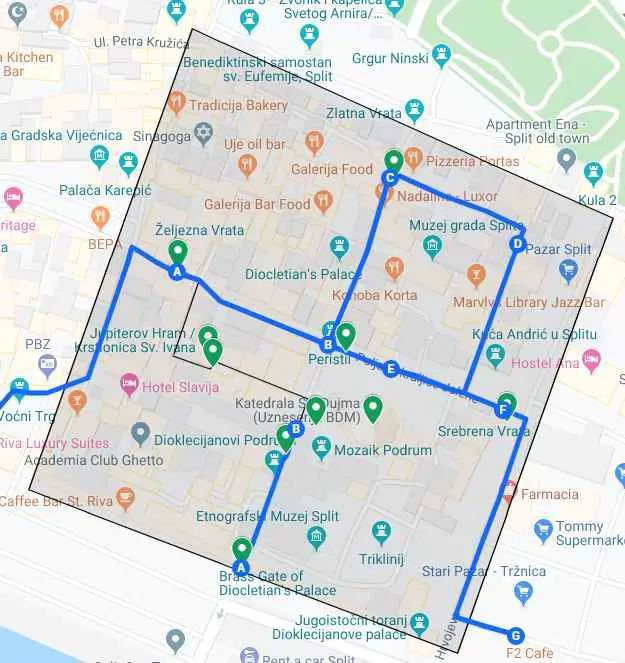
General Information
Split Croatia Old Town is one of the best and oldest preserved towns in the world and a UNESCO World Heritage Site . It has a varied architecture due to the influences of the many cultures that occupied Split over the millennium. Game of Thrones was filmed here and you may see some Game of Thrones information panels in the city. If you have time be sure to explore the Old Town Split and nearby Marjan Hill using the attractions guide HERE
Instructions to download the interactive map to a smart phone:
Take the map with you when you travel:.
Instructions on:
- Using it offline
- Using it online – We bring one of our older smart phones when we travel and buy a local SIM card. You can purchase a local tourist SIM card from one of the main local providers, they are usually pretty inexpensive. You may need your passport to purchase as its a tourist SIM if you are an international tourist. You should have them put it in your old smartphone and check that it works before leaving the store. Use it to follow the map online, its the best way to explore
Sign into google using your Gmail account on your smart phone and be connected to the internet. If you do not sign in, this process will not work . You will be downloading this map to save it. You will be saving it in google maps in two places:
- Save in “Your Places” for online use and
- Save in “Offline map” for offline use
- Youtube instructions on link as follows: https://youtu.be/_6j9koieMsU
Instructions to save above map:
- Click on the rectangle on the top right hand side of the above map [ ] – if you move your mouse to it, it will say “view larger map”
- It will take you into google maps on your smartphone and it will automatically save this map. You must be already be signed into google maps with your Gmail account, if you are not signed into google maps then the map will not be saved
- In google maps, click on the menu which is the three horizontal lines on the top left of the google map (it is to the left of the search box)
- From the menu, click on “Your Places”. This will take you to another screen with a menu at the top. From the top menu bar select “maps”. A list of your maps will be displayed including the map that was just saved. Select the map you just saved
- Make sure the map is still onscreen; do not close out of it as you will be downloading this map and it has to be onscreen to download. While the map is onscreen, click on menu again (three horizontal lines top left hand corner)
- Select “Offline maps” then select “custom map”
- Once you select “custom map”, the onscreen map will be displayed; select the area you want downloaded (zoom in or out to get all the data points into the blue square outline; pinch fingers for zooming)
- Click on “download” – this will save the map in an offline area that you can use when you are not connected to the internet
The map is now saved in two places. To see this, click on the menu (three horizontal line on top right hand corner) in google maps:
- Click on “Your Places” from the menu, then select “Custom Map”. The map will be listed and you can use the map while connected to the internet
- Click on “Offline Maps” from the menu. The map will be listed to use the map offline ie: not connected to the internet (make sure location services is turned on and your will see the blue dot indicating your location as you navigate with the offline map)
- After you download a map, use the Google Maps app just like you normally would. If your Internet connection is slow or absent, or if you are in “airplane mode” Google Maps will automatically use your offline maps to give you directions
For Additional Croatia Travel Guides, Tourist Maps and Airport Transfer:
- Dubrovnik Game of Thrones and Old Town Self Guided Tour – Follow the Map and Guide to visit the film locations for Game of Thrones, beaches and churches. The self guided tour will take you a full day if you also visit the beaches. Use the map and attractions guide to visit the attractions of Old Town Dubrovnik and the locations of the Games of Thrones Scenes. The map has picture of the sites and how they looked for the film scenes. The walking tour will take you ½ a day. If you visit Lokrum island and spend time at the beach/monastery/fort on the island, this will take you another ½ day to full day. Lokrum Island is the location of the City of Qarth in GoT and is a 10 min water taxi ride from the Dubrovnik Port
- Dubrovnik Day Trips . Spend a day at each of the villages of Ston and Cavtat a short distance from Dubrovnik. Cavtat is a charming village that was invaded by the Slavs. The inhabitants fled and were the original settlers of Dubrovnik. Visit the historical beaches and spend time on the beach or hike the Ronald Brown Pathway. Ston is a small village on a hill surrounded by a 7 km wall that is second in size to the Great Wall of China. It is famous for its defensive walls, its salt “mines” and its oyster bays. The oysters from Ston are well renowned
- Upper Town, Old Town Zagreb – 15 must see attractions of Old Town Zagreb. Walk the attractions of Upper Town Zagreb, the self-guided walking tour will take you to the various attractions in ½ a day. You may want to explore some of these attractions in greater depth such as the Museum of Broken Relationships or climb the Lotrščak Tower. In that case the self guided tour will take more than half a day
- Zagreb Lower Town, Lenuci Horseshoe – Visit the 7 Squares and Botanical gardens in the shape of a horseshoe, including the under ground 31,000 sq meter shopping mall. A ½ day tour of the U-shaped system of 7 parks and Zagreb botanical gardens. The Lenuci horseshoe in Lower Town Zagreb is a short walking distance from Zagreb’s main Ban Jelačić Square and facing the main train station Glavni Kolodvor . The Square include pavilions, theater, museums, state archives and an underground mall amongst its many historical buildings dotted throughout the horseshoe
- Walking tour Zagreb Lower town and Grič Tunnels – A 2 hour tour of the tunnels under Zagreb old town; they were built as shelter during the war and are now used by the locals to cross Old Town or to go between upper town and lower town. Not only are they a short cut, they are cool in the summer and a welcome relief from the searing sun. Explore the old world war tunnels and visit the sights of lower town
- Unique and Fun things to do in Zagreb – Explore activities and places to visit such as Jarun Lake, the Antiques Fair or discover current events in Zagreb
- Old Town Split and Marjan Hill – Explore the Old Town Square, then head over to Marjan Hill. This self guided tour can take a whole day as the walking portion of the tour will guide you to attractions in the Old Town and then on to Marjan Hill. This part of the tour will take ½ a day. The tour will end at the beach where you can spend the rest of the day, take the local bus back or walk along the promenade back to Old Town
- Split, Salona ancient Roman Ruins – On the outskirts of Split, don’t miss the roman ruins of Salona, the birthplace of Emperor Diocletian. Step outside of the Old Town of Split and visit the nearby city of Solin (which is the ancient city of Salona, Diocletian’s birthplace). Then continue onto the town of Trogir. This self guided tour has instructions for local buses to take you on a route for a full day trip from Split to Salona (stop in Salona, then continue onto Trojir. Then catch the local bus back to Split
- Trogir, UNESCO World Heritage Site – This attraction is often overlooked. It is a charming, authentic village, a heritage city where the Old Town is on an Island. It is an easy bus ride from Split to Trogir, with a stopover in Salona (Solin)
- Split, Diocletian’s Palace – Not to be missed, the10 must see attractions in the palace to stop and take pictures. The Palace tour is a ½ day self-guided tour through the palace that will end at the market which you can explore
- Zadar Western Half – The old town is located on an island; explore the attractions on the westerns side of the island in this ½ day self guided walking tour. Attractions include popular attractions such as the Sea Organ, Greetings to the Sun and the Roman Forum / Ruins
- Zadar Eastern Half – Take a ½ day to visit the churches, parks and other attractions on the eastern side of Zadar Island. Visit the fish markets and green markets for fresh food and explore the cobblestone alleyways for a touch of ambiance and potential souvenir shopping
- Zadar islands – The Zadar Archipelago has around a 100 islands off its coast, many of them uninhabited. Visit all or any of the 9 popular islands in this map and use the attractions guide to the islands. You can rent a boat rent a boat with or without a captain, get a water taxi, take the ferry/ to visit the islands and swim in the Adriatic or anchor at hidden beach/cove
- Island Visit
- Croatia Islands – Rent or hire a boat to visit the 9 popular islands off the mainland. Visit 1 or 2 or all 9 islands for a fabulous day out to sea
- Hvar old town attractions and Španjola fortress (Fortica ) – Use the self guided tour map and attractions to visit the popular sites in Hvar Old Town. The tour will take ½ a day to the major attractions in Hvar Town, including climbing to the Spanjola fortress that has been protecting Hvar for hundreds of years. However it could be longer if you want to spend time visiting the museums or spending an afternoon enjoying the magnificent views from the Fortress
- Hvar Island driving tour – Take the local bus, rent a car / scooter for the day to visit the numerous attractions on the island. This can take two days as there is a lot to see and do. It includes: wine tasting, visiting a cave monastery high on the hills, quaint fishing villages, popular beaches, hidden coves and harbours A great tour that will take you across the island
- Hvar Islands and Lavendar Fields Tour – You can rent a boat (with or without a captain) and visit the islands off Hvar Island. The Pakleni Islands are an archipelago of 20 islands off the coat of Hvar. They are known for beautiful beaches, charming village towns and secluded coves. You can take the bus to visit the abandoned villages of Velo Grabjle and Malo Grabjle,. It is a short bus ride or scooter/car trip from Hvar Town. Explore the fields of lavender and Olive Grove farms
- Getting around Croatia – Information on Croatian buses and ferries
- Hawaii’s Big Island
San Juan Islands
- ————-
- Loire, France
Provence, France
Puglia, italy.
- Pyrenees, France
Tuscany, Italy
- Self-Guided Cycling Tours
- Guided Bike Tours
- Guest Reviews
- Local Cycling Guides
Istrian Peninsula, Croatia
Discover the sparkling shores of the adriatic..

- Custom start date and tour length, personal itineraries and service
- Local expert guides who live in the area delivering superior insight
- An Adriatic coast and a bucolic interior
- Ride through traditional countryside: past olive groves, small farms, and truffle stores
- Quaint fishing towns with excellent seafood restaurants
- Gentle climbs across fertile farmland and through picturesque villages
- Beautifully preserved towns, including a UNESCO World Heritage site
Spring, Early and Late Summer, Fall
Starting / Ending City
Pula, Croatia or Trieste, Italy
Tour Length
3 to 9 days
◊ Self-Guided With our Self-Guided tours an expert local guide takes care of your transfers, route briefing, luggage moves, and planned transfers. They are also available should you need mechanical assistance, help with a dinner reservation, or general questions. You have a GPS unit, maps, and a detailed guidebook to help you select your route, choose where you eat, and, generally, explore the area.
◊ Guided Group Our Guided tours allow your group to explore a destination with an expert local guide with a dedicated support vehicle. You will also have GPS units, maps and a detailed guidebook to help learn about both the major sights and the hidden gems. Your guide takes care of both you and all the logistics – from route advice to bottle washing.

d Design Your Tour
Tell us about your perfect tour so that we can customize an itinerary.
Where do you want to go?
- All Regions
- North America
Hawaii's Big Island

Loire Valley, France

The Pyrenees, France

Catalonia, Spain

Southwest Ireland

Douro Valley, Portugal

Where do you want to stay?

Simple B&Bs and more modest hotels but all well-kept with en suite facilities

Nice B&Bs and more modest inns or hotels. The B&Bs typically include welcome drinks and great breakfasts.

Smaller hotels or luxurious B&Bs with very personal service often including wine tasting

Some of the nicest full-service hotels in the area. Typically include spa facilities and a restaurant.

Some of the nicest full-service hotels in the area. Typically include a pool and a good restaurant
When, how many days and how many in your party?
Let us know when you would like to travel, how long you would like your tour to be and how many people might be in your party.
What else should we know?
Tell us more about you and what you're interested in! While completely optional, providing us with more information helps us design the perfect tour for you.
Where should we send your custom itinerary?
Thank you for providing us with your tour preferences. The next step will be for us to contact you with a prepared itinerary which we can further customize. We will be in touch soon!
Thank you for your submission. We will be in contact very soon!
Our Croatia Bike Tours
The Istrian Peninsula is the largest peninsula in the Adriatic Sea and is shared by three countries, Croatia, Slovenia, and Italy. The central and southern region belongs to Croatia, which makes up 90% of the peninsula. Our itinerary provides you with the opportunity to incorporate Italy (Venice day tour and Trieste starting point) and Slovenia (part of an available ride) as a part of your Croatian adventure.
The Istrian Peninsula is two worlds. There is the traditional Istrian interior with its hilltop villages set among ancient farms, forests, and rolling hills. In contrast, the coast is craggy, scenic, and framed by the sparkling waters of the Adriatic. This is also where you find walled cities that date back to the Venetian Republic. Istria is the gastronomic heart of Croatia and attracts foodies from across the world for its fusion of Italian and Slavic cuisines. Culturally, the Greeks, Romans, Slavs, Venetians, and the Habsburgs have all left their marks here. Highlights include the beautiful coastal towns of Rovinj and Poreč and the hilltop villages of Motovun and Grožnjan.
All trips are customized for you; your dates, your ride distances and your style of lodging. During your bike tour, we take care of all the logistics and our support vans are always nearby so you simply enjoy the freedom of cycling at your own pace.
LifeCycle Adventures is an owner-operated company – we live and ride in the areas we operate. So, you know you will be looked after by real locals who will help you find the hidden gems wherever you are riding. Learn more about the LifeCycle Adventures difference.
Sample Itinerary
Croatia Sample Itinerary
From $1,540 per person for 3 days

The Istrian Peninsula is two worlds. There is the traditional Istrian interior with its hilltop villages set among ancient farms, forests, and rolling hills. In contrast, the coast is craggy, scenic, and framed by the sparkling waters of the Adriatic. This is also where you find walled cities that date back to the Venetian Republic. Istria is the gastronomic heart of Croatia and attracts foodies from across the world for its fusion of Italian and Slavic cuisines. Culturally, the Greeks, Romans, Slavs, Venetians, and the Habsburgs have all left their marks here. Highlights include the beautiful coastal towns of Rovinj and Poreč and the hilltop villages of Motovun and Grožnjan.
TOUR LENGTH
6 Days / 5 Nights
ACCOMMODATION OPTIONS
Budget
Classic
Luxury
START & END
Service highlights.
- Private transfer from Pula or Trieste with bike set up and route briefing at the start of tour
- Bilingual guides delivering superior service
- Handpicked accommodations with breakfast
- On-call roadside assistance
- Luggage moved between lodgings and optional participant transfers along the routes
- GPS app, maps, directions and guidebook
- Private transfer back to Pula or Trieste at the end of your tour
OPTIONAL EXTRAS
- Alternative start/end location in Venice, Italy
- Boat excursions
- Wine tours and olive oil tastings
- Day trips to Venice
BIKE AVAILABILITY
Day-by-day flow.
Day 1: Pula or Trieste to Buje
Day 2: Buje Loop Day
Day 3: Buje to Poreč
Day 4: Poreč Loop Day
Day 5: Poreč to Rovinj
Day 6: Rovinj Loop Day
Day One - Pula or Trieste to Buje
The Intermediate route starts with a transfer to Tinjan. From here you ride through traditional Istrian countryside: past olive groves, small farms, and truffle stores. Initially the route rolls through the hills before descending steeply to the Jezero Butoniga reservoir and onto the Mirma River Valley. After a flat 11 miles in the valley there is a 3-mile climb up to the town of Buje.
The Leisure route starts with a transfer to the village of Trviž, five miles before the descent down to the Jezero Butoniga reservoir on the Intermediate route. You then follow the Intermediate route to Buje.
The Challenge ride begins in Tinjan with the Intermediate route but, after the Jezero Butoniga reservoir, it detours steeply uphill to the village of Oprtalj. At the top of the climb the route takes winding country roads, past the art village of Grožnjan and into Buje.
Ride through traditional Istrian countryside: past olive groves, small farms, and truffle stores

RIDE OPTIONS
25 miles with 1,700 feet of climbing
Intermediate 30 miles with 2,000 feet of climbing
Challenge 35 miles with 2,600 feet of climbing
OVERNIGHT TOWN
Buje is a fortified hilltop town overlooking vineyards and olive groves. The town’s narrow alleys lead to quaint squares, art galleries, and charming restaurants. Its location makes it an ideal base for exploring local vineyards. It is also home to some of Croatia’s best olive oil.
Day Two - Buje Loops (A) or Rest Day
The highlight of today’s routes is the coastal town of Novigrad – a quaint old fishing town with some excellent seafood restaurants.
The Intermediate route starts with an eight-mile, rolling descent to the coast, arriving in the village of Lovrečica. From here, you follow the coastline south around Uvala Slanik Bay, passing an early medieval monastery, before arriving in Novigrad. After lunch and a wander in Novigrad, there is an eight-mile climb to the village of Vižinade and a fast descent to the Mirna Valley. A final climb out of the valley brings you back to Buje.
Leisure riders follow the same route to Novigrad but take a more direct route, with less climbing, back to Buje.
The Challenge route follows the Intermediate route to Vižinade where it turns south for a rolling loop via the hillfort town of Motovun, one of Istria’s best-known and most-photographed towns.
Novigrad – a quaint old fishing town with some excellent seafood restaurants

Leisure 25 miles with 1,600 feet of climbing
Intermediate 40 miles with 2,700 feet of climbing
Challenge 50 miles with 3,700 feet of climbing
Day Three - Buje to Poreč
All of today’s routes leave Buje on a gentle four-mile climb to Grožnjan, a sleepy hilltop Town of Artists , with a well-preserved medieval center, boutique shops, cafes, and art galleries.
From Grožnjan, the Intermediate route follows the ridgeline to the north of the Mirna valley, passing through many pretty towns including Motovun, one of the best-known and most-photographed hilltop towns in Istria. The route ends with a gradual 12-mile descent into the coastal town of Poreč.
After Grožnjan, the Leisure route turns south, bypassing Motovun, and rejoins the Intermediate route after passing Višnjan Observatory.
The Challenge route continues east along the ridge through woodland, where there are occasional views of Kaštel Petrapilosa (a medieval castle). The route then rejoins the Intermediate route in Livade.
The Epic route takes a wider eastern loop through Buzet: City of Truffles . The route climbs out of Buzet, passing various small villages, traditional farmlands, and mixed forests. The route then rejoins the Intermediate route in Livade.
Motovun: one of the best-known and most-photographed hilltop towns in Istria

Leisure 30 miles with 2,000 feet of climbing
Intermediate 40 miles with 3,000 feet of climbing
Challenge 5o miles with 3,800 feet of climbing
60 miles with 5,700 feet of climbing
Poreč has a beautifully preserved old town, located on a 1,200 ft by 600 ft peninsula. The town has cobbled streets, ancient Roman architecture, and an imposing basilica – now a UNESCO World Heritage Site. There are numerous music, dance, and art events throughout the year.
Day Four -Poreč Loops or Rest Day
Today you head to the interior of the peninsula.
The Intermediate ride is a relaxing ride through traditional villages, passing vineyards, olive groves, and bucolic farmland. After about ten miles, you arrive at Sveti Lovreč, a well-preserved medieval town that was an important military base for Venice during the 14th century. The route continues to roll along small country lanes with a gentle six-mile descent back into Poreč.
Leisure riders do a shortened version of the Intermediate route, visiting small villages and passing wineries and olive groves.
The Challenge route follows the Intermediate ride to Sveti Lovreč after which it continues inland to Tinjan, considered to be the home to the best pršut (dried ham) in Istria. From here the route takes small, quiet roads back to Poréc.
The Epic route follows the Challenge route to Tinjan where it continues east to Pazin, the capital of the Istrian Peninsula. The 10th-century castle at Pazin is the best-preserved medieval fortress of central Istria. The town also has views of a dramatic gorge.
Poreč is a beautifully preserved Venetian town that is now a UNESCO World Heritage site

Leisure 20 miles with 1,000 feet of climbing
Intermediate 30 miles with 1,500 feet of climbing
Challenge 35 miles with 2,200 feet of climbing
54 miles with 3,700 feet of climbing
Day Five -Poreč to Rovinj
The Intermediate route leaves Poreč along a pretty bike path that hugs the Adriatic coast. After a few miles, you head inland past olive groves and vineyards. The route climbs gently for 13 miles, passing through the Venetian town of Sveti Lovreč, and summiting at the tiny hamlet of Barat. From here riders descend to the Dvigrad ruins – a town founded in the first century and abandoned in the eighteenth century. After climbing up to the small village of Kanfanar, the route descends for nine miles to Rovinj.
The Leisure route starts with a van transfer from Poreč to Sveti Lovreč where it joins the Intermediate ride.
The Challenge route follows the Intermediate route to the village of Kanfanar where it continues with an eastern loop to Žminj, well-known for its tower which originally formed part of a 15th-century castle. From this town the route descends back through Kanfanar, and rejoins the Intermediate route for the descent into Rovinj.
Rovinj is known as Mini Venice for its pastel-hued houses and winding, cobblestone streets

Leisure 20 miles with 1,200 feet of climbing
Intermediate 35 miles with 2,200 feet of climbing
Challenge 45 miles with 2,800 feet of climbing
Rovinj is an ancient coastal town dating back to the Bronze Age. Originally a small island protected by stone walls, the channel was filled in 1763, joining it to the mainland. Its Venetian history, winding cobblestone streets, and pastel-hued houses has led to it being known as Mini Venice.
Day Six - Rovinj Loops - Last Day
Today’s Intermediate route is a gentle up-and-then-down loop ride. The ride climbs out of Rovinij to the town of Bale. This quiet and picturesque medieval town is something of a hidden gem. After Bale, you continue climbing up to Svetvinčenat, another beautiful village with a well-preserved 13th-century castle. After lunch and a look round the castle, the route rolls across countryside to Kanfanar – another castle. From Kanfanar the route heads back to the sea and you enjoy a gentle descent all the way back into Rovinj.
The Leisure route follows the Intermediate route to Bale where it turns north, cutting across the Intermediate route for a shorter ride.
The Challenge route follows the Intermediate route to Svetvinčenat. In Svetvinčenat the route detours east along quiet country lanes through small hamlets, natural woodlands, and olive groves. The route passes through Žminj and rejoins the Intermediate ride in Kanfanar for the run back into Rovinj.
Bale is a quiet and picturesque medieval town and something of a hidden gem

Leisure 20 miles with 1,100 feet of climbing
Intermediate 30 miles with 1,600 feet of climbing
Challenge 50 miles with 2,500 feet of climbing
As this is the last day of your tour, there is no overnight accommodation unless explicitly requested on booking.
ACCOMMODATION
Hotel La Parenzana A small, country hotel outside of Buje. The hotel is set among vineyards and natural forest with exceptional views of the surrounding countryside. Rooms are modest and clean. The property has one of the best restaurants in the area serving local meats and vegetables from their garden. Reservations required for the restaurant.

Hotel Melissa A small, modern hotel, perfectly located in the old town. The staff is friendly, welcoming, and very helpful. The rooms lack character but are spacious, comfortable, and clean. The rooms on the top floor have low ceilings and skylights so can feel smaller. The breakfast menu is limited but very good quality and there are other options nearby.

Vila Kristina
This pleasant, family-run B&B is an easy 15-minute walk from the center of Rovinj and a 10-minute walk to the local beach. The welcome is warm, and the staff is friendly and very helpful. The rooms are simple, clean, spacious with comfortable.

ACCOMMODATION NOTES
Properties in our Budget category are typically simpler B&Bs and more modest inns or hotels. However, all the properties are well-kept with en suite facilities.
Mix & Match You can choose accommodation in different categories in different towns. Please ask for prices.
San Servolo Resort A charming resort and beer spa on private grounds outside of Buje. The rooms are modern and comfortable with balconies overlooking the surrounding area. There are two restaurants and two pools. The spa includes the option of a beer bath.

Hotel Mauro A small, simple, modern hotel that is well-located in the center of town. Rooms are clean, pleasant and the staff is very helpful. The hotel is in the heart of the old town. Note that rooms facing the old town can be noisy during the evening in high season.

Angelo D’Oro This charming boutique hotel has a prime location in the heart of the old town and perfectly captures the essence of Rovinj. The restoration of the 17th-century building has kept the original character while adding modern comforts. The property has an intimate courtyard that is a serene retreat from the bustling city.

Properties in the Classic category are typically smaller hotels or luxurious B&Bs with very personal service sometimes including wine tasting or evening hors d’oeuvres.
San Canzian Hotel This boutique hotel is a restored medieval village near Buje. The carefully designed rooms are a blend of modern comfort and rustic charm. The property includes vineyards, olive groves, and a pool. There is also an excellent restaurant – reservations required.

BO Hotel Poreč This hotel is situated on the very tip of the peninsula, in the old town. Housed within a beautifully restored historic building, the hotel combines modern comfort with the region’s rich heritage. The rooms are simple and contemporary. There is a spa, a pool, and access to a small, rocky beach.

Grand Park Hotel On the outskirts of Rovinj, this luxurious hotel has stunning panoramic views of the sea and a private beach. The hotel is stylish, sleek, and contemporary. There are seven restaurants – one of which has a Michelin star. There are also three pools and an excellent spa. Free boat crossings to Saint Catherine Island are provided to guests.

Properties in our Luxury category are some of the nicest full-service hotels in the area. They typically include spa facilities and a good restaurant.
Mix & Match
You can choose accommodation in different categories in different towns. Please ask for prices.
BIKE CHOICES
Hybrid bike.

Hybrids bikes are a cross between a mountain bike and a road bike. They have a relaxed riding position and are great for beginners and intermediate riders. A typical model is the Trek 7.3 FX with Shimano components and high-pressure road tires for better cycling efficiency than your typical hybrid.

Our road bikes are a racing style bike with drop handlebars. The road bikes are faster bikes than the hybrids with less upright riding position. A typical model is the Émonda ALR 5 with aluminum frame, carbon forks, and Shimano 105 components. (NOTE: Some of the smaller roads in Puglia can be a little rough making a hybrid bikes a better choice for some riders.)

Our eBikes are designed to give you a little extra assistance when climbing hills. The ride position is very similar to our hybrids. We typically rent Scott E-Sub equipped with a 250W E-drive Bosch motor. If one rider in a couple is stronger than the other, an eBike can be a great choice for the less-strong rider.

If you have a favorite bike, we can help you get it to your destination as well as set it up once it is there. Please ask about options for bike shipping and assembly.

Receiving & Assembly per bike charge to receive bike from shipper, assemble the bike and repack it and deliver it to a shipper at the end of the tour.
Bike Boxes a per box charge for the extra logistics needed to handle bike boxes during a tour. Note: this fee can be avoided if you leave your box with your start/end hotel.
Tandem Bike a per bike fee for the extra logistics to handle a tandem bike that is brought by a guest.
Reviews and Ratings


- [email protected]
- INT: +61 3 9597 9767
- 1300 777 878
- Search Walks
- All Australian Walks
- Blue Mountains Grand Traverse – 3 days
- Lord Howe Island – 7 days
- Snowy Mountains and Mount Kosciuszko Long Weekend – 4 days
- Snowy Mountains & Mount Kosciuszko – 7 days
- Larapinta Trail Highlights – 5 days
- Larapinta Trail – 7 days
- Larapinta & the East MacDonnells – 9 days
- Red Centre & The Larapinta Trail – 6 days
- Kakadu, Litchfield & Katherine – 8 days
- Carnarvon Gorge – 4 days
- Carnarvon Gorge and the Wild West – 7 days
- Daintree, Atherton Tablelands, Mossman Gorge & Dunk Island – 8 Days
- Gold Coast Hinterland – 6 days
- Flinders Ranges Highlights – 5 days
- Flinders Ranges – 7 days
- Kangaroo Island Wilderness Trail – 5 days
- Kangaroo Island – 7 days
- Bay of Fires and Freycinet – 4 days
- Tarkine Wilderness Walk – 4 days
- The Tarkine And Cradle Mountain – 5 days
- The Tarkine and Cradle Mountain Explorer – 6 days
- Three Capes and the Tasman Peninsula – 4 days
- Bay of Fires, Freycinet, Wineglass Bay & Three Capes – 7 days
- Flinders Island – 7 days
- Great Ocean Walk Long Weekend – 4 days
- Great Ocean Walk – 7 days
- Wilsons Promontory – 3 days
- Great Alpine Walk – 7 days
- Grampians Hike – 7 days
- Bibbulmun Track – 9 days
- Cape to Cape – 8 days
- Blue Mountains Highlights – 3 days
- Blue Mountains Traverse Highlights – 5 days
- Blue Mountains Traverse Highlights Lux – 5 days
- Blue Mountains and Six Foot Track – 6 days
- Blue Mountains Traverse – 7 days
- Blue Mountains Traverse Lux – 7 days
- Blue Mountains and Six Foot Track – 8 days
- Yuraygir Coastal Walk – 6 days
- Snowies Alpine Walk and Mount Kosciuszko – 5 days
- Snowies Alpine Walk and Mount Kosciuszko – 6 days
- Gold Coast Hinterland Highlights – 5 days
- Gold Coast Hinterland – 7 days
- Fraser Island / K’gari – 7 days
- Fraser Island / K’gari – 8 days
- Flinders Ranges Eco Villas – 6 days
- Flinders Ranges – 8 days
- Kangaroo Island – 5 days
- Kangaroo Island Wilderness Trail – 6 Days
- Cradle Mountain Lake St Clair – 6 days
- Freycinet Peninsula Lodge Walk – 3 days
- Freycinet Peninsula Lodge Walk – 4 days
- Flinders Island Highlights – 5 days
- Flinders Island Explorer – 6 days
- Flinders Island Explorer – 7 days
- Three Capes, Tasman Peninsula & Port Arthur – 4 days
- Three Capes, Mount Brown & Port Arthur – 5 days
- Great Ocean Walk Highlights – 5 days
- Great Ocean Walk End to End Challenge – 5 days
- Great Ocean Walk Unplug – 6 days
- Great Ocean Walk Unplug – 7 days
- Great Ocean Walk – 8 days
- Great South West Walk Highlights – 6 days
- Great South West Walk Highlights Plus – 8 days
- Great South West Walk End to End – 13 days
- Great Alpine Walk – 6 days
- Grampians Peaks Trail Highlights – 5 days
- Grampians Peaks Trail South – 6 days
- Best of the Grampians Peaks Trail – 7 days
- Grampians Peaks Trail & Beyond – 7 days
- Mornington Peninsula – 5 days
- Mornington Peninsula – 6 days
- Wilsons Promontory – 4 days
- Bibbulmun Track – 6 days
- Bibbulmun Track – 10 days
- Cape to Cape In Style – 6 days
- Cape to Cape End to End – 8 days
- Cape to Cape In Style – 9 days
- Cape to Cape In Style – 10 days
- Last Minute
- All International Walks
- Portuguese Camino Tui to Santiago – the Final Stage – 8 days
- Portuguese Camino Spiritual Variant – 9 days
- Portuguese Camino de Santiago – 14 days
- Portuguese Coastal Camino Way of St James – 15 days
- Portuguese Easy Coastal Camino Way of St James – 21 Days
- Camino Finisterre: Santiago de Compostela to Finisterre- 6 days
- Camino Finisterre: Santiago de Compostela to Finisterre – 7 Days
- Camino Finisterre: Santiago de Compostela to Muxia – 9 Days
- Camino Primitivo – 11 days
- Camino Primitivo: Final Stage Lugo to Santiago – 8 days
- Camino Frances Stage 1: St Jean Pied de Port to Logrono – 9 days
- Camino Frances Stage 2: Logrono to Burgos – 7 days
- Camino Frances Stage 3: Burgos to Leon – 11 days
- Camino Frances Stage 4: Leon to Sarria – 11 days
- Camino Frances Final Stage 5: Sarria to Santiago – 8 days
- Camino Frances: Leon to Santiago – 17 days
- Camino Frances: The Full Route – 36 Days
- Camino Frances: The Full Route – 38 days
- Camino Frances: The Full Route – 40 Days
- Camino, relaxed Final Stage: Sarria to Santiago – 9 days
- Camino in Style – 13 days
- Via Francigena Last 100km to Rome – 8 Days
- Via Francigena Camino Lucca to Siena – 8 Days
- Split to Dubrovnik – 7 days
- Dubrovnik & Islands – 8 days
- Istrian Peninsula – 8 days
- Aravis Range – St Jean de Sixt to Lake Annecy – 7 days
- Tour du Mont Blanc, Aravis Range and Lake Annecy – 10 days
- Dolomites of Cortina Hike – 7 days
- Everest & Kongde The Royal Himalayan Trek – 12 days
- Everest Base Camp & Kala Patthar – 14 days
- Everest Base Camp via Gokyo Lake & Cho La Pass – 17 days
- Guided Tour du Mont Blanc in Comfort – 13 days
- Tour du Mont Blanc South: Chamonix to Courmayeur – 7 days
- Tour du Mont Blanc Highlights – 7 Days
- Magical Tour du Mont Blanc – 8 days
- Tour du Mont Blanc Essentials – 8 Days
- Tour du Mont Blanc North: Courmayeur to Chamonix – 9 days
- Best of Tour du Mont Blanc: Tre le Champ to Courmayeur – 9 days
- Tour du Mont Blanc in Comfort – 13 days
- Tour du Mont Blanc (with rest day) – 14 days
- Hidden Gems of the French Riviera – 5 days
- Provence From The Alps To The Sea Highlights – 5 Days
- Van Gogh’s Provence – 5 days
- Provence from the Alps to the Sea – 6 days
- Provence Uncovered – 8 days
- Provence Wine Trails – 8 days
- Provence Wine Trails & Mount Ventoux – 10 days
- Dordogne Valley – 8 days
- Dordogne Uncovered – 10 days
- Lake Maggiore, Lake Orta & Mottarone Mountain – 6 days
- Lake Como & must see Villa Gardens – 7 days
- Lake Como & Lake Maggiore – 8 days
- Hilltop Towns of Tuscany – 6 days
- Florence to Siena: Through the Chianti Winelands – 7 days
- Classic Trails of Tuscany: Siena to Montepulciano – 8 days
- Tuscany Explorer: Florence to Montepulciano – 10 days
- Amalfi Coast, Mountains & Positano – 7 days
- Amalfi, Positano & Sorrento – 8 days
- Via Francigena Camino Last 100km to Rome – 8 Days
- Guided Kumano Kodo Nakahechi – 7 days
- Kumano Kodo Nakahechi Highlights – 5 days
- Kumano Kodo Nakahechi – 6 days
- Kumano Kodo Nakahechi – 7 days
- Kumano Kodo Nakahechi – 8 days
- Kumano Kodo Nakahechi (& Kohechi) – 9 days
- Kumano Kodo Nakahechi with Koyasan – 10 days
- Michinoku Coastal Trail – 6 days
- Michinoku Coastal Trail – 7 days
- Nakasendo Highlights – 5 days
- Nakasendo Highlights – 6 days
- Nakasendo & the Kaida Plateau – 6 days
- Nakasendo & the Kaida Plateau – 7 days
- Nakasendo Way – 7 days
- Nakasendo Way – 8 days
- Nikko Waterfalls and Yumoto Onsen – 4 days
- Kumano Kodo, Nakasendo Trail & Kyoto Walk – 14 days
- Shikoku Pilgrimage – 6 days
- Shikoku Pilgrimage – 7 Days
- Shikoku Henro Pilgrimage – 8 days
- Abel Tasman Highlights – 5 days
- Abel Tasman Walk – 6 days
- Abel Tasman Walk & Kayaking – 6 days
- Bay of Islands – 5 days
- Queen Charlotte Track-The Essentials – 4 days
- Queen Charlotte Track – 5 days
- Queen Charlotte Walk – 6 days
- Cappadocia Walk – 7 Days
- Lycian Way East – 7 Days
- Lycian Way West – 7 Days
- Coast to Coast West – The Lake District – 9 days
- Coast to Coast Yorkshire Dales – 12 days
- Coast to Coast – 16 days
- Coast to Coast – 17 days
- Coast to Coast – 18 days
- Coast to Coast – 19 days
- Cotswolds Villages, Trails & Stratford-upon-Avon – 7 days
- Cotswold Way – 9 days
- Cotswold Way Uncovered – 11 days
- Great Glen Way & Loch Ness Short Break – 5 days
- Great Glen Way & Loch Ness Short Break – 6 day
- Great Glen Way to Loch Ness – 8 days
- Great Glen Way to Loch Ness – 9 day
- West Highland Way: The Highlands – 5 days
- West Highland Way – 9 days
- West highland Way Uncovered – 11 days
- Different Ways to Walk
- Group-Guided
- Self-Guided
- Custom-Built
- AusTALK Blog
- Fitness Guide
- Walk for Biodiversity
- Competition T&C’s
Croatian Walking Holidays
The Mediterranean combined with the idyllic Croatian island coastline, including the islands, forest trails and ancient architecture, combine together to create 3 magical walking journeys in one of the most beautiful countries in the world.
Croatia’s extraordinary island-speckled coastline is indisputably its main attraction. The remarkable clarity of the water set against a dazzling array of white pebbly beaches is distinctly what has made Croatia so popular
Croatia is precariously poised between the Balkans and central Europe. This region has been passed between competing kingdoms, empires and republics for millennia. There is an upside to this continual dislocation, in that the rich cultural legacy that each invader has left behind, including the Italian influence (they were last invaders) makes visiting this place a one of a kind destination. Particularly if you are not pressed for time and are prepared to take the time to walk and explore and get in behind Croatians tourism facade and really experience the region.
There’s a long list of archetypical ancient architecture to enjoy: Venetian palaces, Napoleonic forts, Roman columns protrude from early Slavic churches, Viennese mansions and Socialist Realist sculpture for starters. Museums showcase treasures that cover the magnitude of Croatia’s European history, from prehistoric to post-communist. Incredibly interesting but also horrifying in respect to different eras, particularly in the later socialist era.
Walkers have the opportunity to get amongst it on the coast or on numerous hiking trails that travel inland through rolling hills, vineyards and olive groves. Croatian wines and olive oils have made their mark on the world stage, garnering top awards so be prepared to be surprised.
Dubrovnik and Islands Croatia – 8 Days
Self-guided.
Walk the islands close to Dubrovnik in Croatia over one island to another and from one village to another away from the crowds. Plus a tour of Dubrovnik and walking in Konavle.
- 7 nights’ accommodation in handpicked authentic Croatian 3-star ( or upgrade to 4-star plus) accommodations in rooms with ensuites
- 7 breakfasts
- All transport on and off the track and luggage transfers
- Our comprehensive set of notes with detailed walking itineraries, maps, and Insider tips (i.e. where to go for dinner)
- Support from our representatives on the ground.
- local transfers
- Transfer from Dubrovnik airport to your hotel on arrival day and from the hotel to Dubrovnik airport on departure day
- Guided walking tour in Dubrovnik
Split to Dubrovnik and the Islands Croatia – 7 Days
Walk the less crowded islands from Split to Dubrovnik in Croatia, hiking from village to village. Plus a tour of Dubrovnik and time to explore Split.
- 6 nights’ accommodation in handpicked authentic Croatian 3 star accommodations (or upgrade to 4 star) in rooms with ensuites
- 6 breakfasts
- Our comprehensive set of notes with detailed walking itineraries, maps and Insider tips (i.e. where to go for dinner)
- Support from our representatives on the ground and local transfers and all luggage transfers
- Explore Spilt and 4 islands of Hvar, Korcula, Mljet and Sipan (the park fee on Mljet can’t be prepaid and is not included)
- Transfer to Split hotel from Airport and to Dubrovnik airport at end of the trip
- Public ferry tickets Split Hvar, Hvar to Korcula, Korcula to Mljet and Mljet to Dubrovnik
Istrian Peninsula Croatia – 8 Days
Walk the less crowded region of Istria in Croatia (Italy pre-WW2). Stoll between gnarled vines and olive groves from one medieval village to another.
- 7 nights’ accommodation in handpicked 3-star authentic Croatian accommodations rooms with ensuites
- Upgrade available to 4 star plus accommodations
- Comprehensive set of notes with detailed walking itineraries, maps and Insider tips (where to get the freshest bread, where to taste olive oil or wine)
climate/weather
When to walk, walking essentials.
Spanning most of the Adriatic Sea, you’re never too far away from the coast when traveling in Croatia. And even if it’s not pretty beaches you seek, stone castles and magnificent waterfalls await travelers of all kinds.
With stunning walled cities, delicious local cuisine, and an extraordinarily beautiful coastline, Croatia dazzles many visitors. This week-long itinerary is perfect for those visiting for the first time. Starting in Trogir and ending in Dubrovnik, you’ll explore three Unesco World Heritage-listed old towns on the Dalmatian coast and hop by ferry between gorgeous islands along the way
As a part of your tour package with Auswalk, we transfer your luggage between accommodations. Therefore, you will only have to carry a light daypack as you enjoy your walking holiday.
How you arrive in the starting city of the walks and depart from the final town is up to your discretion. However, we do provide transfers to and from airports on the trips on the Dubrovnik coast. We are more than happy to arrange a private transfer at your request on the other walks. If you have any questions, please feel free to contact one of our service representatives who will happily guide you through the best available options.
Onward Travel from Positano
The easiest way to return to Naples is via taxi to Castellammare di Stabia train station, where you can catch a direct service to Naples.
Alternatively, if you are looking for a more scenic transportation option, you can travel from Capri to Naples Harbour via ferry. You can take the ferry out to Capri (walk-on or by car) and transfer to the ferry service to Naples Harbour.
You can also take the bus from Positano to Sorrento. Here you will transfer to the Napoli Porta Nolana train to Napoli Porta Nolana. Once you arrive at the Napoli Porta Nolana Train Station, you can transfer to another train, take a bus into the city, or transfer to Naples Airport for a flight.
More Information
For all train travel in Italy prices, timetables and ticket reservations can be made through The Trainline or Tren Italia . Another useful generic planning tool for your trip is Rome2Rio should you be travelling from, or to, other destinations.
The temperature in Croatia changes dramatically depending on the season. Sping to Autumn are the best times to visit Croatia. Winter can be terrible in Croatia.
The weather becomes much more pleasant as soon as spring hits. In April, the temperatures can rise to 18°C during the day.
Summer draws the big crowds, which is not a surprise given the fantastic weather.
The best time to walk along in Croatia is from spring through to the end of autumn. Summer can be hot and there are bound to be more people around.
Your main piece of luggage will be transported for you each day as you walk, so when you arrive at your accommodation, it will be there waiting for you. You will only have to carry a light day pack with your essentials.
As with any journey, it is essential to be prepared for your self-guided walking holiday. While we will be transporting your luggage from accommodation to accommodation, you will still be carrying a lightweight day pack with you. Here is what we suggest that you take with you each day:
- Walking notes, map and a map case
- Picnic lunch packed in an insulated container (when supplied)
- Quality waterproof jacket with a hood
- Warm jumper or jacket
- Sunhat/Rainhat
- Comfortable walking shoes or boots
- Waterproof backpack cover
- Sunscreen (at least 15 SPF+)
- 1 to 2 litres of water
- First aid kit
- Toilet paper
- Mobile phone (please note that reception is not available in all walk areas)
- Personal insect repellent, band-aids, and a small container of salt mixed with rice grains
- Personal necessities (example: required medication)
Now that we have the essentials packed, it is time to think of any additional items that may be worth taking along with you. These items may include but are not limited to:
- Waterproof over-trousers
- Extra socks
- Camera (with a spare battery or SIM cards)
- Notebook and pen
- Small torch
- Walking stick / walking poles
- Additional snacks
If you have any questions, please feel free to contact our office and have a chat with our friendly team. We will happily advise you on what types of clothing, backpacks, boots, and other materials you may need for your walking holiday.
Split was originally built in the 4th century as a magnificent retirement palace for the Roman Emperor Diocletian. The Diocletian’s Palace is still the centre of this very cosmopolitan coastal Croatian city. It is packed with hundreds of ancient buildings added throughout the ages.
At the very centre of this World Heritage-listed site is a well-preserved colonnaded Roman Peristil (courtyard), and the octagonal Cathedral of St Domnius , which was originally Diocletian’s mausoleum.
Split has numerous cafes, restaurants and bars. The palace is also a brilliant place to spend the evening. Or simply join the locals for an evening stroll and a drink on the city’s Riva waterfront promenade. You can hike in Marjan Forest Park or chill on Bacvice or Firule beaches, all very close to the city centre.
A sense of awe manifests when your eyes first beset the beauty of the old town of Dubrovnik. It’s hard to imagine anyone becoming jaded by the city’s limestone streets, ancient baroque buildings and the endless shimmer of the Med. Be inspired as you walk along the ancient city walls that once protected the capital of this sophisticated republic for centuries.
Although the shelling of Dubrovnik in 1991 horrified the world, the city has bounced back with vigour to enchant visitors again. Marvel at the interplay of light on the old stone buildings; trace the peaks and troughs of Dubrovnik’s past in museums replete with art and artefacts; take the cable car up to Mt Sr?; exhaust yourself climbing up and down narrow lanes – then plunge into the azure sea.
Mljet is Dalmatia’s most southerly and most verdant overwhelmingly green isle. More than 70 per cent of this thin island is covered in pine forest and over a third of it is a national park. There are two outstanding lakes to swim in and of course the Adriatic to take a dip.
1. Onward Travel from Positano
2. more information, 10 best iconic day walks in the world, h is for hiking.

ENQUIRE NOW
If you’re looking for further information on any of our walking holidays please fill out the enquiry form and we’ll be in touch.
You are using an outdated browser. Please upgrade your browser to improve your experience.
self guided biking tour (7 days/6 nights)
Biking croatia coast - self guided - 7 days.

7 days (6 nights)

- Konavle countryside
- Peljesac peninsula
- Korcula island
- Mljet island
Description
Our best-selling bike tour takes you on 7 days journey along the Croatian coast where you discover the southern coast of Croatia with the beautiful historical towns and magnifical islands.
Tour duration is 6 days and it is 4 destination-based tour: 2 days in picturesque Konavle countryside, 2 days on Korcula island with Peljesac peninsula, 1 day on Mljet island and 1 day in Dubrovnik. During these 6 days rides you will explore amazing islands, medieval towns, old villages, lovely bays. Croatia is a land of 1000 islands, rich history, Mediterranean vegetation and lifestyle, mild climate and good food... one of the best way is to explore it on a bike.
Itinerary Click to open
1 st day: arrival to Dubrovnik Airport
Meet and greet at the Dubrovnik Airport and a short ride (shuttle service transport) to Konavle, tuning and fitting the bikes, a brief meeting with our representative, and, depending on the time, a warm-up ride through the Konavle valley.
Night stop: Konavle countryside
Accommodation: B&B
Included meals:
2 nd day: cycling through the countryside of the Konavle valley
Route: Gruda – Zvekovica – Ljuta - Gruda (circular route, 40–55 km)
Total distance approx. up to 40–55km, type of ground: asphalt
Or a longer route: Gruda – Cilipi – Prevlaka – Gruda (circular route, up to 65 km)
You will spend the day cycling through the farming area of Dubrovnik. The cycling route goes through the valley and along the Ljuta River and passes through the village of Zvekovica (with a possible visit to the town of Cavtat) and the villages in Gornja Banda.
Included meals: breakfast
3 rd day: Konavle – Pelješac peninsula – Korcula island
Cycling distance: 48km (elevation gain: 740m)
On the 3 rd day we will use the shuttle service transport from Konavle to the Peljesac peninsula and the island of Korcula. Travelers who like longer bike rides can take the Peljesac peninsula cycling route (up to 50km). This route is very scenic, but parts of it are very challenging. If you decide against cycling around the peninsula, it is possible to take a shuttle service to Korcula and go on a shorter bike ride on the island.
Night stop: Korcula island (Lumbarda)
4 th day: cycling on Korcula
Route: from Lumbarda to the town of Korcula – from the town of Korcula to the bay of Racisce
The total length of the route is approximately 40km, the maximum elevation gain is 80m, type of ground: asphalt.
For your 2 nd day on Korcula, we suggest a circular ride from the village of Lumbarda to the town of Korcula, where you can visit the Korcula Cathedral, the house of Marco Polo and other amazing sights located in the Old Town. When you finish sightseeing, you will cycle along the coastal road to the picturesque bay of Racisce. After the lunch break, you will take the same road back to Lumbarda.
5 th day: visit Mljet island, cycling in the area of the national park
Mljet cycling route 1 (Polace village – saltwater lakes – Vrata od Solina – Polace)
Cycling distance: approx. 30km, maximum elevation gain: 90m, type of ground: asphalt (paved roads)
You will visit the delightful island of Mljet, famous for its untouched nature and protected area (national park), where there are two saltwater lakes and many historical monuments dating back to ancient times.
After breakfast, we will head to the port of Korcula where you will take the ferry to Mljet (the journey takes around 30 minutes). Your cycling tour will start in the Pomena village or in Polace (two small villages just outside the national park territory) and the route will take you around the saltwater lakes, through the villages of Babine Kuće and Soline and around the lakes back to the village of Polace or Pomena.
Night stop: Mljet island (Polace or Pomena)
6th day: visit to Dubrovnik, sightseeing walking tour of the Old Town
We will leave Mljet and travel to Dubrovnik by taking a ferry (or combine this type of transport with a shuttle service, depending of the available ferries and the season)
Upon our arrival in Dubrovnik, you will be taken to your accommodation. You can spend your afternoon leisurely or go on a sightseeing walking tour of the historical centre with a local guide.
Night stop: Dubrovnik
Meals included: breakfast
7 th day: end of the tour
Your cycling tour in Dubrovnik will end after breakfast and we will take you back to Dubrovnik Airport in accordance with your flight times, or offer to take you to some other address in Dubrovnik if you decide to extend your holiday.
Share this:
You might be interested.

Croatian Adriatic coast and islands - Self guided - 8 days
On our tour on numerous walking paths you will discover Dubrovnik and the surrounding region, including its beautiful coastal area, islands and countryside. The intention of this tour is to show you the natural beauty of the old villages in the Konavle countryside, walled town of Ston, coastal areas,…

Dubrovnik and Korčula walks
This tour will start on the island of Korčula and end in the beautiful Dubrovnik countryside of Konavle and the town of Cavtat. In these 8 days you will explore the amazing coasts, medieval towns, old villages and lovely pebble beaches. Croatia is a country of more than 1,000 islands, with rich history,…
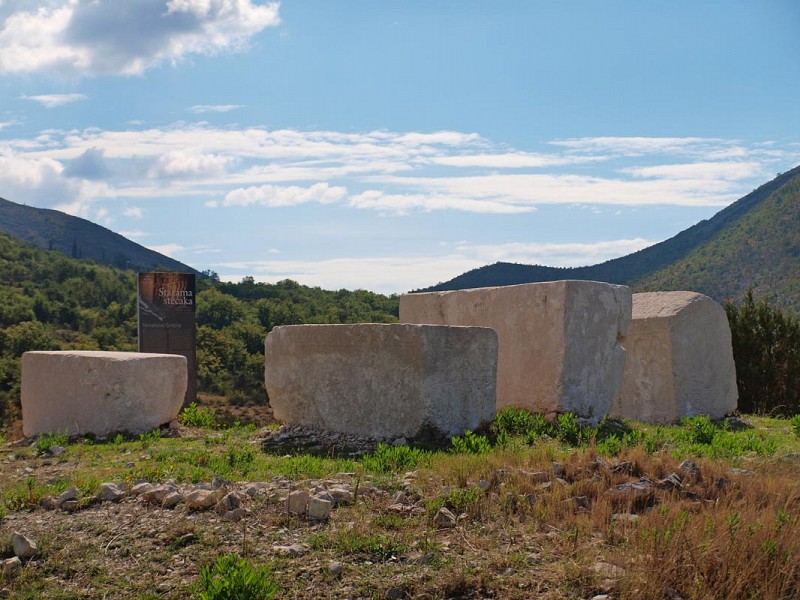
Step back to history
This historical walking path connects the villages of southernmost Croatian territory, Konavle valley and the island of Korčula, and the path is rich with stories and facts from the turbulent history of these areas. While doing the path, the traveller is getting introduced to Austro hungarian…

Split to Dubrovnik biking - Self guided - 7 days
The cycling tour from Split to Dubrovnik is a tour on which you will get to explore several historical cities and islands: Split, Hvar, Korčula, Ston and Dubrovnik. These cities and islands are centuries old, and even the old Romans and Greeks knew that this part of the world is unique…
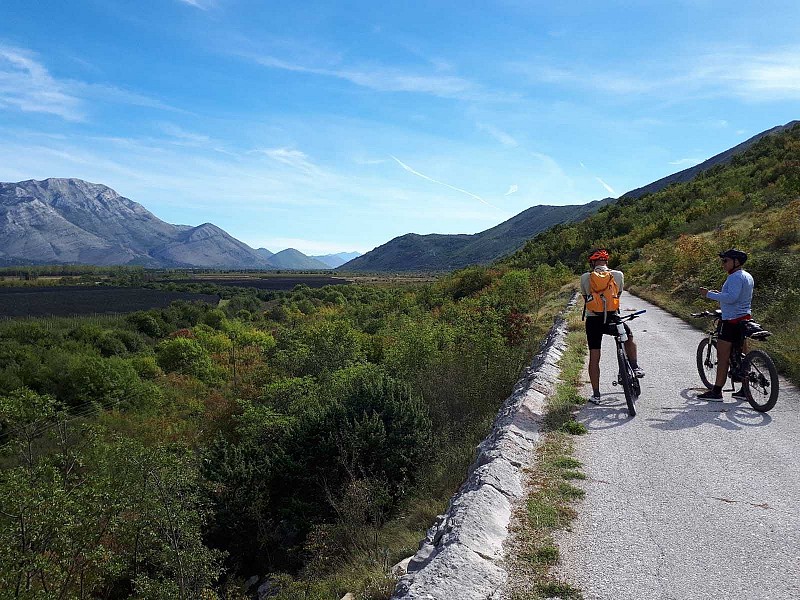
Ciro bike route - Self guided - 7 days
The Ćiro trail is a bike route from Dubrovnik in the south of Croatia to Mostar in Bosnia and Herzegovina. This cycling route follows an original steam locomotive railway which was built in 1903 during the Austro-Hungarian Empire and closed in 1976. In November 2017 it was re-opened…
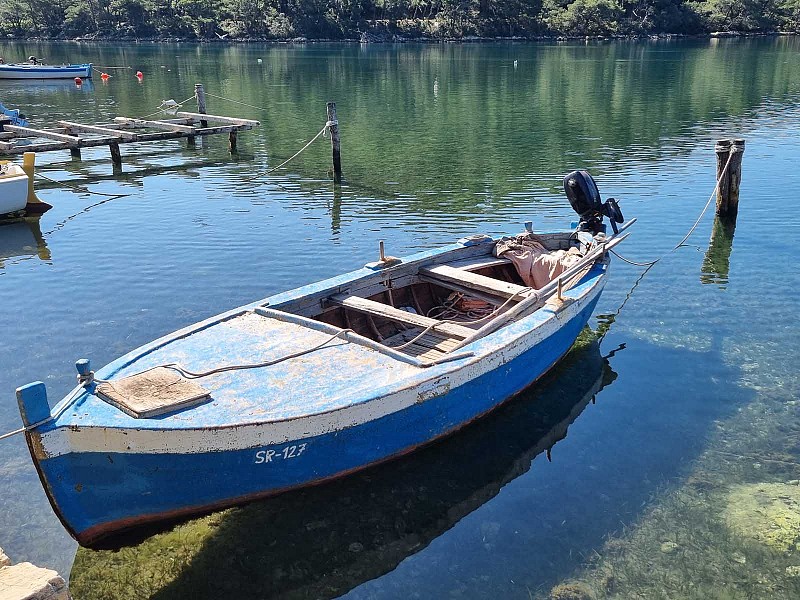
Adriatic islands hopping - Self guided - 8 days
This self-guided walking tour is a combination of walking and cultural sightseeing, a tour includes Dubrovnik, a UNESCO World Heritage site, the island of Lopud, the island of Korcula and beautiful bays of Lumbarda, the island of Mljet a national park with its saltwater lakes and the ruins of the…
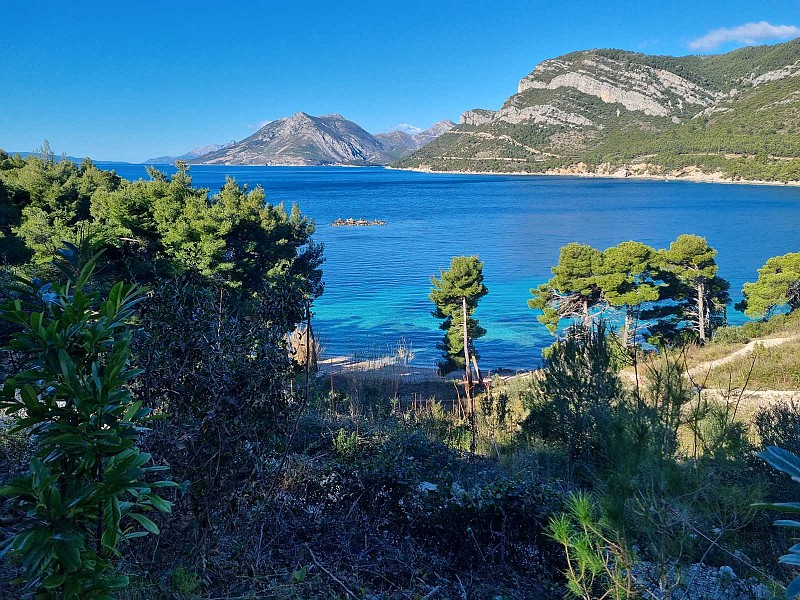
Adriatic Hiking Adventure - self guided walking tour
This tour includes the island of Korcula (birth place of famous merchant, explorer and adventurer Marco Polo), the island of Mljet with its sea lakes and National park, the stunning island of Hvar with lavender fields and beautiful coast and the historical town of Dubrovnik.
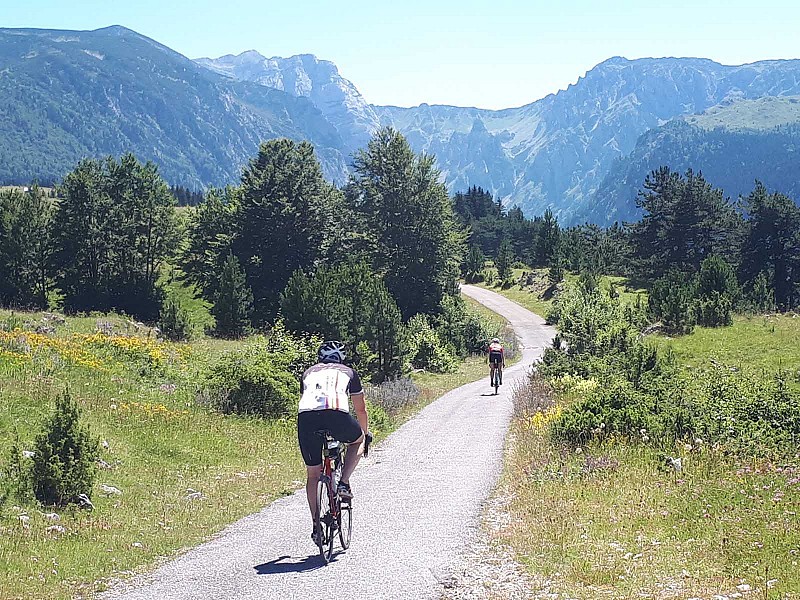
Cycling west Balkan triangle - Self guided - 8 days
The cycling tour of the west Balkan triangle is a cycling tour designed for small groups of cyclists and independent travellers. This tour takes place in 3 different countries: Croatia, Bosnia and Herzegovina and Montenegro. For the…

Wine roads of Dubrovnik
This tour combines walking activities in the Dubrovnik area and wine tasting in the famous cellars of the Pelješac peninsula and the area of Konavle in the vicinity of Dubrovnik. The duration of this self-guided and guided tour is 8 days (7 nights). It is designed for small groups and…

Explore the Balkans - Guided multi sport tour - 8 days
Explore the natural, cultural and historical attractions of the 3 neighbouring countries through multisport activities: hiking in the mountains of the Dubrovnik countryside, biking along the picturesque bays of Montenegro and the formal railroad route through Bosnia, paddling down the green…
Send Inquiry
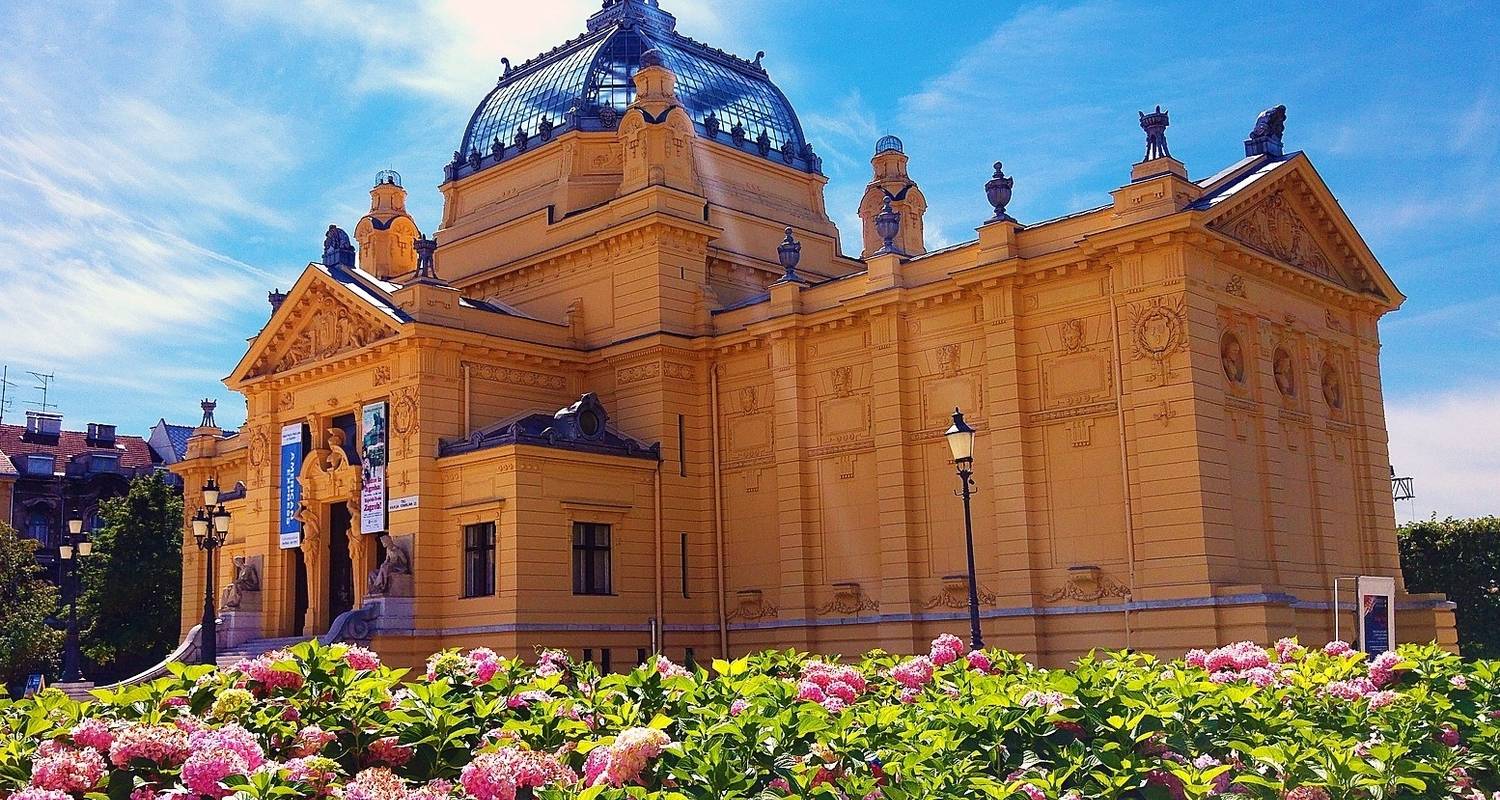
Croatia Guided Tours & Trips
- Choose from 300+ Croatia tours
- 2,200+ verified reviews from TourRadar travelers
- 24/7 customer support
10 best fully guided Croatia tour packages
Compiled by

Melissa Croatia travel expert at TourRadar
Croatia Sailing Adventure
Sailing croatia - split to dubrovnik, cycle the dalmatian coast, zagreb to dubrovnik: parties & plitvice lakes, explore croatia, croatian islands cruise + land tour with plitvice - from zagreb, croatia sail - split to split (the dalmatian voyager), croatian highlights private tour from zagreb to dubrovnik, croatia island hopping, 15 days, 5-day dubrovnik to split one-way cruise - classic plus above-deck, 18-35s.
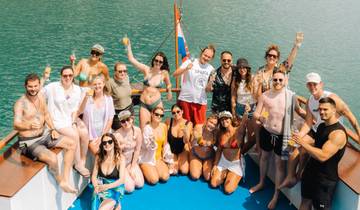
- Island Hopping
- Walk the ancient walls of Dubrovnik
- Hike to Hvar's Spanish Fortress for views
- Taste local wines in charming Korcula
“The tour was absolutely amazing! We saw so many nice things, the group was everything.”
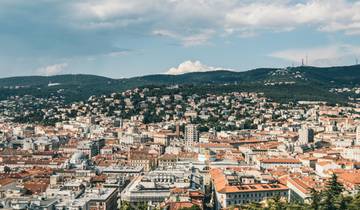
- Discover Dubrovnik's historic sites
- Explore ancient ruins and hidden beaches
- Enjoy vibrant nightlife in Hvar
“I learned a lot about sailing and Croatia on this trip.”

- Road Cycling
- Soak in the beautiful coastal views
- Explore the city of Split and Dubrovnik
- Bike the quiet roads of Hvar and Korcula islands
“The views, the places we visited on our cycle tour, the scenery were amazing.”

- In-depth Cultural
- Relax on Hvar's scenic beaches
- Party at East/West Beach Club in Dubrovnik
- Hike through Plitvice Lakes National Park
“It was a great experience, made even more special by my tour guide Magda. She went above and beyond for everyone.”
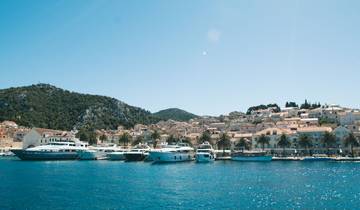
- Sightseeing
- Swim the clear waters of Korcula Island
- Walk the streets of "King's Landing"
- Enjoy traditional Dalmatian meat loaf
“Croatia was extremely passionate and informative.”
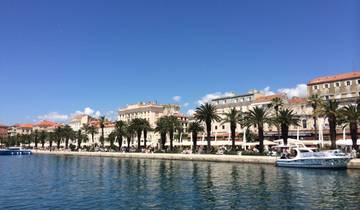
- Cruise along Dalmatian coastline and enjoy the scenery
- Stroll the streets of Dubrovnik - the Pearl of the Adriatic
- Soak up the sun, go for a swim and taste local delicacies
“The land tour part was great and went without a hitch, the cruise part not so much.”
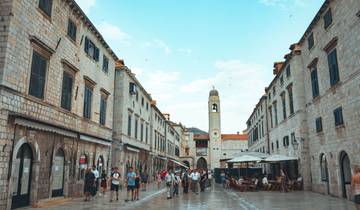
- Explore Dubrovnik’s “King’s Landing”
- Indulge in local delicacies and nightlife
- Cruise the blue Adriatic seas
“The trip itself balanced exploring beautiful parts of Croatia with a few nights of drinking.”

- Tour the cascading Plitvice Lakes
- Explore Zagreb's historic Upper Town
- See Dubrovnik's old Franciscan Monastery
“This trip was phenomenal! It was the perfect start to our honeymoon and we can't wait to return!”
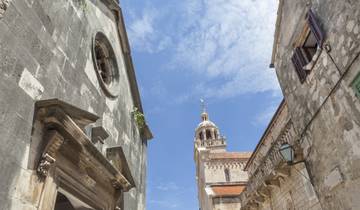
- Discover Hvar's rich history and culture
- Hike to Vidova Gora for stunning views
- Taste local wines and olive oils
“Accommodation was also good value and comfortable. Woynot hesitate to recommend this trip to others.”
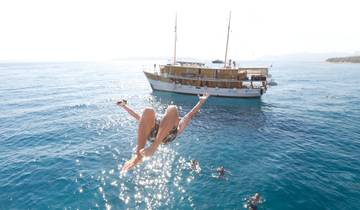
- Bond with the group over dinner in Dubrovnik
- Visit the ancient Diocletian's Palace in Split
- Cool off with a swim stop in the Ocean
“The food (lunch) was surprisingly good. I 100% recommend this tour and will definitely do another sail with them.”
Regions in Croatia
Discover TourRadar

Martha’s Vineyard Was Once a Haven for the Deaf. I Took a Trip to Find Out If It Still Is.
In the 1800s, so many residents of martha’s vineyard were deaf that they created their own sign language. as a deaf traveler, i took a road trip to see how visitors can experience that legacy today..
- Copy Link copied

Martha’s Vineyard gained a reputation as a haven for deaf people in the 18th and early 19th centuries.
Photo by Rolf_52/Shutterstock
A few days before I went to Martha’s Vineyard, my hearing aids broke. As a deaf person who primarily uses American Sign Language (ASL), my hearing aids provide information about whether sound is present, though not always what it means. But lately I’ve come to rely on them most for the visual reminder of deafness that they give to hearing people. Without them, hearing people often assume I’m “ignoring” them, and most blow past patience or curiosity straight to anger. I’ve been shouted at in stores for not responding to a clerk’s call, shoved on a sidewalk for not responding fast enough to someone’s excuse me, assaulted on a subway platform after missing a man’s attempted flirtation.
So it was with both unease and excitement I set off on my trip without the aids.
On the one hand, traveling deaf and alone to a place I’ve never been has some inherent risks. On the other hand, it was early May, and the trip was a welcome respite from a semester’s worth of teaching, book edits, and two small boys at home. Part of me has always liked solo travel , how it allows me to engage with a new place in my natural state of silence. And in this case, it felt particularly apt—I was about to put Martha’s Vineyard’s storied past as a haven for the deaf to the test.
Before I left, I read just about everything available on the island’s deaf history, from the most famous—Nora Groce’s 1985 book Everyone Here Spoke Sign Language — to dissertations and academic publications by deaf and signing historians. I pored over maps, travel websites, train and ferry schedules, plotting out the journey from Philadelphia to the Vineyard. Before I had children, I reveled in the “getting there” part of travel, taking a long train to Montreal , or driving an unplanned route up through Newfoundland . But now I had just three days before the responsibilities of work and childcare would pull me back home. I rented a car, filled a backpack with clothes and a tote bag with notebooks, dropped the boys at school, and headed north.
A history cherished by a few but unknown to many

Katie West was the last “native speaker” of Martha’s Vineyard Sign Language. She died in 1952, and her house is now part of the Chilmark Free Public Library.
Courtesy of the Martha’s Vineyard Museum
The history of sign language on Martha’s Vineyard was traditionally understood to be as follows: In the late 1600s, a deaf man named Jonathan Lambert and his family were part of a group of Massachusetts Bay colonists who left the mainland for Martha’s Vineyard. Historians have theorized that this relative isolation proliferated a hereditary deafness over the next two centuries, a scenario that peaked in the 1850s when an estimated 1 in 155 on the island, and 1 in 25 in the village of Chilmark, were deaf, compared to only 1 in about 5,700 on the mainland.
As a result, a unique language known as Chilmark Sign or Martha’s Vineyard Sign Language (MVSL) developed and was used by deaf and hearing islanders alike. MVSL allowed for the full integration of deaf people into the island’s work, social, and religious spaces without prejudice. Deaf islanders were fishermen, farmers, and business owners; Jared Mayhew, a deaf landowner, founded the island’s first bank . The Martha’s Vineyard deaf community thrived this way until more expedient transport and the establishment of a deaf residential school in Hartford, Connecticut, in 1817 drew new settlers to the island and deaf islanders to the mainland, subsuming MVSL and diluting “distinctive” genes. This image of the Vineyard as a signing utopia for deaf people was later ensconced in the hearing anthropologist Nora Groce’s book.
However, the truth is more complicated—as it always is. Groce’s work occurred more than a century after the deaf community was gone and MVSL was swallowed up by the ASL we sign today. Groce’s theories about the genetic and linguistic roots of hereditary deafness and about MVSL being from Kent, England, have been all but ruled out by deaf historians in the United Kingdom . In recording family trees on the Vineyard, Groce hadn’t differentiated between genetic deafness versus acquired deafness; this, along with anonymizing name changes in the book make it difficult to retrace the links between families today. More recent analyses of island genealogy, marriage, and migration patterns suggest that the island’s deaf community started later and was connected to the Hartford deaf world and to ASL earlier than previously thought.
A unique language known as Chilmark Sign or Martha’s Vineyard Sign Language (MVSL) developed and was used by deaf and hearing islanders alike.
What remains is this: For several generations, a proportionally large population of deaf people lived on Martha’s Vineyard, using a signed language with distinctive vocabulary and grammatical features, including a two-handed alphabet. It was likely created organically by deaf islanders , rather than imported.
That everyone on Martha’s Vineyard spoke sign language is unlikely. Perhaps most of Chilmark did, but given the average family size at the time, most folks in Chilmark would have had a deaf person in their household. The phenomenon of village-wide sign vocabulary in areas with multiple large, deaf families has been observed elsewhere, including in Lantz Mill, Virginia, in the same period, and around the world into the present day.
Still, the watery boundaries of the Vineyard would mean that even if they weren’t fluent signers, hearing islanders’ frequent interactions with deaf people would leave little room for ableism. Unlike the way deafness often marks us as “lesser” in today’s society, hearing islanders interviewed by Groce respected their deaf neighbors and thought of their deafness as secondary to their personalities and skills. In a 19th-century fishing economy, knowing at least a few signs would have been advantageous for communicating between boats and the shore, when the only alternative was shouting into the howling wind.
Although Martha’s Vineyard-as-deaf-paradise is at least part fantasy, it’s hard to let go of a good myth. In the USA now, only about 8 percent of parents with deaf children ever learn enough ASL to have a conversation with their child—we’re a bit starved for utopia, and Martha’s Vineyard is about as close to an ancestral homeland as we can get.
With the legend in my heart and the wind of my ancestors-in-spirit at my back, I stood on the deck of a Steamship Authority’s ferry traveling between Falmouth, Massachusetts, and the island’s ferry port Vineyard Haven on a gray afternoon. Within minutes of departure, the Island Home was enveloped in a fog so dense I could no longer see anything in front of me. It was cold, and I wondered what could possibly have possessed the Massachusetts Bay settlers, or the Wampanoag before them, to row into this thick unknown.

In the 1850s, 1 in 25 residents in the village of Chilmark were deaf, compared to only 1 in about 5,700 on the mainland.
Courtesy of Visit Massachusetts
Following the island’s deaf-history tour
We landed in Vineyard Haven about 40 minutes later. I drove to Edgartown, where I’d be staying at the boutique Faraway (see How to take this trip, below), so I could ditch the car. I wandered the town with a pleasant mindlessness, eating fudge and window-shopping fancy island clothing and debating which ice cream shop looked best. I examined the town’s wood-shingled buildings and bright white churches, read each of the many plaques and signs affixed to historical buildings of note, haunted Edgartown Books. I spent a long time loitering dockside, taking in the salt and sparkle of the harbor.
I ate dinner and turned in early. I’d centered my trip around the Martha’s Vineyard Chamber of Commerce’s driving tour map of key historical deaf community sites , and I planned to make all 10 stops the next day. From my hotel balcony, I watched the sun set and the fog roll back in. Beneath me, the firepits by the pool were ignited in neat rows, as signal fires must have been lit upon these shores many centuries ago. I went to sleep with a feeling of anticipation, as if I hadn’t quite yet arrived.
The driving tour map is relatively new; while Vineyard deaf history has long been held dear by the deaf community, it was often overlooked by the general public until recently.
In the morning, I returned to my car, clutching my map and feeling flush with exploratory spirit. The map is relatively new; while Vineyard deaf history has long been held dear by the deaf community, it was often overlooked by the general public until recently. A resurgence of attention is in part thanks to the efforts of islander Lynn Thorp, who, after reading Groce’s book, couldn’t stop thinking about the benefits signed language might bring to the lives of her hard-of-hearing husband and friends. Wanting to make ASL resources more accessible on-island, she spent more than a decade facilitating the airing of mini-lessons on public access TV and burning DVDs for the island libraries. In 2020, her focus shifted to publicizing the island’s history for visitors, partnering with the Chamber of Commerce to add deaf-centric materials to the Chamber’s website, including the driving map.
Cell service was good, but Google often didn’t differentiate between private and public roads, so U-turns were also plentiful. I started in Vineyard Haven and toured the Martha’s Vineyard Museum ($18 for off-islanders, closed Mondays). In the 2023 season, the museum’s temporary exhibition, They Were Heard , spotlighted the island’s deaf life, but most of it has been packed away and returned to the archives.
“If a tour group wants to see some of the artifacts , I can arrange a special viewing here in the library,” said museum historian Bow Van Riper, who spearheaded research for the exhibit. He suggested that groups contact the museum a few weeks in advance to make a request.

In 1926, American artist Thomas Hart Benton painted this portrait of his deaf neighbor Josie West.
Courtesy of Martha’s Vineyard Museum
Visitors traveling alone or without notice can view two pieces of Vineyard deaf history in the permanent collection: the transcript of an interview with Mildred Huntington, a hearing woman who’d been babysat by a deaf islander (they can also listen to the audio), and a 1926 painting by noted American artist Thomas Hart Benton of his deaf neighbor, a Chilmark farmer named Josie West .
After the museum, I headed on to West Tisbury, to the cove where the Lambert family settled. A winsome mix of forested area and sand beach, Lambert’s Cove was the tour stop that felt closest to a traditional New England beach vacation and one of the few places I ran into fellow travelers—some hiking, some early beachgoers splayed out on towels near the water. Ocean views and dogs playing fetch in the surf were both charming and familiar, making it difficult to imagine what it might have been like when the Lamberts first arrived. I moved on, cut in-island toward tour stops 4 through 10, in Chilmark.
Inland, I found myself overwhelmed by the breadth of farmland—expansive, lush, and often still delineated by centuries-old fieldstone walls. As I marveled, I considered the privilege of preservation. My own understanding of island life was shaped by the extreme poles that made up beaches of my childhood: the Jersey Shore and the rural Croatian coastline. In New Jersey, every inch of the bustling shore is spoken for and cultivated to turn a profit. In Croatia, I stayed with family in a rural fishing village’s postwar quiet, sans shops or telecommunications, the extremely beautiful seascape neither preserved nor cultivated.

At least 28 members of the Chilmark deaf community are buried at Abel’s Hill Cemetery in Chilmark.
Photo by Sara Novic
The Vineyard’s vast farms, stables, and the willingness to leave some wooded spaces totally undeveloped likely speak to inherited wealth that endows the owner beyond a need to capitalize on summer tourism. And yet, I couldn’t help but notice the island’s deaf history is preserved only in fits and starts. At Abel’s Hill Cemetery, where at least 28 members of the Chilmark deaf community are buried, there is no map for locating figures of historical significance. At Lambert’s Cove, Squibnocket beach, and Menemsha harbor, there’s no information detailing the birth of MVSL thought to have come in the wake of Lambert and other deaf fishermen.
Perhaps unsurprisingly, the heart of the island’s deaf history resides at the Chilmark library . Ebba Hierta, the library director, was kind enough to sit with me without notice and explain the library’s history and connection to what she called “the deaf ancestors.” The ties were both figurative and literal—one of the library’s rooms had been the home of a prominent deaf couple, Benjamin and Katie West. Benjamin was a lifelong islander, and Katie was originally from Rhode island and married into the island culture. Katie, who died in the early 1950s, is believed to have been the last fluent signer of MVSL . The Wests’ house was purchased by the town and became the Chilmark library. Several additions later, the original room now holds a small shrine of printouts and a DVD recording (notably without subtitles) about MVSL and the Chilmark deaf. The library’s website also features additional resources , including a teaching guide and recorded presentation about deaf history, with ASL interpretation.

A mural in the Chilmark Library shows two children reading a book about sign language.
Photo by Ebba Hierta
“We see a lot of visitors [at the library] in the summer, many of whom are deaf, but not all,” Hierta said. Among islanders, library and museum programming has increased awareness about the historic deaf community, too. “I wish we could do more,” she said, “but it’s hard without a big research staff and budget.” The library requests that visitors wishing to speak with the librarian schedule an appointment at least a week in advance, particularly in peak season. On my way out, Hierta brought me to the children’s section, where high on the wall, a mural depicted children in an attic play space with a sign language book, one signing the letter “L”—a static portion of the sign for “library”—frozen in time.
Nearing the end of the tour out on Squibnocket Beach, I grew wistful. Likely used as a launch for deaf fishermen, I thought of how the shore, now empty, might have looked dotted with boats and nets and the flurry of sign language. The views were breathtaking, the bluffs making it easy to contemplate the end of things. Today deaf culture is under increasing threat, as doctors seek to eradicate deafness with gene therapy and stem cell therapies. As I looked at a crystalline horizon, I wondered if the deaf community here had felt that same existential threat as the years passed and their numbers dwindled, or if their hearing neighbors’ knowledge of sign language helped allay their fears.

Squibnocket Beach is a stop on the island’s deaf history driving tour. It was used as a launch by fishermen in the 18th and 19th centuries; many were likely deaf.
Photo by flyben24/Shutterstock
The future of deaf-history tourism on Martha’s Vineyard
While glimpses of Vineyard deaf history are plentiful if you know where to look, real access to cultural information requires a fair amount of advanced preparation (and an internet connection).
I hope efforts to commemorate this rich history will continue, particularly in incidental ways like plaques or materials a tourist or passerby might encounter on their own, just as deaf and hearing Vineyarders were once in casual contact with one another in their daily lives.
More of that may be on the horizon. On Hierta’s recommendation, I spoke to the leader of Clemson University’s Martha’s Vineyard Sign Language Project , which aims to serve residents, merchants, and tourists alike. Jody Cripps, assistant professor of American Sign Language in the Department of Languages, said the team had a broad scope of preservation, research, and development and is working with islanders to decide how best to commemorate, memorialize, and share information. “We did think about plaques,” said Cripps, “but we want to ensure that we’re not simply catering to busloads of tourists. We also want to be respectful of people for whom Chilmark is home.”
Cripps noted that the team was at work on a cemetery map with the locations of historic deaf community members’ graves, which he ultimately hoped could be a document people could pick up at the library. But the process of locating graves is difficult, and he wasn’t sure when it would be ready.
While deafness is no longer central to Vineyard culture, its spiritual inheritance is still prominent.
In the meantime, while deafness is no longer central to Vineyard culture, its spiritual inheritance is still prominent. Often when I travel, I meet strangers who panic in the face of deafness, but for a few days on Martha’s Vineyard, no one batted an eye. A variety of folks across the island—from the concierge, to a librarian, to Steamship Authority terminal workers—were amenable switching to writing when necessary. Servers at Espresso Love and Atlantic collected my order via pointing at the menu without any angst. A cashier at Rosewater Market gestured so fluidly I was the one taken aback by our exchange. The Faraway hotel’s general manager knew the manual alphabet, spelling out some simple words when we crossed paths; a parking attendant signed “thank you” as I paid my way out.
Maybe these moments of ease were thanks to islanders’ increased exposure to their history through community programming spearheaded by libraries and folks like Thorp. Maybe a tourist economy has conditioned people to be polite, both to deaf groups who’ve made pilgrimages to Chilmark and across various language barriers. Maybe it was all coincidence. Or maybe it was something in me, that I approached each interaction a little more confidently, buoyed by the knowledge that standing on the land of our deaf ancestors, part of me belonged there.
On Martha’s Vineyard, nobody spoke sign, exactly, but no one found me strange, either. And whether or not the bulk of hearing islanders really knew MVSL centuries ago, I think it was the ability for the deaf to live without stigma that made the place most special; in this way, its legacy remains.
How to do this trip

The Faraway hotel’s general manager knew the manual alphabet.
Photo by Matt Kisiday
Where to stay: My home base was Faraway , a boutique hotel in Edgartown that fastidiously strikes the balance between historic charm and luxury amenities, an aesthetic that I’d come to understand as a trademark of Vineyard tourism. My room, an outbuilding studio suite, offered a showstopping view of the bay and Chappaquiddick Island. Faraway has a restaurant and an expansive pool and patio with food service, but its location at the edge of Edgartown’s main drag of shops and restaurants is arguably its greatest asset. In the opposite direction, it’s about 15 minutes on foot to a sandy public beach and the Edgartown lighthouse.
The tour: The deaf history driving tour is self-guided and can be accessed online via the Martha’s Vineyard Chamber of Commerce website or downloaded as a PDF brochure . The Chilmark Library has a resource page of more background and videos.
Getting around: If I were visiting Martha’s Vineyard solely for a beach getaway, Faraway, Edgartown, and traveling by bicycle and public shuttle could easily be enough to sustain the trip. Having a car on island—either via rental or ferry —requires significant advanced planning for reservations during peak season. (In contrast, walk-on ferry passengers can buy a same-day ticket.) But accessing the full range of the island’s deaf heritage would be difficult without a car.


IMAGES
COMMENTS
10 best Self-Guided Croatia tour packages. Compiled by. Melissa Croatia travel expert at TourRadar. Best of Croatia 11 Days, Self-Drive. Croatia Island Hop & Stop - 8 days. Bike Dalmatian Islands - Mountain Bike Trans Croatia South. Croatia Islands Cycling Holiday. Croatia Island Hopping, 11 Days.
Best of Croatia: Zagreb, Rovinj, Šibenik, Hvar, & Dubrovnik - 12 Days. This thorough 12-day self-guided tour covers Croatia's best, from cultural stops in Venetian-infused cities to the exploration of ancient Roman ruins. Explore medieval hilltop towns, lively markets, historic fortressed cities, and glittering salt pans.
Welcome to Walking Holidays Croatia, your trusted companion in crafting unforgettable self-guided walking tours in this beautiful country, perched on the east side of the Adriatic Sea. Our mission is to help you uncover the hidden gems of Croatia, a country renowned for its diverse Mediterranean landscapes, rich history, and vibrant culture. ...
Croatia - Cycling Tour of Coast & Islands. Start in Split & finish in Dubrovnik. This 8 day self guided cycling tour of Croatia's hits all of the top spots: Split, Dubrovnik, Brac, Hvar, and Korcula. Choice of lodging 3-5 star lodging; a guided version also available. This is our longest running & top selling bike tour in Croatia.
The dazzling Adriatic Coast, the greenery of Istria and the island hopping are only few of the reasons why many lovers of self-guided hiking tours visit Croatia. Secluded beaches, excellent seafood and wines attract independent hikers year round.
10 best road trips in Croatia. Compiled by. Melissa Croatia travel expert at TourRadar. Croatia Express, Self-Drive. Best of Croatia 11 Days, Self-Drive. Dalmatian Coastline, Self-Drive. Grand tour of Croatia 8 Days, Self-Drive. UNESCO Heritage, Self-Drive. Explore Istria and Dalmatia in 8 Days, Self-Drive.
The best self-guided and independent tours in Croatia. We currently offer 45+ Croatia tours and trips that are self-guided with varying trip durations from 3 to 15 days. Self-guided and independent tours can be a great way to discover Croatia although potential risks associated with not having a guide always needs to be considered.
16. Rijeka Self Guided Sherlock Holmes Murder Mystery Game. Explore the city at your own pace while playing the Sherlock Holmes City Game, a self-guided tour that offers a lot of freedom…. 17. Dubrovnik Boat Rental: Maestral 500, Brand NEW Yamaha 115 hp. Experience Dubrovnik in a very special way.
The best Self-guided Tours in Croatia according to Viator travelers are: Dubrovnik Self-Drive Boat Rental for up to 6 People; 2-Hour Dubrovnik Fun and Exciting Jet Ski Safari Adventure Tour; Jet Ski Rent 1h; Vespa Scooter Rental in Dubrovnik; Rent a small boat without skipper - explore the islands and find hidden caves
SELF-GUIDED HIKING TOUR IN CROATIA OVERVIEW. Hike along the Dalmatian Coast in Croatia on our 8-day self-guided hiking tour from Split to Dubrovnik. You'll visit some of Croatia's most historic city centers, including Split and Dubrovnik, plus destinations such as Hvar and Korcula ...
Welcome to Croatia! Azure, cobalt, indigo — our 8-day self-guided Croatia hiking tour is a celebration of blue skies and pristine waters. The villages are immaculate and the bustle of the beaches and exceptional restaurants, enchanting. The red tiled roofs coupled with the crystal clear sea is pure magic.
The Split, Croatia Old Town is an enchanting web of cobblestone streets that encompasses both Diocletian's Palace and the adjacent Old City. The picturesque lanes of Split, Croatia lead to historic sights, charming squares and hidden gems. Our Split Walking Tour is an easy-to-follow self-guided walk that features 30 highlights of the ancient ...
Our most popular three Croatia bike tours are: Self guided bike tour from Trieste to Pula: with a choice of cycling on gravel or asphalted roads. Self guided cycling Istrian wine roads tour - the easiest self guided cycling tour in our Croatia offer, distances are around 30-45 km mostly on flat and easy hills.
Tour Inclusions. Enjoy the 7-day self-guided tour in Croatia with a comprehensive package of inclusions designed to enhance your travel experience. Enjoy the convenience of having accommodation, entrance fees, ferries, itinerary booklet, route guide, full support, and breakfast for all six days covered in your tour.
Tim, Canada. We will help you organize a trip around Croatia. We will design the best itinerary according to your wishes, time limit, accommodation preferences, duration and budget. We will equip you with all the necessary logistics: maps, instructions and lots of tips. Self-guided tours are a perfect way to spend holidays with your beloved one.
Day 7: UČKA - LOVRAN (5hrs, 15km, +780m/-1690m) (shorter option: 2hrs, 6km, +30m/-390m) Today's self-guided hiking route begins with a morning transfer to a peculiar saddle between two hills called Poklon where the starting point of the trail is located. You will hike the highest summit of Istria and the Učka mountain (1401 m) where ...
Top Croatia Self-Guided Tours & Rentals: See reviews and photos of Self-Guided Tours & Rentals in Croatia, Europe on Tripadvisor.
The self guided tour will take you a full day if you also visit the beaches. Use the map and attractions guide to visit the attractions of Old Town Dubrovnik and the locations of the Games of Thrones Scenes. The map has picture of the sites and how they looked for the film scenes. The walking tour will take you ½ a day.
Self-Guided With our Self-Guided tours an expert local guide takes care of your transfers, route briefing, luggage moves, and planned transfers. They are also available should you need mechanical assistance, help with a dinner reservation, or general questions. ... Our Croatia Bike Tours. The Istrian Peninsula is the largest peninsula in the ...
Self-guided. Walk the islands close to Dubrovnik in Croatia over one island to another and from one village to another away from the crowds. Plus a tour of Dubrovnik and walking in Konavle. Self-guided 8 Days From $2595 Easy. View Walk.
Slow food Croatia - Guided foodie tour - 9 days. Slow food Croatia is a unique tour in Croatia that includes food and wine experiences, historical and cultural tours and a few hiking adventures. This tour takes us to different historical locations along the Dalmatian coast, from ancient Split and the historical town of Trogir which is included…
Tour Dates: April through October 2023 Price: €1,060 per person This Self Guided Croatia Bike tour allows you stay in Split each night, and cycle on Adriatic Islands each day. No need for luggage transfers or changing hotels! This tour features the most beautiful areas along the Croatian coast with quiet roads, ancient villages, lavender fields and UNESCO World Heritage sites.
10 best fully guided Croatia tour packages. Compiled by. Melissa Croatia travel expert at TourRadar. Croatia Sailing Adventure. Sailing Croatia - Split to Dubrovnik. Zagreb to Dubrovnik: Parties & Plitvice Lakes. Classic Croatia: 6 Days Capital to Coast. Cycle the Dalmatian Coast. PRIVATE - Classic Croatia.
A deaf traveler takes a self-guided driving tour that highlights Martha's Vineyard's unique sign language and historic deaf community. ... every inch of the bustling shore is spoken for and cultivated to turn a profit. In Croatia, I stayed with family in a rural fishing village's postwar quiet, sans shops or telecommunications, the extremely ...